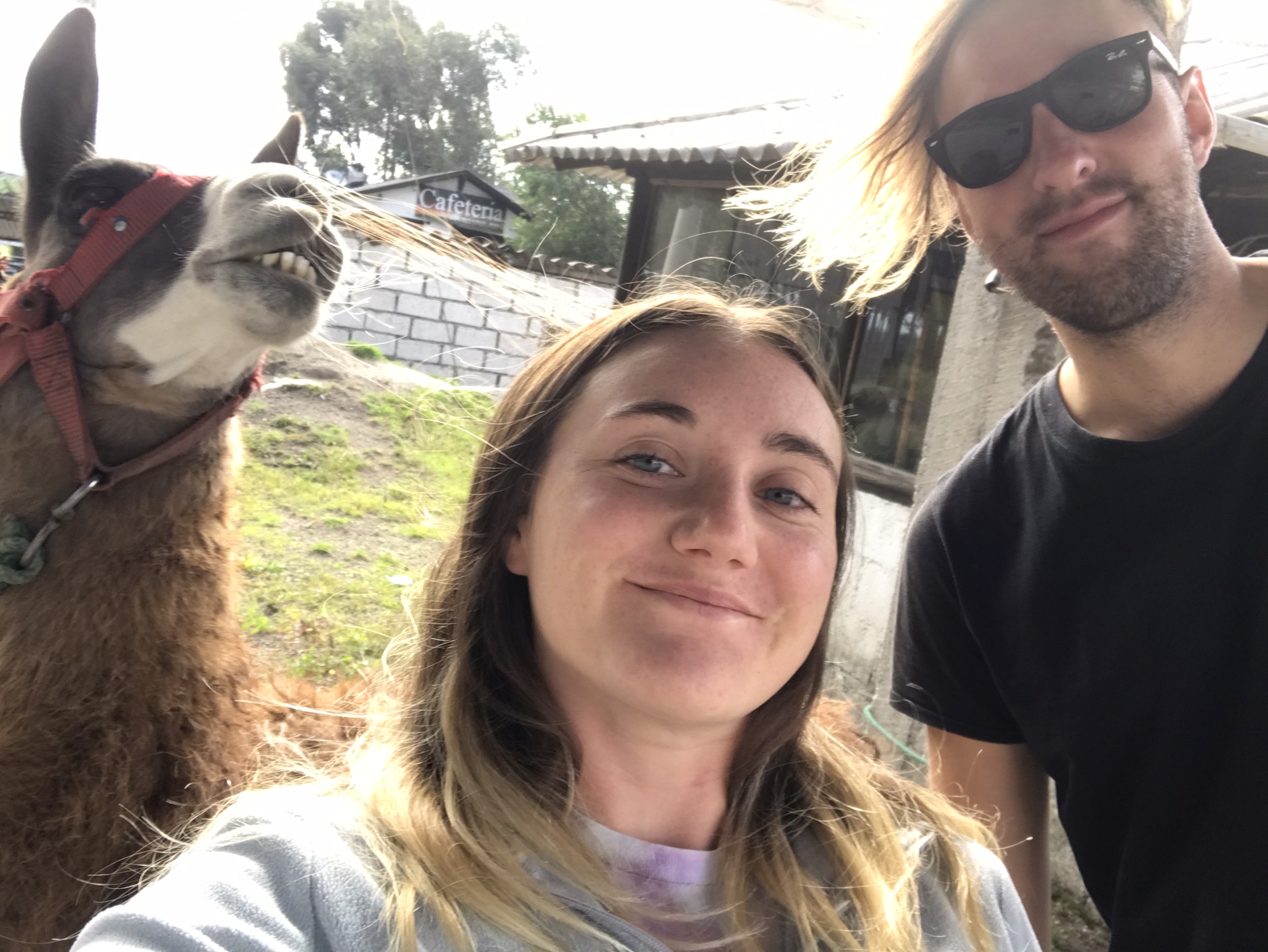Tunisia travel wasn’t our first choice; I’m almost embarrassed to admit now that when Dan mentioned the possibility of traveling around Tunisia, I asked ‘what’s even there?’
Now I can tell you exactly what’s there 🙂
Expect beautiful Santorini-eque Sidi Bou Said, Balamory-style painted houses in Bizerte, white sandy beaches in Sousse and Djerba, bustling Medinas, fantastic Roman ruins at Carthage, Bulla Regia & Dougga, the second largest amphitheatre in the Roman world at El Jem, the one and only Sahara Desert, amazing Berber culture, Troglodyte underground cave dwellings and abandoned Ksars, Star Wars filming locations, date palm oases in the desert and the fantastic Bardo and Sousse Archeological Museums crammed with enormous, mostly-intact mosaics. Tunisia is a varied country with so much to see and do, sadly most visitors seem to confine themselves to the cheap all-inclusive beach resorts and hotel complexes and don’t really get to experience what is on offer.
Tunis, Sidi Bou Said, Carthage, Dougga, Kerkouane, Bulla Regia, Bizerte, Sousse, Kairouan, El Jem, Monastir, Sfax, Tataouine, Ksar Ouled Soltane, Chenini & Douiret, Djerba, Toujane, Matmata, Douz, Tozeur
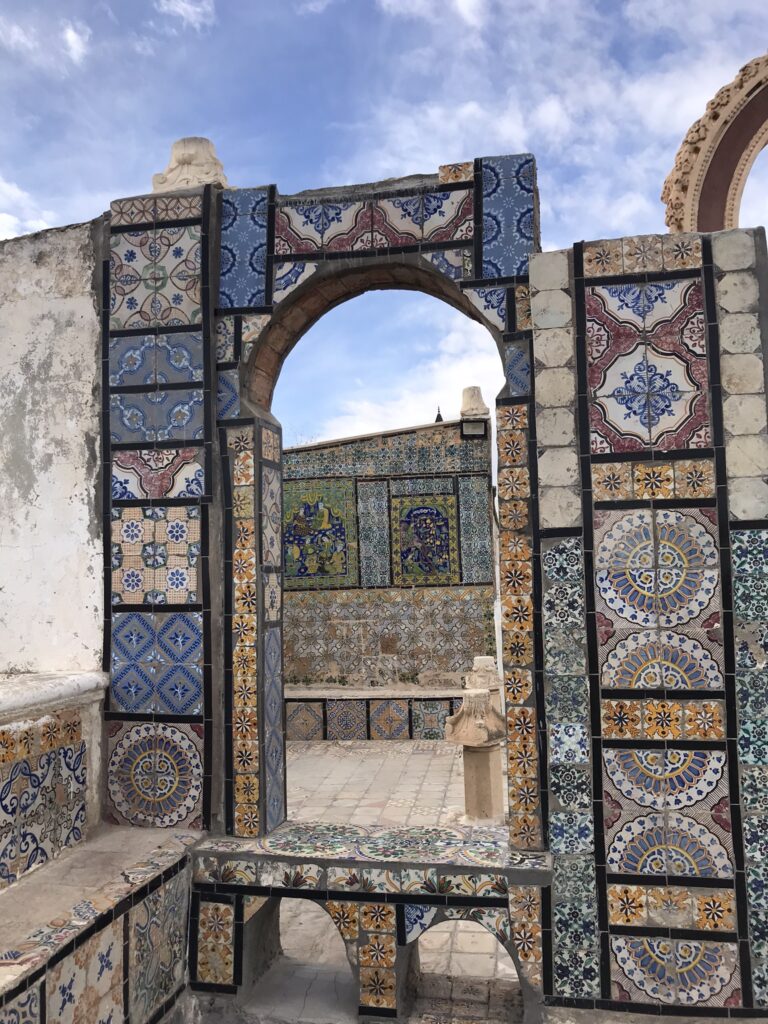
Leave the resort, or even better just don’t stay in an all-inclusive resort if you want to experience the real Tunisia. We tried the all-inclusive lifestyle in both Sousse and Djerba when we needed a few days to relax and I can honestly say that whilst it was very convenient and relaxing having all the amenities you could wish for right at your doorstep like the beach, swimming pool, gym and all-you–can eat buffet, we quickly got tired of doing nothing constructive and stuffing ourselves silly with European food. We also found it hard to leave these resorts to visit sites such as Sousse Medina or Djerbahood as the resort complexes are usually not in a central location but located out of town, which makes traveling independently more tricky. Leaving the resort for any length of time also meant missing the included meals and so having to buy more food, not great if on a tight budget! However, I totally understand people who just want to lay by the pool with a book; in that case Sousse, Djerba and Hammamet are the places you should stick to.
For the others, here’s a brief summary of my experiences, recommendations and everything I learned during my time independently exploring and traveling around Tunisia:
Advice
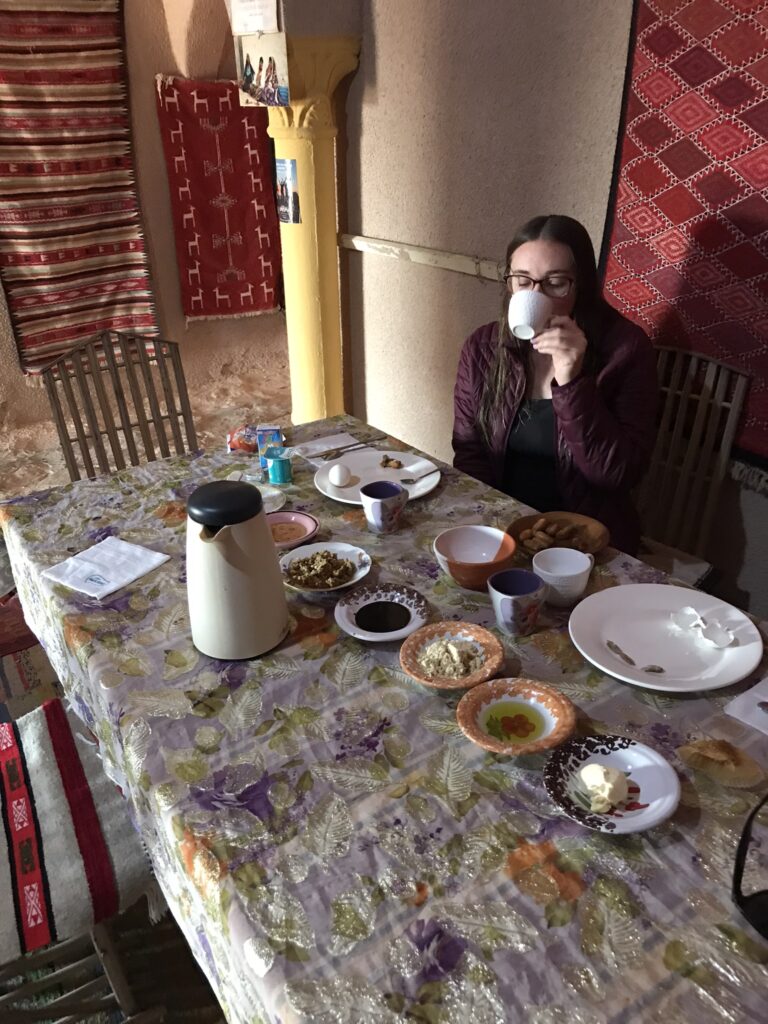
Toujane was about as far removed as you can get from the beach resorts of Sousse and Djerba
For ladies, it is beneficial to cover your arms and legs when walking about in public, I recommend this for pretty much the whole of Tunisia outside of the resort areas. Although this isn’t a must in more metropolitan areas such as Sidi Bou Said and the resort towns, by dressing conservatively you draw less attention to yourself. Of course, if you wish to wear shorts and a crop top, go ahead – there are no laws stopping you and many Tunisian women do dress in a more Western style, especially in the more cosmopolitan cities. However we found it much easier to blend in and engage with the locals by adhering to their more modest unofficial dress code, and also avoided unwanted hassle this way. Every day I made sure to wear a light oversized blouse when out in public, except for one day when we visited El Jem – and this was a mistake. As we were walking towards the train station after visiting the colosseum at El Jem, a Tunisian market-seller approached me from his stall and stroked my bare arm in what might be described as a gentle caress – except that it was totally unsolicited and creepy! From then on I always wore my blouse and long trousers without exception. In my opinion, it’s best to stick to what the locals are wearing and most if not all will cover their arms to the wrist and legs to the ankle, however we did spot a handful of women wearing short-sleeved tops and very very occasionally we saw a lady wearing a short dress. It’s strange because most female clothing stores we saw stocked what I would term immodest clothing such as glitzy short dresses and low-cut t-shirts, but we weren’t sure who was buying these items as we almost never saw any locals wearing clothes like these. Although many women do wear headscarves, wearing a headscarf is not expected in Tunisia and it is common to see women without them. I did not experience problems anywhere in the country due to not wearing a headscarf, and headscarves were usually provided for non-Muslim visitors at Islamic sites where it is compulsory to wear one such as the Great Mosque in Kairouan.
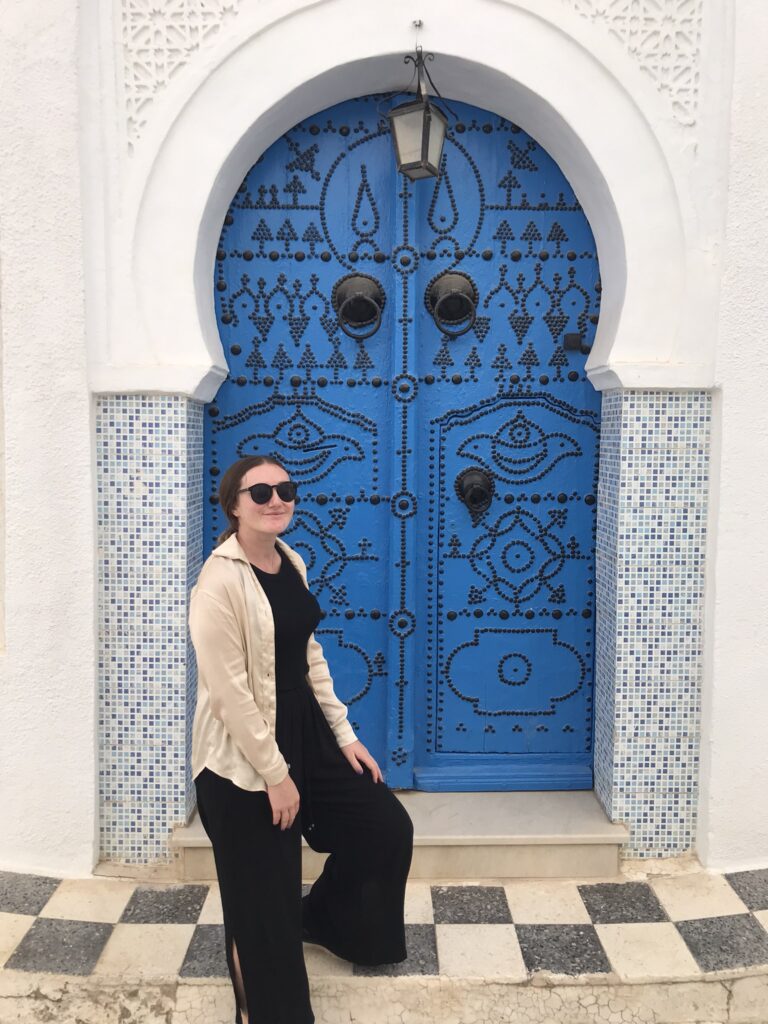
Most men in Tunisia also adhere to this dress code but we saw many more young guys walking about in shorts and t-shirts than women so Dan got away with wearing shorts and a t-shirt more than I did.
It’s best to learn some basic French, we speak very little French and managed to get around so it is possible, however to get the most out of visiting Tunisia then speaking some French would definitely help along the way. Arabic is the most spoken language, followed by French and then English so most people you encounter will understand some French. We were told by our walking tour guide in Sidi Bou Said that children are taught in French at school so most Tunisians are fluent, only those who are older or in very remote areas may not understand. Don’t expect restaurant menus to be in English, it’s very unlikely you’ll find this outside of the most touristic areas. In many areas we visited no English was spoken, so be prepared to dust off your rusty French.
Wear closed-toe shoes in the medina. Almost every city in Tunisia has a medina, usually surrounded by tall walls making the area look more like a fortress than a marketplace. The medina is often the oldest city district, the word ‘medina’ in Arabic means city and so in many cases the medina refers to the original city settlement. The medina area usually consists of a myriad of narrow, winding alleyways and it can be very easy to get lost, so make sure you keep a track of where you’ve come from. The walkways can sometimes be very dirty and strewn with litter/animal waste, the residents try to keep the area clean as best they can but with the inevitable swarm of street cats and market activities, conditions can at times become a little squalid. Watch your step for uneven patches and holes too! The medina areas are usually a mix of commercial and residential however the ratio of this varies, the medinas in Tunis and Sfax have many shops and souks to explore whereas the medinas in Bizerte and Tozeur are residential and have virtually no shops, cafes or restaurants at all! Many stall-holders will greet you with ‘Bonjour’ and invite you to look in their shop, however a polite ‘No, merci’ worked fine for us if you aren’t interested. We didn’t buy any souvenirs from the medina areas as we were traveling light on a tight budget, we were told by locals it’s okay to look without buying however as we didn’t try this and generally kept our eyes away from the stalls, so we don’t how true this is.
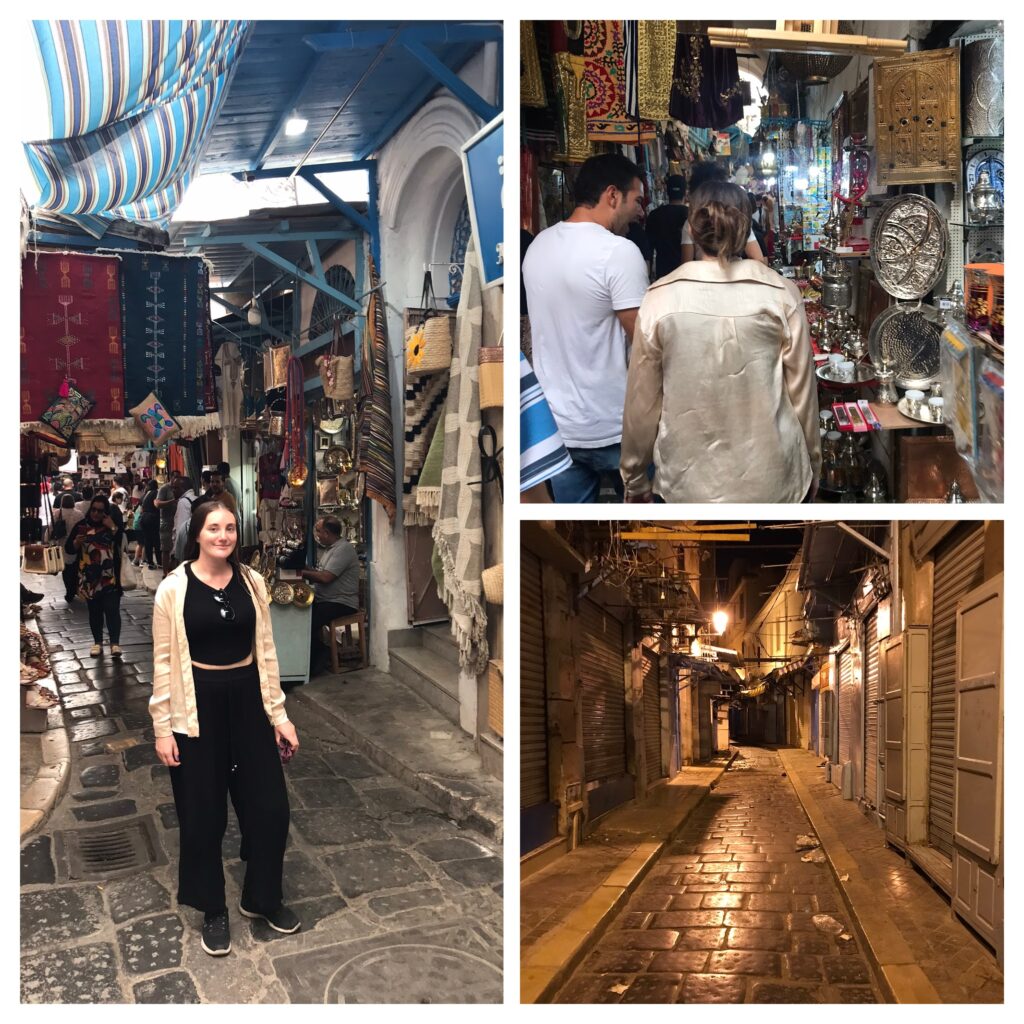
Tunis medina during the day and after dark
Very few places take card payments so you will need to get cash (Tunisian Denar or TND) when you arrive in the country. ATMs are very common in most towns and cities and we had no problem using our British debit cards at any ATM we tried. All ATMs in the country have a fee which is usually around 10 TND per transaction and there’s often a limit to how much cash you can take out, at some ATMs we took out up to 500 TDN but others have reported lower maximum withdrawal amounts. Be aware that some places like Matmata don’t have an ATM, we almost got caught out by this. Check before you travel and constantly monitor your cash levels so you don’t get stuck. The other alternative is to bring US dollars or Euros with you and use a currency exchange, you’ll find currency exchanges in every city without a problem. We found that many accommodations on Booking.com stated that they would accept TDN or Euros so we brought some Euros with us as a backup which made life a little easier, we even paid for our room in Toujane (probably the most remote place we visited) in Euros when we got stuck for cash in Matmata. You can’t buy TND before you travel. It’s a closed currency which means it’s worthless outside of the country so make sure you spend every penny before you leave, otherwise it’s just a souvenir. We were warned not to try to take TDN out of the country as officials may check for it and confiscate it at the airport when leaving, but we didn’t experience anything like this and we kept a 5 TDN note as a keepsake.

Meeting new friends in Ksar Ouled Soltane
Leave your distrust and cynicism at home. Most Tunisians aren’t out to get you or rip you off. Yes, especially around tourist areas you may encounter an occasional taxi driver asking for more money than the meter says, or restauranteur that invites you into their restaurant without giving you a menu with prices and then tries to charge you outrageous amounts (we had this happen to us opposite the municipal theater in Tunis until we impatiently demanded a menu with prices, only to be scammed on the drink price)! These things inevitably happen wherever tourists are. Like anywhere, use your common sense and don’t take the goods or service without agreeing on a price beforehand if you are unsure. Equally, around touristic areas you may encounter people who try to make friendly conversation, only to then try to lure you into their shop/stall or, even worse, offer to be a ‘guide’ for money. If you don’t want this then just politely say ‘No, merci’ and keep walking, and the chances are the hassler will quickly move on to someone else. Many people, particularly in medinas or tourist areas, may try to sell things to you, but this is only a minor annoyance and unlike in other countries such as Egypt they usually aren’t persistent if you say no. However, outside of the typical tourist areas, in most of our encounters with Tunisians we found them to be friendly, genuinely helpful without expecting money in return and curious about us.
Many times, a kind stranger would step in and help us without being asked. Whenever we arrived at a louage station (and we visited MANY louage stations) there was always a man that would assist us with finding the correct vehicle. In Tunis, on our way back from Sidi Bou Said on the TGM train a helpful local advised us that due to engineering works we needed to disembark the train and walk to the next station along the line to continue on to Tunis, without this information we would’ve ended up heading back to Sidi Bou Said. On the way to Ksar Ouled Soltane in a local louage we met two young local Tunisian women, one with a full facial veil, using Google translate we had a chat with them and they offered to give us a tour of the Ksar, we even had mint tea with them in a cave! We said our goodbyes with many cheek kisses and one of the ladies said ‘I love you’ in English! After we became stranded in Douiret, a local family offered us tea and arranged for someone to drive us back to our accommodation around 20km away in Chenini. After visiting the ruins at Dougga, we resolved to walk back to Teboursouk along the road, however a kind local man and his wife who were passing by offered us a ride in the back of their truck (and I mean the actual flatbed!) and refused to take any money from us even when I tried to offer some for fuel, the man even pointed out the louage to Tunis when he dropped us off. These were just some examples of the kindness and hospitality of the Tunisian people.
Public transport
We used almost all the modes of transport Tunisia has to offer including louage, local louage, train, bus, tram (only in Tunis) and taxi.
Taking the tram (metro) in Tunis is a very different experience than in most European cities. While the Tunis metro is cheap and has good coverage, we found it frustrating at times as we’re used to efficient and timely trams. Having woken up at the crack of dawn to get to the Bab Saadoun louage station we then waited inside a stationary tram at Barcelona Station for over 30 minutes on two occasions whilst it filled to the brim with passengers, the tram became ridiculously overcrowded with more people squashed in than was safe, the situation became pretty suffocating! We presume this was because there aren’t enough trams in service during rush hour. In other overcrowded trams we saw people clinging to rails and hanging out of the doors, sometimes the doors of the tram would fail to close or open which again isn’t great if there’s a fire or derailment. Overall we found that if you want to get somewhere quickly and comfortably the tram isn’t always the safest bet.
We took the bus from Tozeur back to Tunis, a whooping 8-hour bus journey and I can honestly say we didn’t encounter any problems, it left on time and was slightly more comfortable than the louage. You can buy bus tickets at the kiosk or bus company office, they must be purchased before you get on the bus. I can’t say what the situation is for other inter-city bus travel as we only took one journey from Tozeur to Tunis, however there is coverage between many other cities especially in the north of the country.
While there is train coverage in the country, we found train travel apart from the Tunis-Carthage-Sidi Bou Said TGM line to be unreliable. Most trains we asked about were not running and when we tried to get the train back from El Jem to Sfax it was canceled without explanation, so from then on louage became our preferred method of travel. By the end of our time in Tunisia we didn’t even bother looking to see if there was a train to our next destination. The Tunis-Carthage-Sidi Bou Said line which left Tunis Marine station was okay, the carriages and seats were grimy, New York-esque but it gets you to the correct destination. We had to alight the train and walk to the next station along the line near New Goulette as presumably there were ongoing works on the tracks. We were told not to use the train after 10pm as it gets a bit dodgy, but we didn’t see this firsthand.
Taxis were cheap and easy to use. Make sure the driver turns on the meter or they may try to overcharge you. We were only overcharged once, in Sousse from our resort to the louage station. To avoid being overcharged it is sometimes a good idea to see if you can hail a taxi that has just dropped off a local, rather than getting into a taxi that is waiting outside a station or tourist attraction. If they do overcharge you, it’ll only be by £1 or £2 so nothing to cry about really. The taxi drivers really do know the area so if you ask for a specific hotel or location, they probably will know where it is and won’t look at you blankly.
The best form of public transport in Tunisia is the louage, which is basically a shared taxi/minibus with between 7 and 9 passengers. The louages depart from stations and have set routes and set fares but do not operate with set timetables, the vehicles just depart once they are full of passengers. This means that after buying a ticket you might be waiting around a little while for the vehicle to fill up, or you might get lucky and get the last tickets in which case the louage will depart straight away! I have to shout this from the rooftops, I am a big fan of the louage system. Louages are dead cheap and such an easy way to get from city to city. We never spent more than £5 on a louage trip and most journeys cost between 10-15 TDN to get from one city to another. There are local louages which transport people on shorter trips to local towns and villages (these have yellow or blue stripes) and long-distance louages (red stripe) which get you from city to city.
Click here for my guide to using louages in Tunisia. Once you get the hang of the system it is definitely the best, easiest and most cost-effective way to get around the country.
For more specific information on exact louage routes and our travel experiences on the louages check out my other blog post here.
Culture
Tea and coffee drinking is big business here, you will often see gangs of men sitting on plastic chairs facing the street, watching the world going by, their mopeds parked nearby in a cluster, sipping on tea or coffee, chatting with friends or puffing away on shisha pipes. This is a very masculine activity and we never saw any woman participating in this ritual.
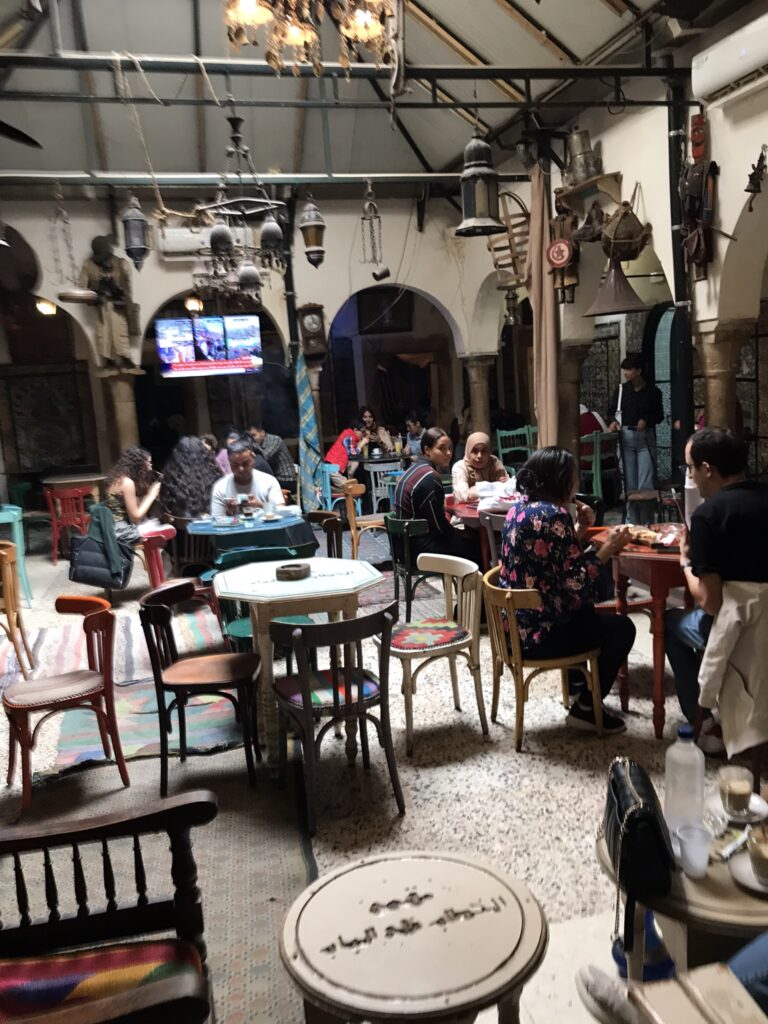
We were often offered tea as a way of greeting and welcome. This happened when we arrived in Toujane, the family quickly put a teapot on the stove and offered us some when we arrived. We were also offered tea by a lovely man who helped us out when we were in a sticky situation in Douiret. We’d just hiked for 3 hours from Chenini through the desert to reach Douiret, losing the trail in the process and going off-piste for most of the way there. Having enjoyed exploring the ruins of Old Douiret, we hiked to the new town only to realise that it was a very small and rural settlement and the great idea of returning by louage to Tataouine was looking very unlikely as it was 3pm. We were stuck in Douiret with no way to get back to Chenini (27km away) and we couldn’t hike back before nightfall. Sitting on the pavement contemplating our next step when we approached the owner of the nearest house, he agreed to ask around to see if anyone could give us a lift back to Chenini and whilst he was arranging it for us he offered us tea. We were also offered tea at the Mosque of the Seven Sleepers by the wardens on the route from Chenini to Douiret.
Tunisians smoke. A lot. In restaurants, cafes, pretty much everywhere. In most places it’s not so much of a problem but we did visit some cafes (ahem Green Light Coffee House) where we literally left the cafe stinking of smoke, we smelt like a chimney. I had to wash my hair again just to get rid of the smell of smoke. You can often request non-smoking rooms in hotels and occasionally there are non-smoking areas in cafes and restaurants.
When choosing accommodation, remember that the word ‘Dar’ means house/home. A Dar is essentially a family home so you can expect a more relaxed and warm experience than staying in a hotel or resort. It’s similar to a homestay or Riad in Morocco. If you choose to stay in a Dar whilst in Tunisia it can be very rewarding for both you and your host family. You can stay at more luxurious, hotel-like Dars or more simple ones.
Safety
We never felt unsafe in Tunisia, we walked around freely at night and didn’t encounter any dangerous or dodgy situations. Pickpockets may operate in certain areas but generally the risk of violent crime is low. I would always recommend the following: reduce the risk of being targeted by thieves by never flashing fancy cameras, never leaving your phone or wallet in your back pocket or holding your phone far away from your body i.e. to take selfies without first checking your surroundings, leaving your phone on the table at a restaurant, leaving your backpack in an easily reachable place or unattended and just be aware of any suspect characters nearby. We always use ‘the money bag’, as we nicknamed it, to carry cash. It’s a cash pouch on a necklace which you can hide beneath your clothes, it rests on the middle of your chest.
Tunisia did have some problems with terrorism in 2015, so high-profile sites are now heavily guarded with scanners, metal detectors and armed police. Parts of the country are still marked on many governments’ do not travel lists, however this mostly only applies to the far south and border areas, and locals we mentioned this to scoffed and said that all of the country is safe.
Tunis

Tunis is a thriving, bustling city but as with all major capital cities, we found it wasn’t necessarily the best place to connect with locals and it definitely wasn’t an accurate representation of Tunisia as a whole.
Most of the best accommodation in Tunis is in and around the medina which is the labyrinth-like focal point of the city. Very important: if you’re staying in the medina, everything and I mean everything within the medina, cafes, shops and restaurants close around 3-4pm. After this time you need to leave the medina if you want to have dinner or go to the supermarket. We found this to be slightly inconvenient when we were tired and hungry and had to walk for about 20 minutes to hunt for somewhere to eat. We stumbled upon a local joint just outside the medina that served rotisserie chicken, lamb couscous, pizza, brik, ojja and all the classics which made our life a lot easier afterwards.
You can use Bolt, an app similar to Uber, to get a taxi to your accommodation, but keep in mind that taxis won’t be able to drive into the medina, you’ll see why, the streets are unsuitable for vehicles and so taxis will drop you off on the edge of the medina. We were advised by our accommodation, Dar Kenza, to ask the taxi driver to call ahead so someone could come and collect us from the outskirts of the medina and show us the way to the Dar. We arrived on a flight after midnight and pre-arranged a transfer from the airport to the Dar with Booking.com, and although it was more expensive than Bolt (£15 more to be exact) we didn’t want the hassle of trying to find a taxi at midnight.
Accommodation
Dar Kenza – located in the heart of the Medina, Dar Kenza isn’t a luxurious 5* hotel, it’s homely and comfortable and is a great base to explore the Medina. We enjoyed having breakfast on the roof terrace and tasting traditional Tunisian breakfast items, some of which I’m still not entirely sure what they were! Rebeka, the host, was very friendly and helpful every morning, giving us suggestions of where to go. She even gave us a free tour of the medina which was a real highlight of our trip! It’s a bit of a trek from the medina to the Tunis Marine rail station (for visiting Carthage and Sidi Bou Said) or the closest metro station so I would only recommend staying in the medina if that’s the area you want to explore or if you have more time and don’t mind walking.
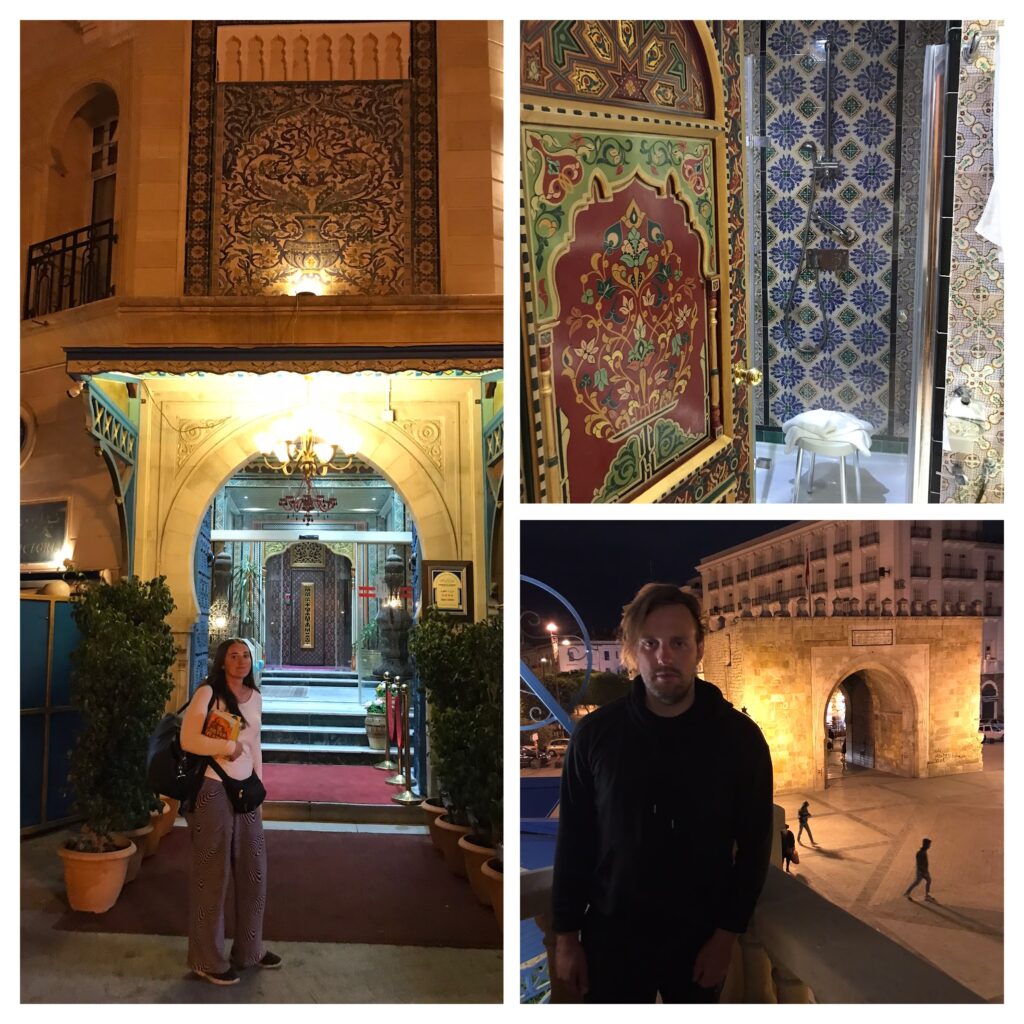
Living a life of luxury in the Royal Victoria Hotel
Royal Victoria Hotel – formerly the British embassy, this place was oozing with ostentation, from the ornately painted wooden doors, to the hand-painted tiles in the bathroom, we felt like visiting dignitaries. Our room overlooked the medina entrance and was a great people-watching spot. The hotel is ideally located near the medina entrance which means you’re closer to evening dining spots.
Hotel Tiba – an excellent hotel with a 24 hour reception with helpful, English-speaking reception staff. The breakfast is fantastic here, one of the best we had in the entire trip and the location is fab too: just off the main avenue Habib Bourguiba. Perfect if you want to walk to the Tunis Marine Railway station or Barcelona (Main) Metro Station.
Foodie Places
Cafe du Souk – a busy cafe situated in a souk in the medina, serving drinks and food, a favourite with locals and tourists alike.
Café Mrabet – here you can choose to sit on the floor, amongst a myriad of carpets, and drink coffee or tea in the traditional way. Our walking tour guide chose to stop here for coffee during the tour and recommended this place. We also returned to the restaurant upstairs for lunch as we mistimed lunch and were desperately trying to find somewhere still serving food at 3pm, the lamb couscous was fantastic!
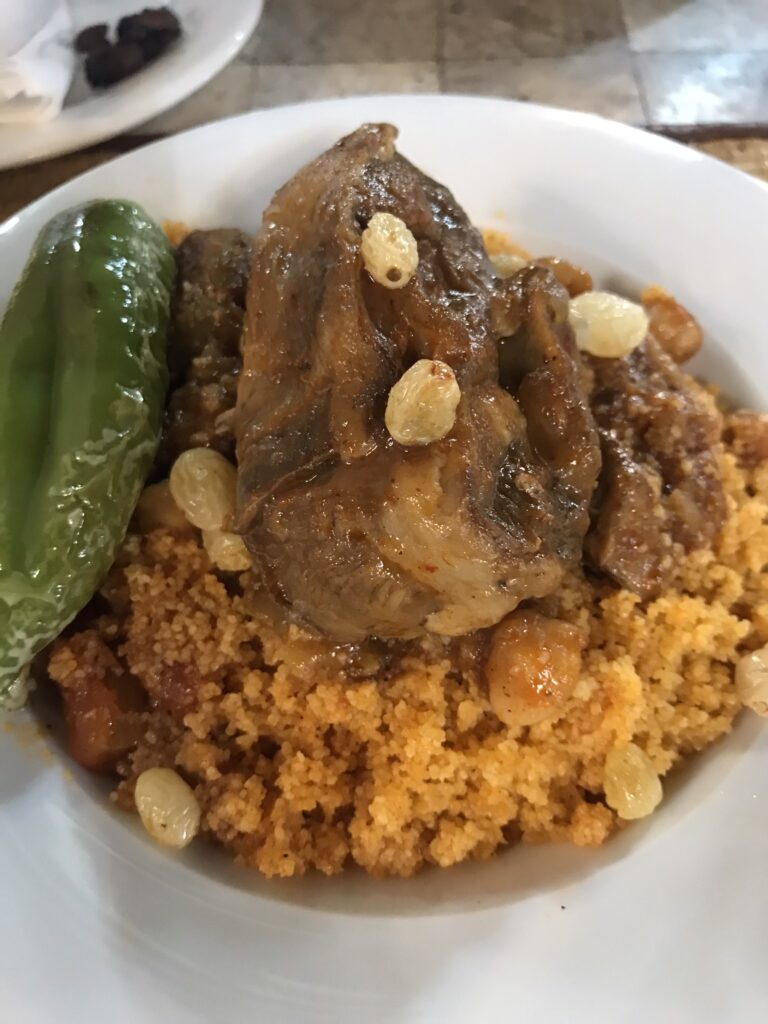
Burano – this became our go-to dinner spot, we literally went there 5 times as it was cheap with tasty fast food (pizza, variations of pizza sandwiches and pasta) and they took card payments. Winner!
Restaurant of People – we found this place during our second stay in Tunis and we didn’t know how we’d missed it during our first visit. This is a local joint with mostly Tunisians and the occasional westerner, the menu is in French and the staff speak some, but not much English. You can choose from a vast catalog of Tunisian favorites such as pizza, makloub (sandwich made with pizza base), brik, salads, ojja, pasta, rotisseries chicken (delicious!) and couscous. It’s crazy cheap and very tasty, don’t let the appearance of the place i.e. the plastic chairs, deter you. It’s just outside the medina so perfect if you’re staying in the medina.
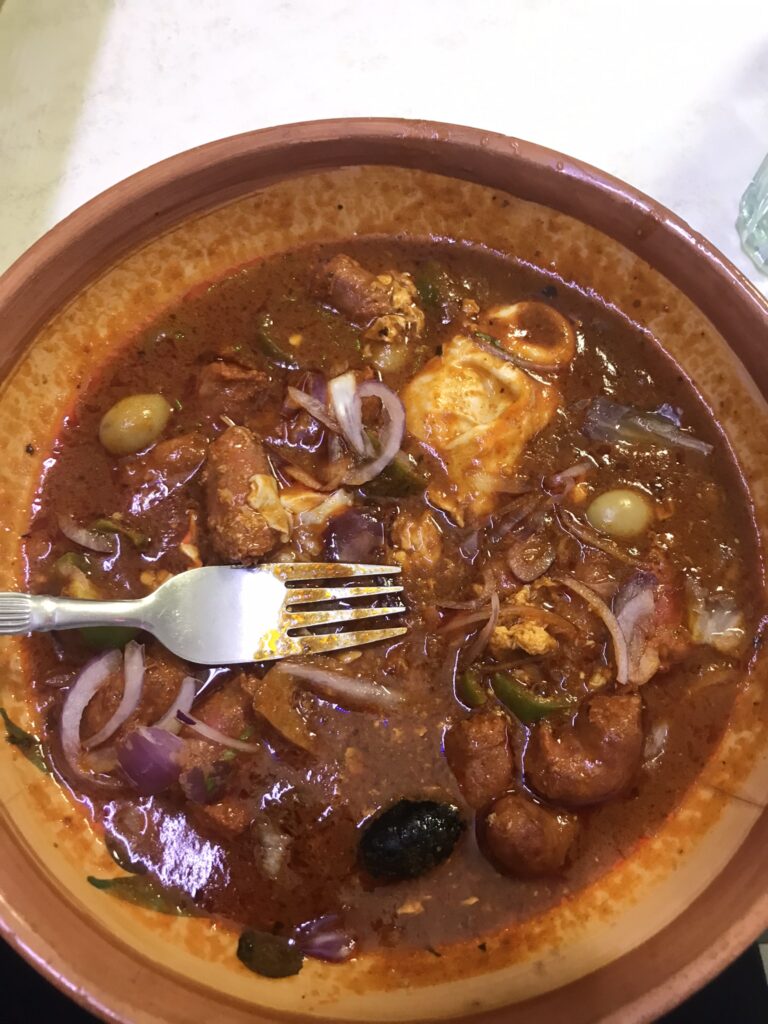
Ojja at Restaurant of People – yummy!
Green Light Coffee House – or should I say smokehouse! This place has a young, hip crowd mostly because it’s situated close to the Bardo University building. You have to try the French Tacos, there’s absolutely nothing Mexican about them or French really but they’re delicious.
Restaurants on Habib Bourguiba Avenue – there are numerous restaurants along Habib Bourguiba Avenue heading to the medina, many of these restaurants have men outside who will quite pushily try to hassle and coax you in. Avoid these restaurants at all costs! While the food is not bad (but not the best), unfortunately all of these restaurants are scammers who deliberately try to target and overcharge tourists. You will notice that the menus don’t have prices, which is always a giveaway, there is rarely anyone dining there and their ratings and reviews on Google speak for themselves. We unfortunately had to eat at one of these restaurants as it was the only place we could find that was open on a Sunday evening (if you are in town on Sunday evening then be aware that everything closes early, be prepared unlike us). The restaurant was called Joker (opposite the Municipal Theatre) – don’t go here, we forcefully demanded a menu with prices and when we were finally given one it didn’t include the drink prices, lo and behold we were then extorted for a glass of alcohol-free beer (a whopping £4 for a dribble of beer in a plastic glass!). I think we got off lightly with that too given the horror stories. Avoid at all costs!
Activities
Roam around the medina, you can do this independently or with a guide, we did both and felt that having a guide provided more context and understanding about what was going on and the different parts of the medina. Tunis medina is the biggest in the country and is almost like a city in itself. We were joined by Rebeka, a local resident who worked at Dar Kenza. She offered to give us a free tour of her neighbourhood and showed us her family home in the Medina. We felt lucky to have this experience. I will always remember her cheerful demeanour as she greeted shop-keepers, neighbours and friends she bumped into. You can visit the Jewish quarter, various madrasas (Islamic schools) and mausoleums which are open to the public, Zitouna Mosque and Kheireddine Palace (this was a free art gallery displaying Tunisian artists’ work, you can even buy the artwork!) If you want to get some retail therapy in, you can visit souks in the medina to browse for clothes, jewellery and souvenirs.

Outside the medina, Municipal Market and Monument Place de la Kasbah are also both worth a visit, although I would recommend visiting the market in the morning whilst it’s in action. Be mentally prepared to see horse’s heads hanging from butcher’s hooks and the intense smell of fish!
If you find yourself at a loose end after dark in the medina, why not grab some cat food from a supermarket and feed the medina cats whilst walking around the ghostly, creepy, dark alleyways and walkways in the medina. It gave a distinctly Jack the Ripper, Victorian-esque feeling. It is recommended not to walk too far into the medina after dark, the streets are deserted and it is very easy to get lost. We stuck to routes we knew in the medina after dark and were warned a couple of times by locals not to venture too far, eventually we got freaked out by a hunched over man creeping through the gloom, we quickly changed direction after seeing this particular character.
Bardo Museum – If you’re staying in or near the medina, you can get the tram from Barcelona Metro Station to Bardo and it’s only a short walk from the tram stop to the museum. Alternatively you can grab a Bolt taxi instead. The Bardo Museum has a great collection of relics and mosaics from Roman sites such as Dougga and Bulla Regia, and many other Roman towns. It also features sections on Carthage and the Punic Wars, Christian Roman Tunisia, Islamic Tunisia alongside information on the building itself. In recent history, in 2015 19 visitors were shot and killed in the Bardo Museum by militant gunmen; these victims are remembered in a commemorative plaque inside the museum.

Odysseus encountering the sirens in the Odyssey and a mosaic that looked like Dan’s dad – both mosaics are in the Bardo
Walking tour with Riad booked through Tripadvisor (Unveiling Tunis Walking Journey in Medina and City Core) – this was a comprehensive tour of the medina that took us to a lot of places we otherwise wouldn’t have seen and really enhanced the experience.
Day trips to Sidi Bou Said, Carthage, Dougga, Bulla Regia, Kerkouane & Bizerte. We opted to stay in Tunis and visit all of these places on day trips as we were using public transport and didn’t want to lug around our luggage and have to keep moving from place to place. We had planned on renting a car to visit Dougga, Bulla Regia and Kerkouane as it would’ve given us greater freedom of movement but we didn’t bring a credit card with us so that option was off the table. Most travellers rent a car to visit the west of the country however we discovered by accident and very careful planning/research that it is doable by louage and a bit of luck. We based ourselves in Tunis and managed to get around without great difficulty.
This section is now available on GPSmyCity!
Sidi Bou Said
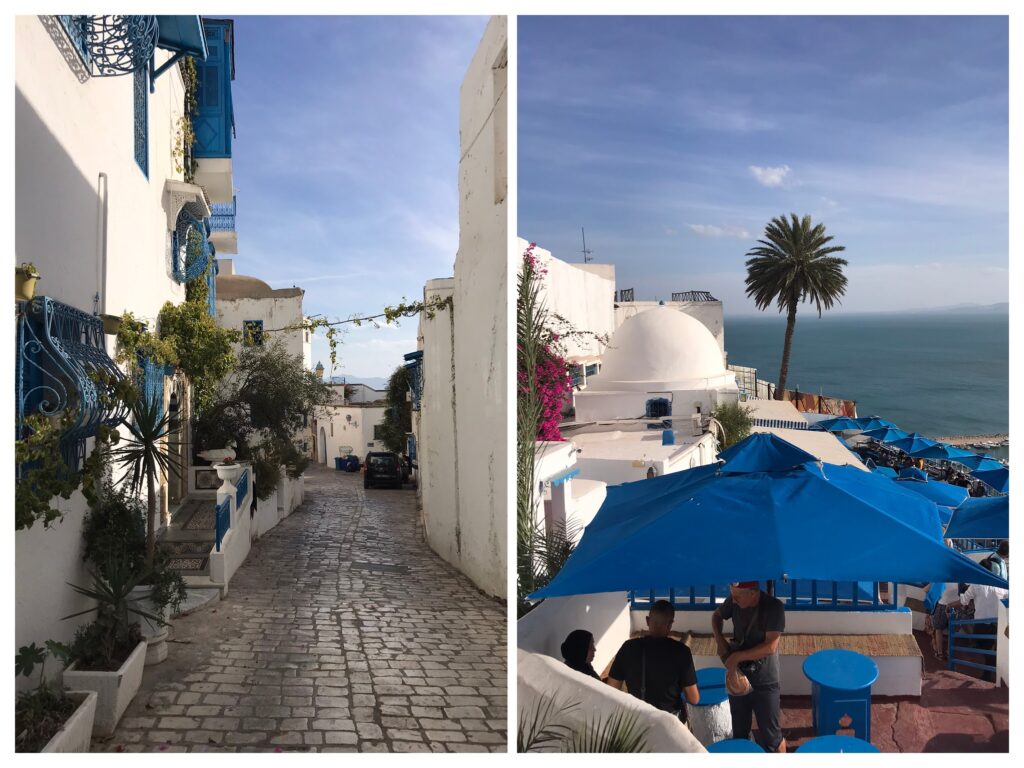
Sidi Bou Said is an amateur photographer’s dream. Branded the Santorini of Tunisia, this affluent suburb of Tunis boasts a beautiful colour scheme of glistening white and azure blue buildings. With fantastic views over the Mediterranean sea and a quaint, much cleaner medina area than Tunis. Sidi Bou Said is ideal for meandering around at a slow pace and taking in the breath-taking views.
Head to the Tunis Marine Railway station and catch the train to Sidi Bou Said. After some confusion with the ticket-seller we realised we had to get a rail replacement bus from outside the station as the train wasn’t running to Sidi Bou Said, on the way back to Tunis we found out that this was due to engineering works on the line, however we were able to get a train from Sidi Bou Said to La Goulette and then walk to the next station to get a separate train back to Tunis Marine.
We opted for a free walking tour with Hafya (this is no longer available on Guruwalk), it was hands-down the best way to see Sidi Bou Said. Here are some of the stops on the tour:
Ennejma Ezzahra Palace – built by Baron d’Erlanger for himself and his family, you can marvel at the Islamic art and architecture infused into this modern palace. There is a collection of the Baron’s belongings, including original furniture and an impressive collection of musical instruments both traditional and European. We were treated to a performance of traditional Tunisian music with traditional musical instruments by a band practicing in the palace. The music itself was captivating, the singing haunting and hypnotic.
Dar El Annabi – a decadent family home with great rooftop views over Sidi Bou Said.
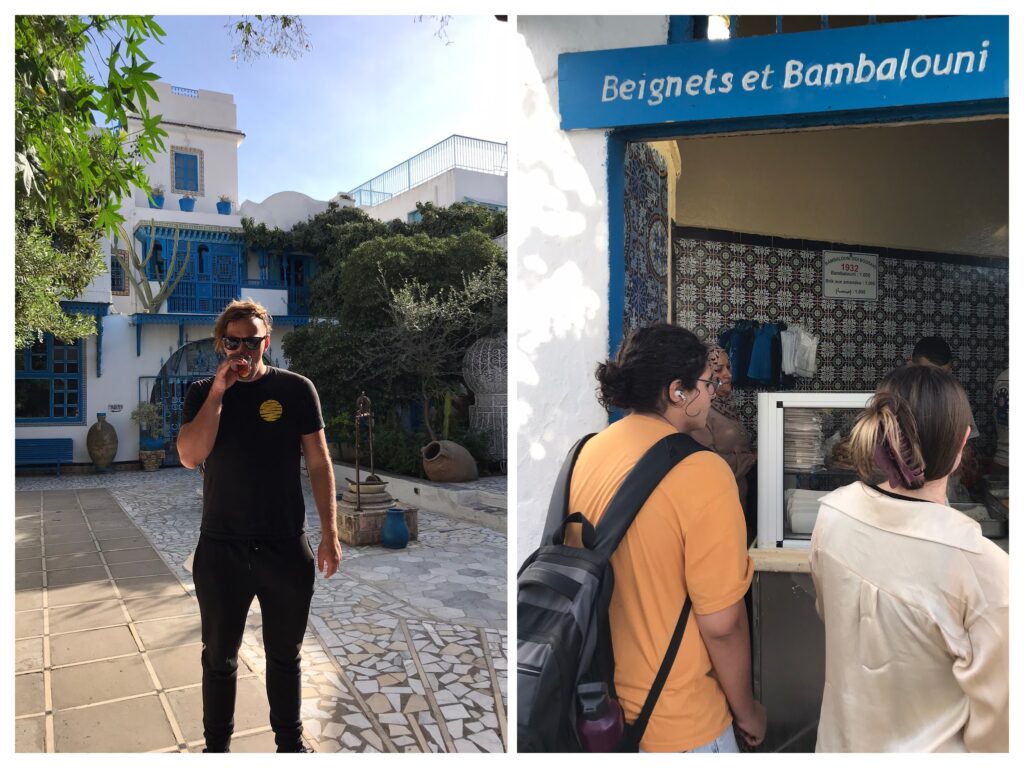
Beignets et Bambalouni – freshly cooked and VERY hot bambalouni, these are similar to donuts or churros, the dough is fried and then coated in sugar. Yummy!
Dar El Fell for the archetypical photo op showcasing the crisp white rooftops of Sidi Bou Said alongside the blue sea.
City panorama platform – another great photo op overlooking the city and the sea.
Harbour – a nice place to stroll through if you like looking at boats or scoffing at the rich.
Beach – you can paddle-board here although we didn’t opt to do this, the stairs from the beach back to the town itself are a killer!

Foodie places
Bleue! – a very French cafe serving fantastic shakshuka
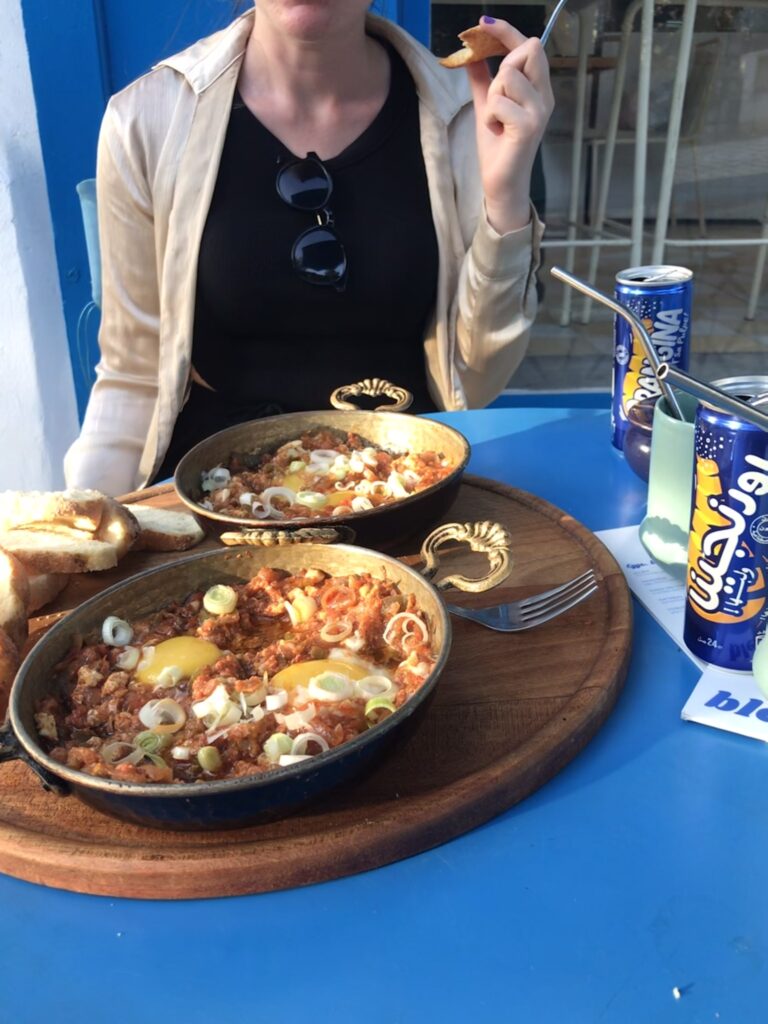
Carthage

Once a major rival of the Roman Empire, Carthage was the centre of the Carthaginian or Punic civilisation which developed in parallel alongside the Roman Republic. Carthage controlled most of the western and central Mediterranean through its monopoly of sea trading routes and strategically placed colonies. Carthage became the Roman Republic’s number one enemy due its dominance of trade. After every speech of Cato the Elder, a Roman Republican politician, he always ended his speeches with ‘delenda est Carthago’ (Carthage must be destroyed). Following the Punic Wars, Carthage was destroyed by the Romans in 146 BCE. The city was repurposed by the Romans and many sites are still standing and open for visitors. Aside from the archaeological sites, Carthage is now an affluent suburb of Tunis and also contains the president’s house!
If you want to reach Carthage by public transport head to the Tunis Marine Railway Station and hop on the train, it’s the same line that runs from Tunis-Carthage-Sidi Bou Said.
We decided to save money by opting for a self-guided walking tour using GPSmycity – this allowed us to go at our pace and avoid the tourist hordes. We always try to avoid big tour groups wherever possible.

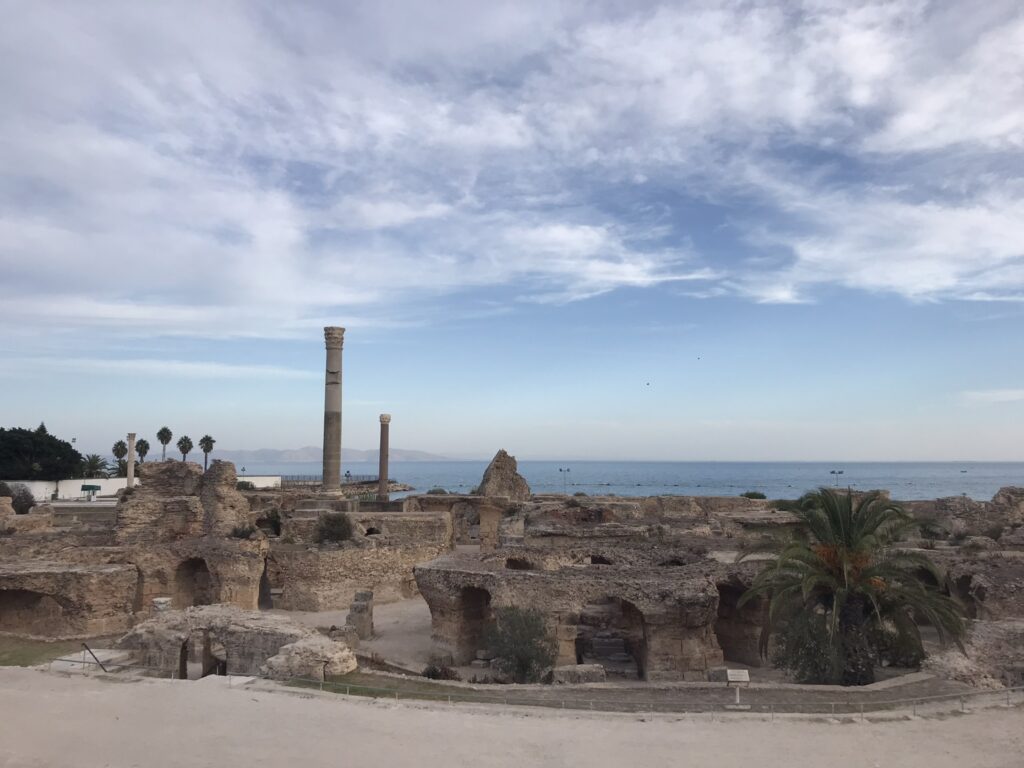
Stops on our self-guided walking tour of Carthage
We started our tour at the Acropolium of Carthage before heading to the National Museum of Carthage. At the time of visiting (Nov 2023), the museum itself wasn’t open but the gardens outside were. By purchasing a ticket for the Museum or any of the other attractions the ticket allows you access to all of the archaeological sites in Carthage including the Antonine Baths, Roman Theatre, Le Quartier des Villas Romaines (Roman Villas), Musée Paléochrétien, Punic Port and Salammbo Tophet. I recommend spending most of your time at the Antonine Baths as they’re the most spectacular in my opinion; the bath complex is vast and you really get a sense of how magnificent the baths would’ve been over 2000 years ago. We didn’t manage to visit the Musée Paléochrétien, Punic Port or Salammbo Tophet properly, we watched the sun set over the Punic Port and peeked over the wall at the Salammbo Tophet, which is graveyard filled with Roman-Punic stelae (grave-markers).
Foodie Places
Les Indécis – this place had a very European vibe, it’s located in a very affluent area surrounded by large mansions. The food here was exquisite and affordable – the falafel burger and fish of the day are an excellent choice if you find yourself gracing this establishment. I absolutely loved this restaurant!
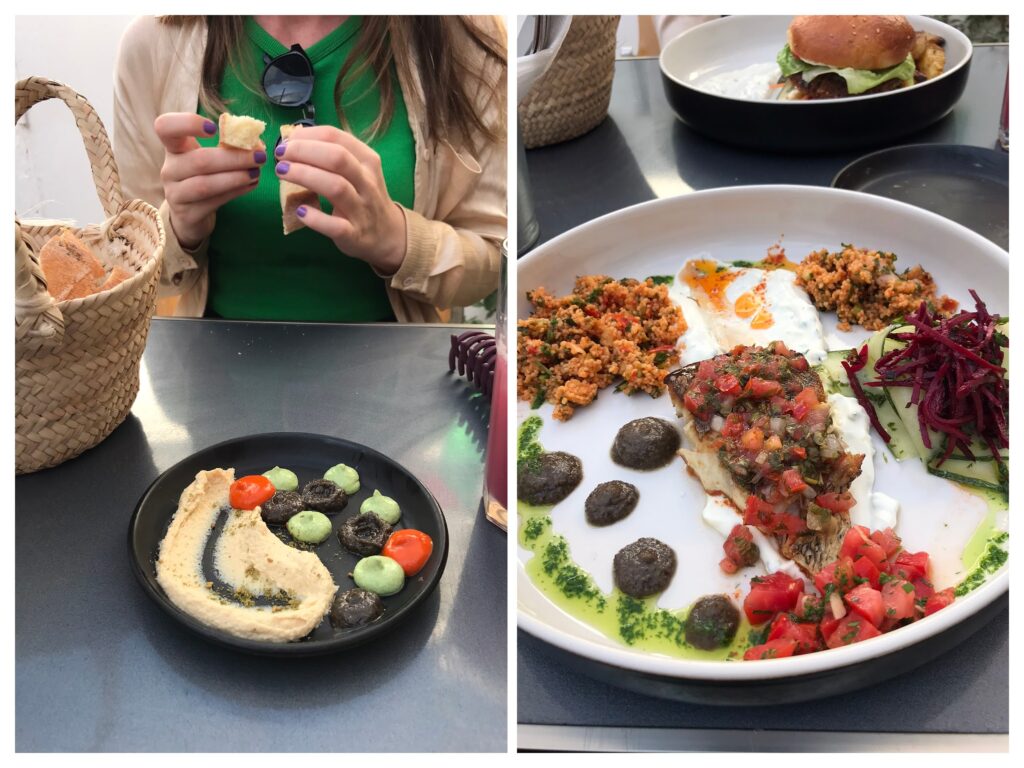
Dougga, Kerkouane and Bulla Regia
We found it challenging, this is putting it mildly, to figure out how to get to the archaeological sites at Dougga, Kerkouane and Bulla Regia by public transport from Tunis, as they are in quite remote locations and there isn’t a lot of information available. As I mentioned earlier, we didn’t take a credit card to Tunisia so hiring a car was off the table for us. I’m sure it would be plain sailing if you did rent a car because, distance-wise, none of these sites are that far from Tunis. However with a lot of hard work, research, careful planning and a bit of luck we managed to complete all of these day-trips from Tunis by public transport. The most important point I want to stress is that you need to get to the louage station by about 8am (or earlier, ideally) in order to get a louage, spend enough time looking at the site and then get a louage back to Tunis before they stop running around early afternoon. The timings are quite tricky so you need to keep an eye on the clock. After 2pm (or sometimes earlier) the louages usually stop running, however this often depends on the day, how many people want to go back to Tunis and other factors we don’t really know or understand! We’ve read that sometimes people get stuck with no way back when traveling to Dougga, Bulla Regia and Kerkouane because they miss the last louage. If attempting to do these day trips make sure you have snacks, water and a plan!
Dougga
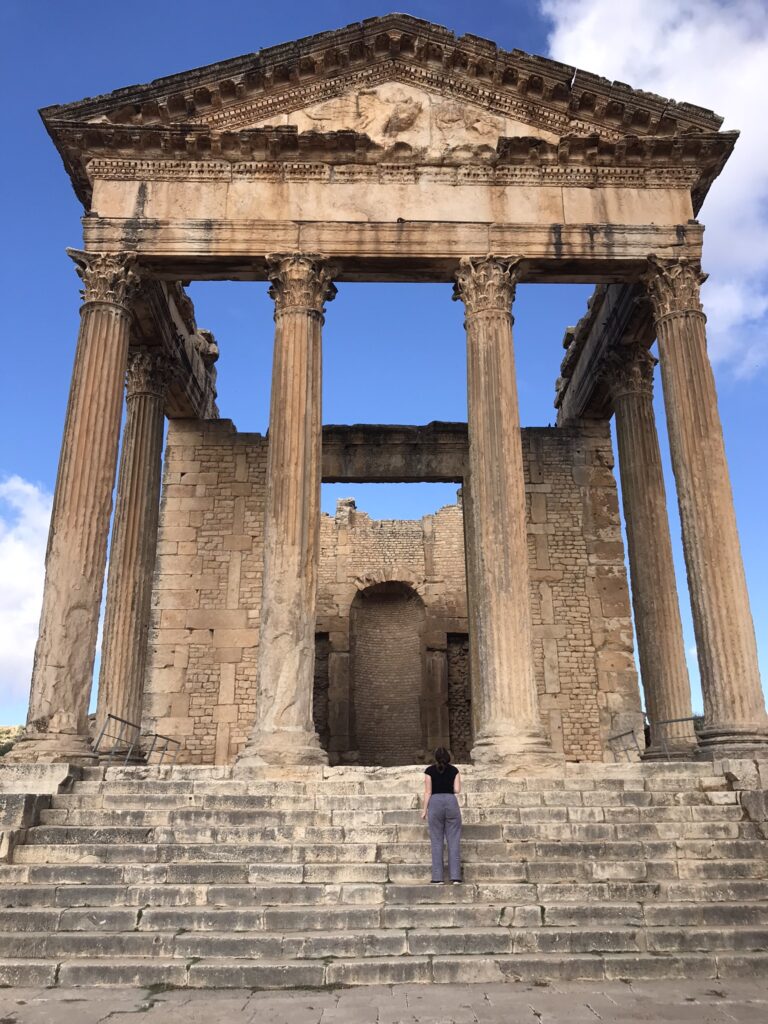
The grand capitol at Dougga
How to get there?
Bab Saadoun louage station – Teboursouk – Dougga
You can reach Bab Saadoun louage station in Tunis by taking the tram from Barcelona Metro station or La Republique and jumping on line 3, 4, or 5. Bab Saadoun is a large, chaotic louage station but we were eventually able to locate the louage to the town of Teboursouk, which is the closest major town to Dougga. We made sure to let the louage driver know we wanted to go to Dougga and for an extra denar he took us a couple of miles further than Teboursouk to the small town of Nouvelle Dougga, from there we walked for about 40-50 minutes to reach the archaeological site. We really enjoyed this walk as it was peaceful and tranquil, waving at the occasional local or donkey and watching the sheep herders moving their flock from one pasture to another, stunning pastoral countryside views. Alternatively, if dropped off at Teboursouk you could try getting a taxi from there to Dougga and asking the driver to return to collect you in 3 hours, this is about the right amount of time to explore Dougga and the local taxi drivers should be used to this route.
Dougga is a huge site and there are some plaques in English, French and Arabic with information which give you an idea of what the building was used for i.e. residential, public or religious. We particularly liked the views from the bath complex, the Roman forum, and the grand Capitol building alongside the impressive amphitheatre.
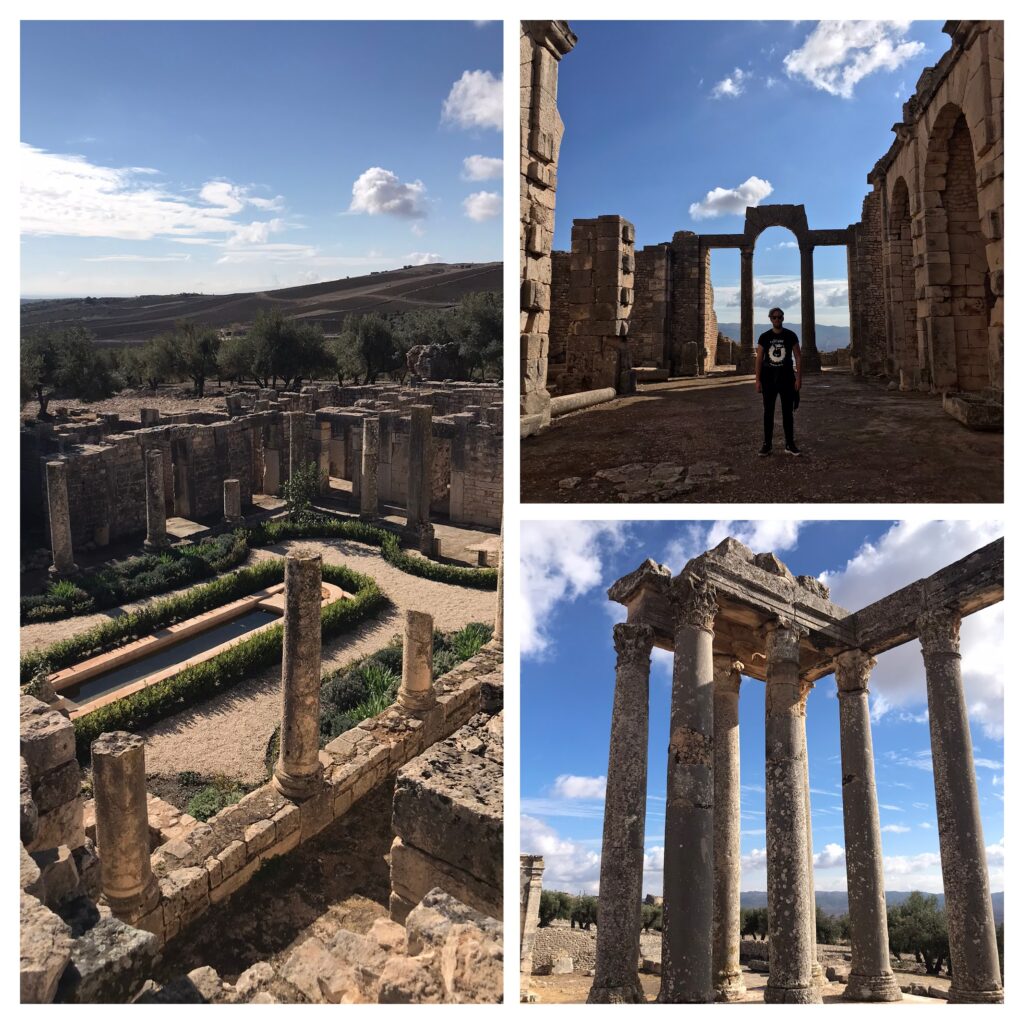
After we were finished at Dougga we opted to walk from the northern entrance back to Teboursouk along the main road, this would’ve taken a couple of hours however along the way a local offered us a lift which, alongside being a cool experience, sitting in the back of a pickup truck with the wind-blowing through our hair and a 360 view of the landscape, it saved us a lot of time. High five to that guy!
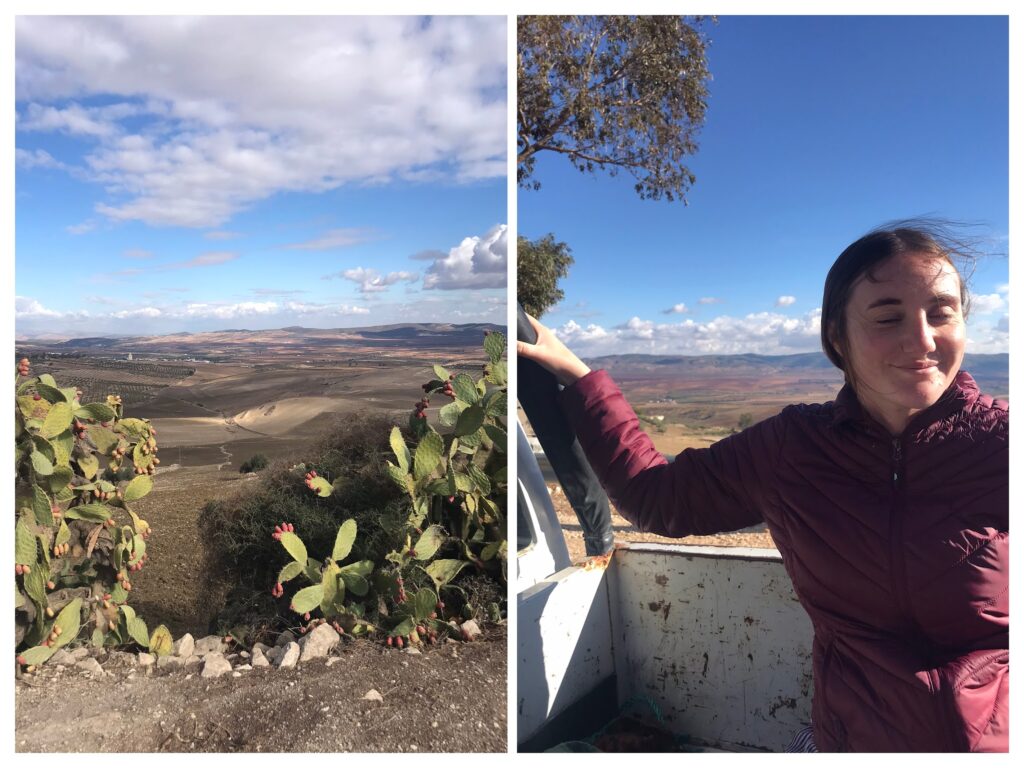
In the back of a truck near Teboursouk
Because of the good fortune of getting a lift back to Teboursouk, we were able to get the last louage back to Tunis at around 2pm. If you miss the louage, there should also be SNTRI buses back to Tunis running until around 6pm – although don’t take my word for this! The bus station should be just around the corner from the louage station in Teboursouk so it might be a good idea to ask beforehand if you think you are unlikely to make it in time for the last louage.
Kerkouane
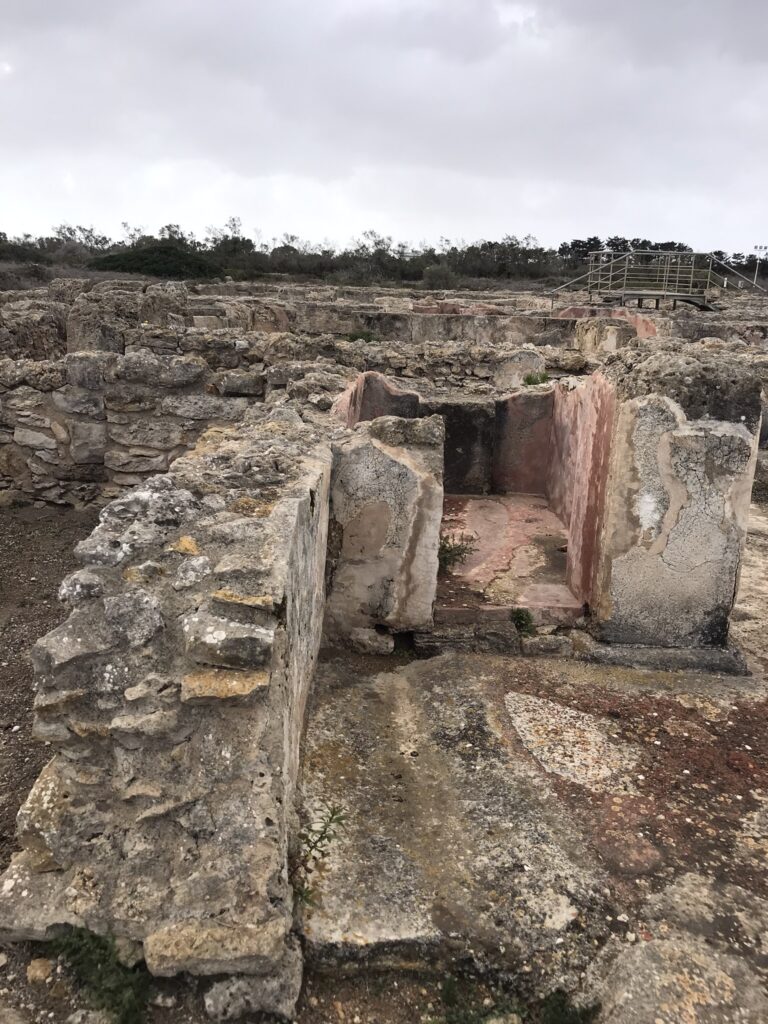
How to get there
Station Louage Bab Aliwa – Kelibia – Kerkouane
We took the louage from Tunis to the city of Kelibia, this departs from Bab Aliwa louage station which is within walking distance of the medina. Once arriving in Kelibia, we walked around the corner from the louage station to a taxi rank and hailed a taxi to Kerkouane. Through our very limited French we somehow arranged for the driver to wait outside for us whilst we visited the archaeological site, this worked out very well as it’s a smaller site; when we visited we were treated to gail force winds and grey skies so we didn’t hang about any longer than an hour.
What makes Kerkouane so unique for historians and archaeologists is that it’s the only Carthaginian settlement that was NOT repurposed by the Romans, here you can see rare Carthaginian mosaics, housing complexes, bathrooms and symbols such as the tanit near the entrance to a doorway (similar to the Egyptian ankh). We couldn’t help noticing the abundance of a rich red pigment used as paint on the walls of the houses. The site is also bordered on one side by the sea, when we visited it was very stormy! There is also a small museum near the main entrance with some finds from the site.
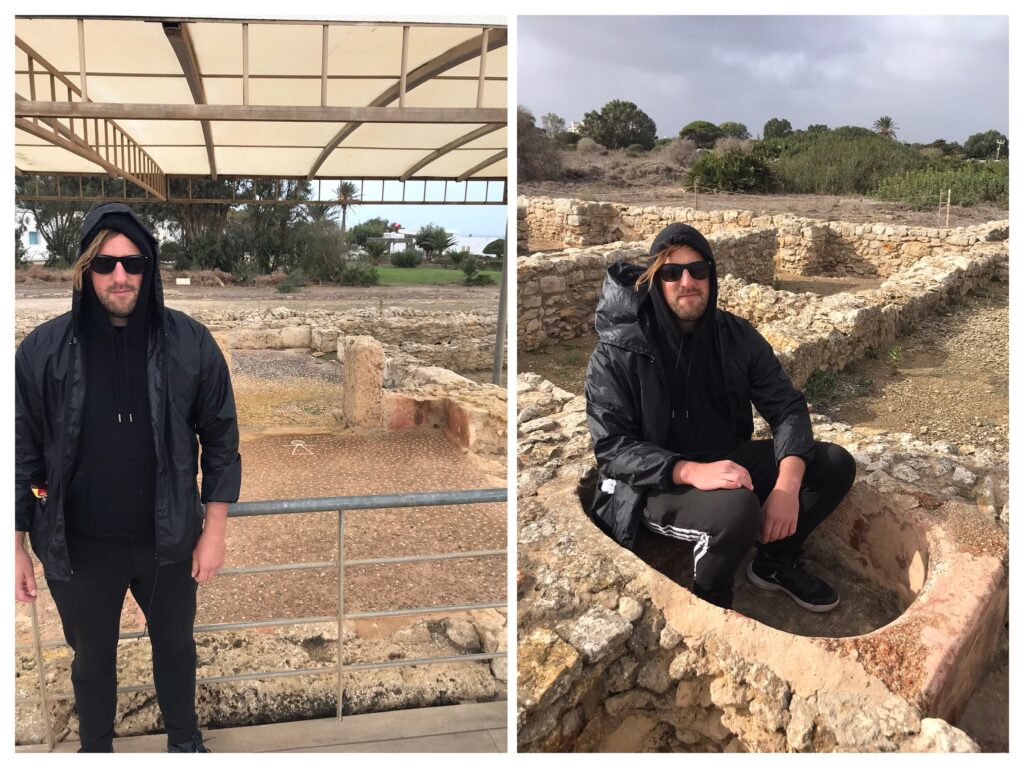
Our taxi driver dropped us back at the louage station after visiting Kerkouane. He kept the meter running but in total we just paid him about £10 which was more than he was asking for as he helped us out a lot. The driver was very insistent on also taking us to the Grottes El Haouaria on the northern side of the Cap Bon peninsula, we declined this due to the weather but it would probably be something that could be combined with Kerkouane if you are interested. Kelibia also has a fort which could be explored, again we didn’t do this as it is on the other side of the city from the louage station and with the poor weather we were eager to get back to Tunis.
Bulla Regia
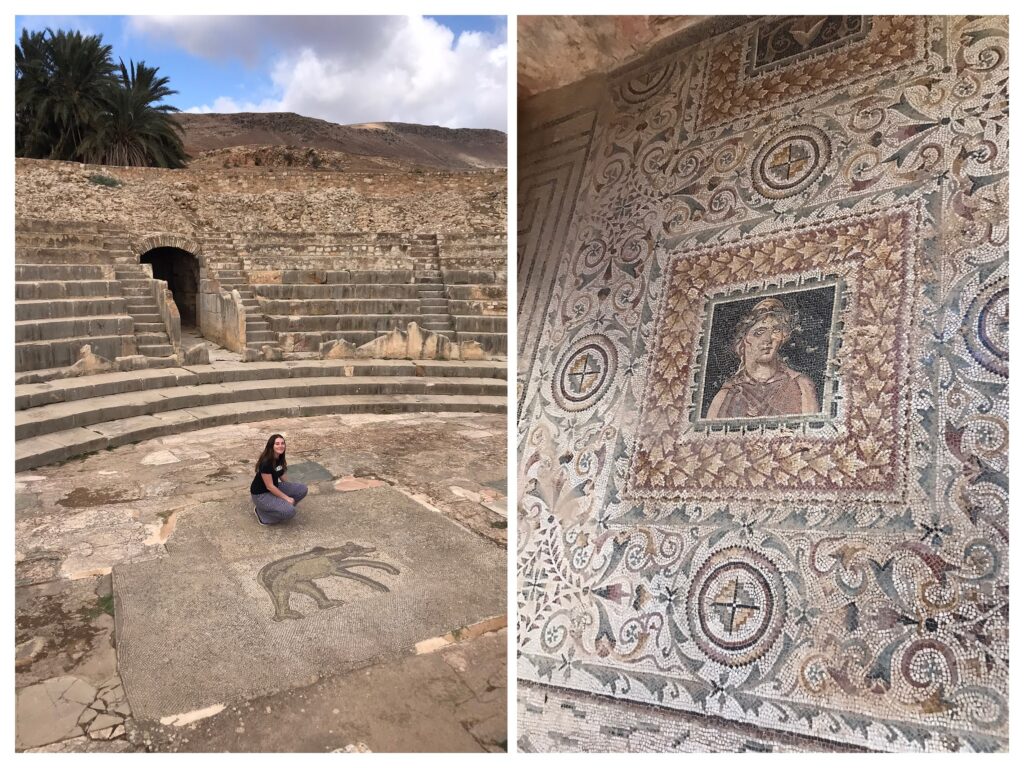
How to get there
Bab Saadoun louage station – Jendouba – Bulla Regia
The louage to Jendouba leaves Tunis from Bab Saadoun station, Jendouba is the closest city to Bulla Regia and is a regional capital and so is quite well-serviced by transport links. We took a taxi from Jendouba to Bulla Regia after trying and failing to find a local louage – as far as we can tell, after both extensive research and asking locals there are no local louages from Jendouba to Bulla Regia. The taxi was inexpensive and cost less than £5. We didn’t know how long we’d be at Bulla Regia for so we didn’t ask the taxi driver to return, however this wasn’t a huge problem as once we were finished at Bulla Regia we were able to hail a taxi on the main road back to Jendouba, no problem. It was slightly unusual as the taxi already had two people in it but hey ho, the more, the merrier and after dropping off the original passengers, the driver took us to the louage station without a hitch.
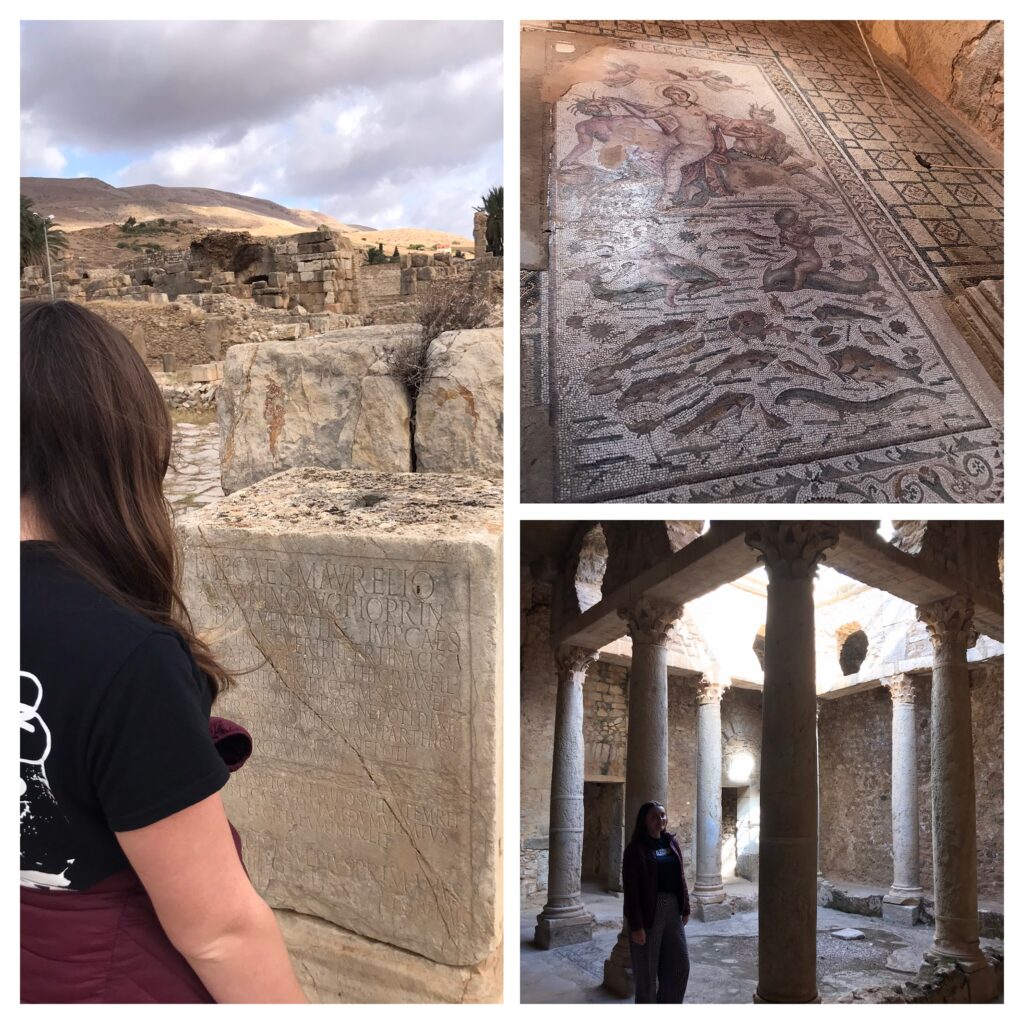
Going underground in Bulla Regia
The most important sites of Bulla Regia are the underground Roman villas, these are still mostly intact alongside marvellous mosaics still in situ. The House of Venus is an absolute treat, make sure you look for the stairs that lead below ground level, the underground levels feature cavernous halls and colourful mosaics mostly withstanding the ravages of time. Bulla Regia has an abundance of mosaics with both geometric patterns and human, animal and divine figures represented. We especially loved the bear mosaic in the theatre! We grabbed lunch at the restaurant across the road from the archaeological site, this is where the ticket office is too which is quite strange as we initially just waltzed into the site without paying for a ticket before realizing we needed to cross the main road to reach the ticket office.
Bizerte
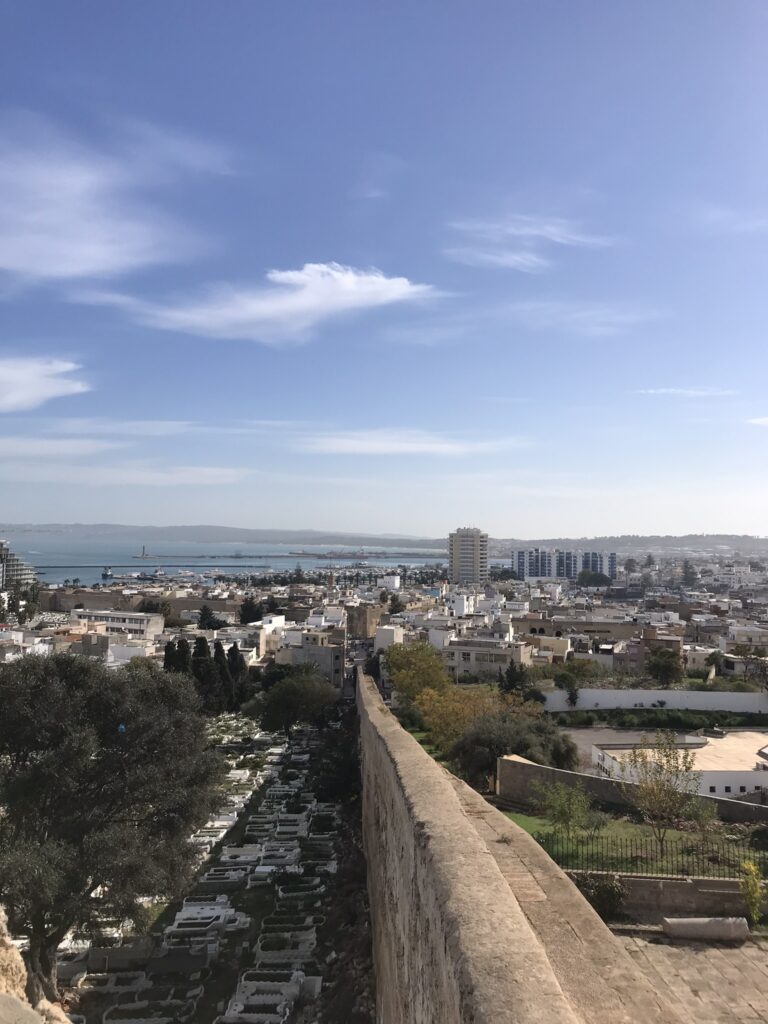
Bizerte is the northernmost city in Tunisia and Africa. We visited on a day trip from Tunis, taking an easy louage from Bab Saadoun station. Bizerte is also close to Ichkeul national park, which is famous for migrating birds, although this is very difficult to visit via public transport without a car and so we didn’t make the extra journey, we did catch a glimpse of Ichkeul lake from afar though! We decided to chance it and made our way to Cape Angela from Bizerte, this is the northernmost point of Africa.
How to get there
Bab Saadoun Louage Station – Bizerte – Cape Angela
We had to walk from the long-distance (red stripe) louage station in Bizerte to a local louage station in order to catch a louage to Cape Angela, these louages are located at the roundabout of Blvd. Hedi Chaker, Blvd. Saadi Carnot and Ave. Hassen Nouri. After some initial confusion in the louage (i.e. the driver refused to take our money and we couldn’t understand why), at one point we didn’t really know where we were going to be dropped off, however once the last passenger had exited the driver told us to stay in the vehicle and drove us all the way to the seafront, the northernmost point of Africa, and waited for us to take some photos before heading back to Bizerte. We tipped the driver an extra £2.50 for this and it worked out really well since we’d been expecting to hike to the coast after being dropped off in the nearby settlement of Ras Angela which is where the louage was supposed to stop.
Activities
Spanish Fort – free entry and interesting views over the skyline of Bizerte and the adjacent graveyard, if that’s what you’re into!
Marsa de Bizerte – a great place for a stroll to take in the colourful, quaint, Balamory-style houses along the waterfront and fish-boats lined up along the pier. We were tempted to have a coffee here but as time was ticking we bypassed all the coffee shops.
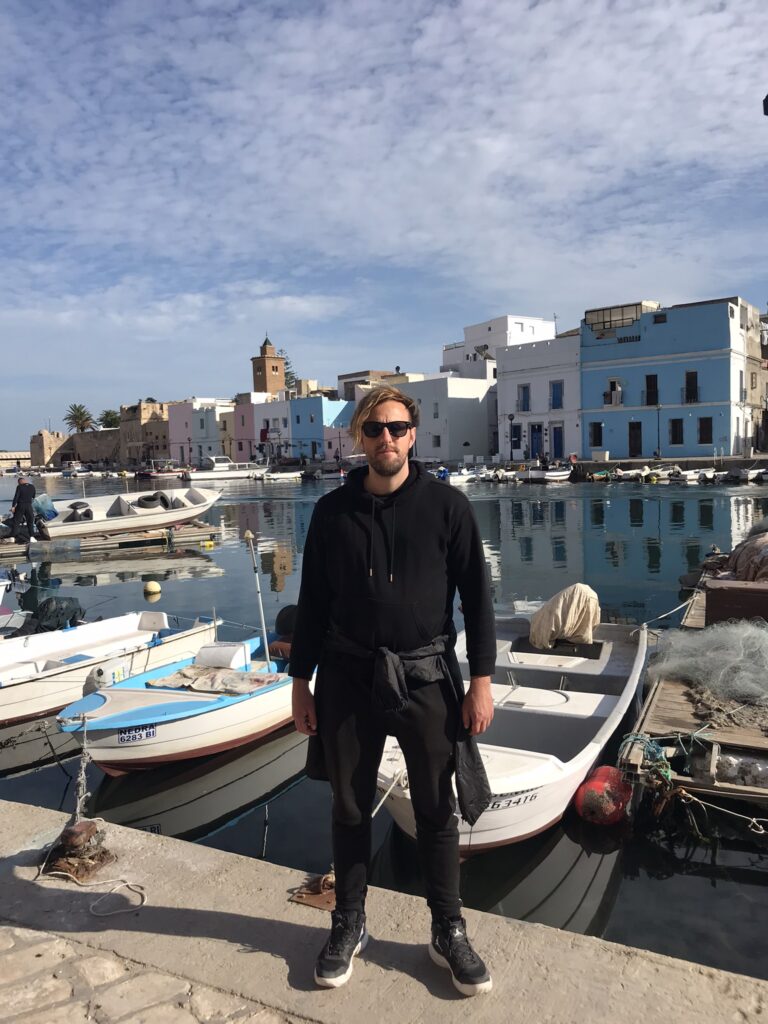
Medina – Blue and white houses line the streets, Sidi Bou Said-style. This is a residential medina with no shops, so is very peaceful and quiet!
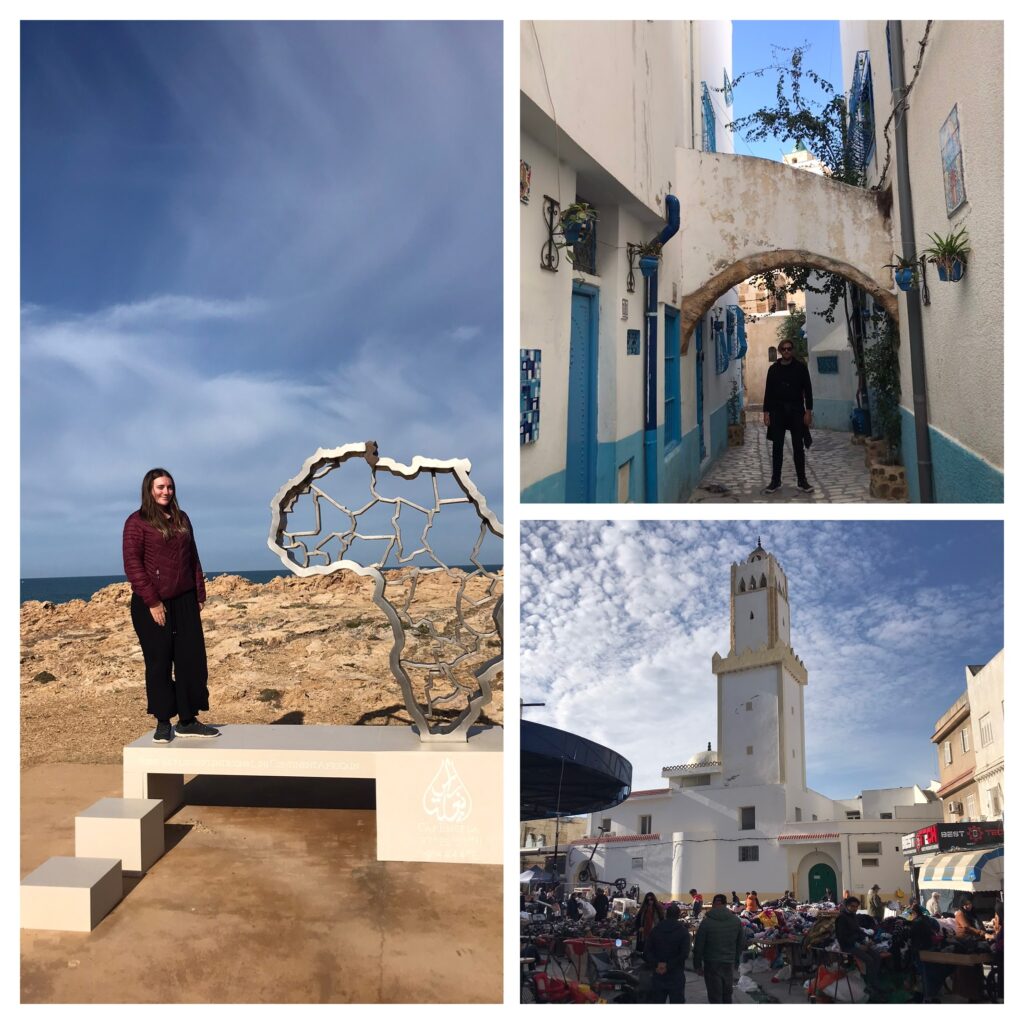
Foodie Places
Best Voice – it’s a mix between a cafe and restaurant featuring classic European dishes like burgers, pasta and pizza. The interior was very suave with comfy couches and full-length windows looking out over the street. The food was tasty and relatively cheap.
Sousse
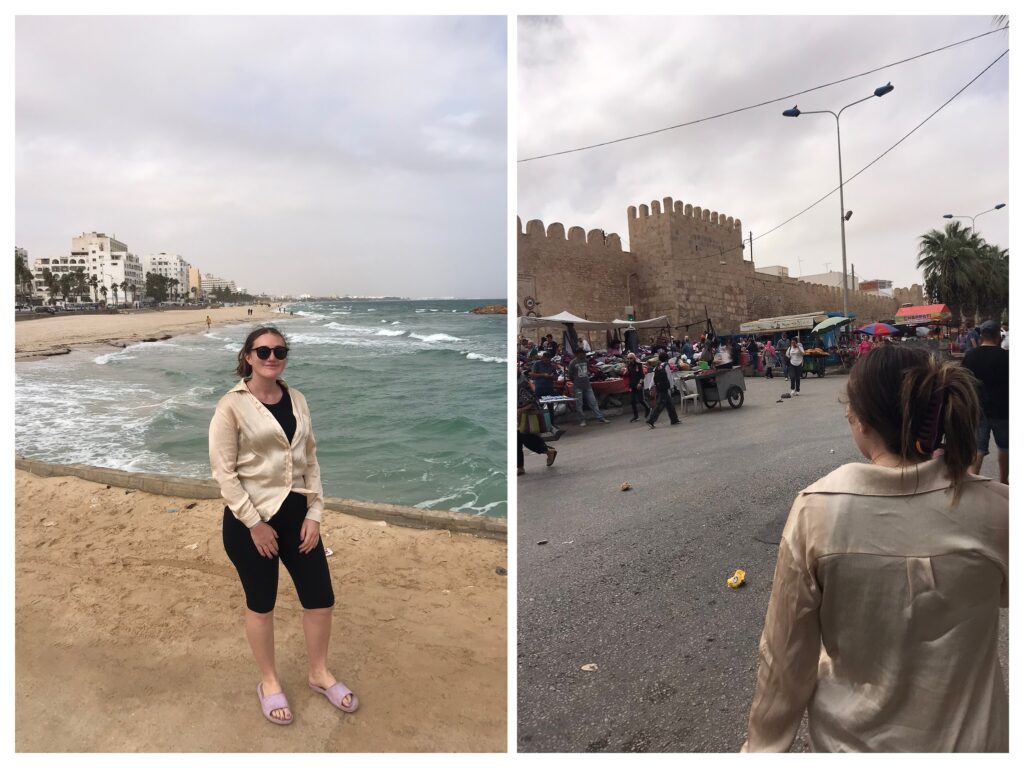
Sousse is a city of two halves, on one side sit the affluent, stuff-yourself-silly resorts, fighting for space along the beachfront. The ‘tourist-zone’ is kept separate from the city centre and bustling medina favoured by locals. After the chaos of Tunis, we decided to take things slow in Sousse, catch up on some sleep and do a whole lot of nothing!.
We did notice the heightened security measures in place at the hotel, security patrolled the beach area and all luggage had to be passed through metal detectors before you could enter the hotel, we imagine this is a consequence of 2015 beach shootings in Tunisia. Sousse was one of the only places that we were overcharged by a taxi driver, but it was only £1-2 so don’t sweat it. Expect to be overcharged if you order a taxi from your hotel to the medina or louage station, the taxi drivers know you have money and will treat you like a tourist because you’re staying at the resort.
How to get there
You need to head to the Moncef Bey louage station in Tunis to catch a louage to Sousse; this was one of the better organised louage stations, don’t expect all louage stations to be this efficient. Moncef Bey services most of the south of Tunisia so if you’re heading southward, this will be the louage station for you
Accommodation
Jaz Tour Khalef – features an excellent buffet (the scales after we came back to attest to this), swimming pool and is literally slap-bang on the beach. The beach area was clean with no stray cigarette butts littering the sand and only the occasional hassler trying to sell scarves from a distance. Staying at such a nice resort made leaving the complex to explore the city of Sousse very difficult. The nightly entertainment was a bit odd at times, one night the animation crew performed an Irish dance but none of them were Irish? Weird! On another night, we watched Karaoke performances from both British and Algerian tourists. It was entertaining to see non-Brits taking to the stage and singing their hearts out in Arabic to Algerian karaoke-favourites.
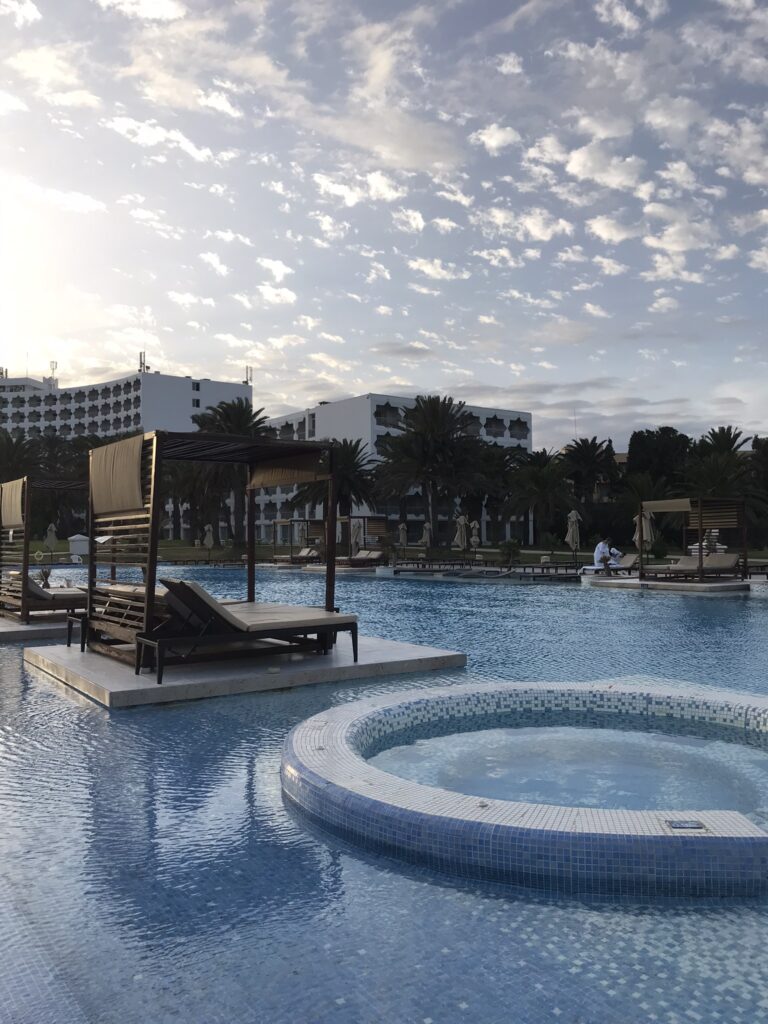
Activities
We did manage to break out of the resort and head to the medina in Sousse, we opted to walk along the beach to reach the medina instead of getting a taxi. We experienced some hassling but it was minimal compared to what you get even walking down the street in Egypt. Tunisians usually respect it when you say no and don’t continue to badger you.
In the centre of Sousse, the ribat provides fantastic views over the medina area and out to sea. You can watch locals going about their daily life in the narrow alleyways lining the medina, a perfect look-out spot.
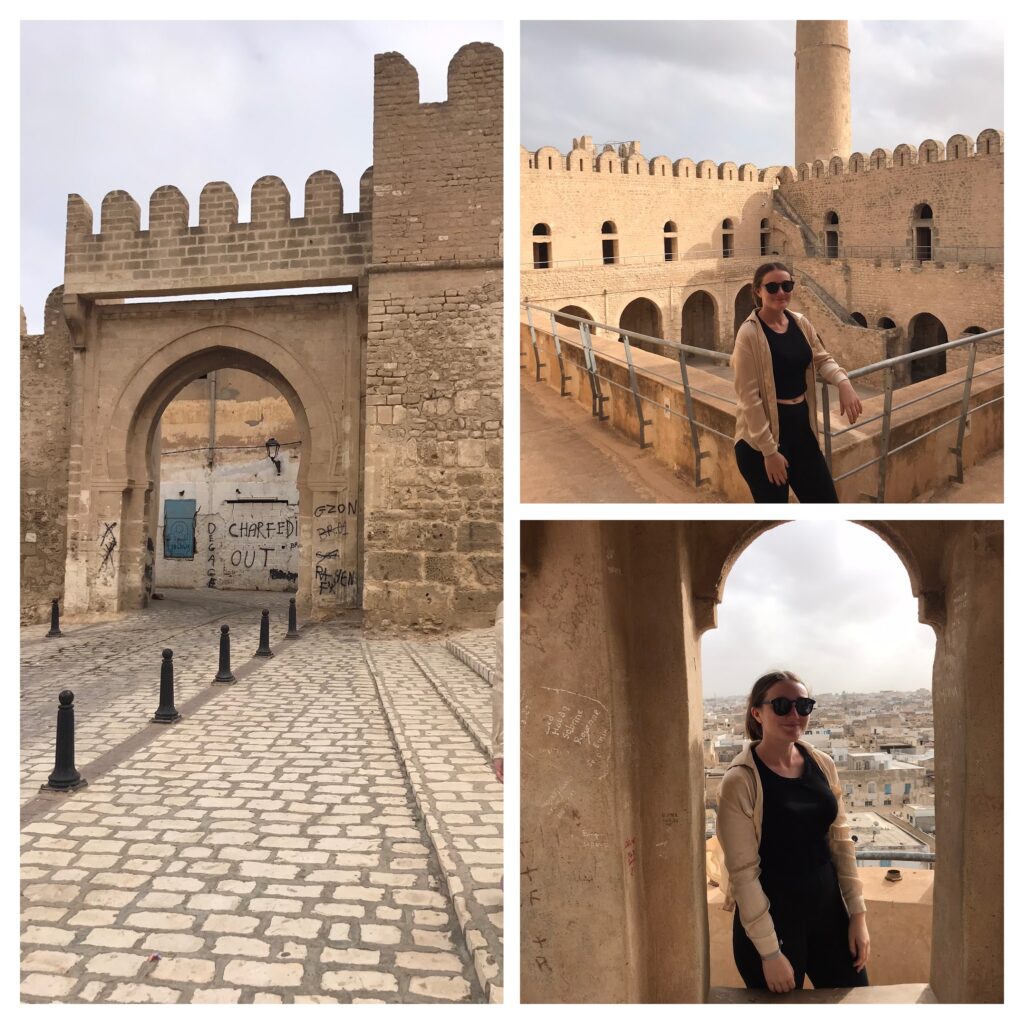
Sousse Archaeological Museum – we were blown away by the sheer amount of mosaics on display here and how well preserved they are. You can even see the shading on figures and original colours. Some of the mosaics are absolutely huge, covering whole walls of the museum whilst others are designed to be in fountains or baptismal fonts. You can even identify types of fish and sea creatures on the mosaics, they’re that intricate and detailed! This museum and Bardo are a must-see if you’re a fan of art.
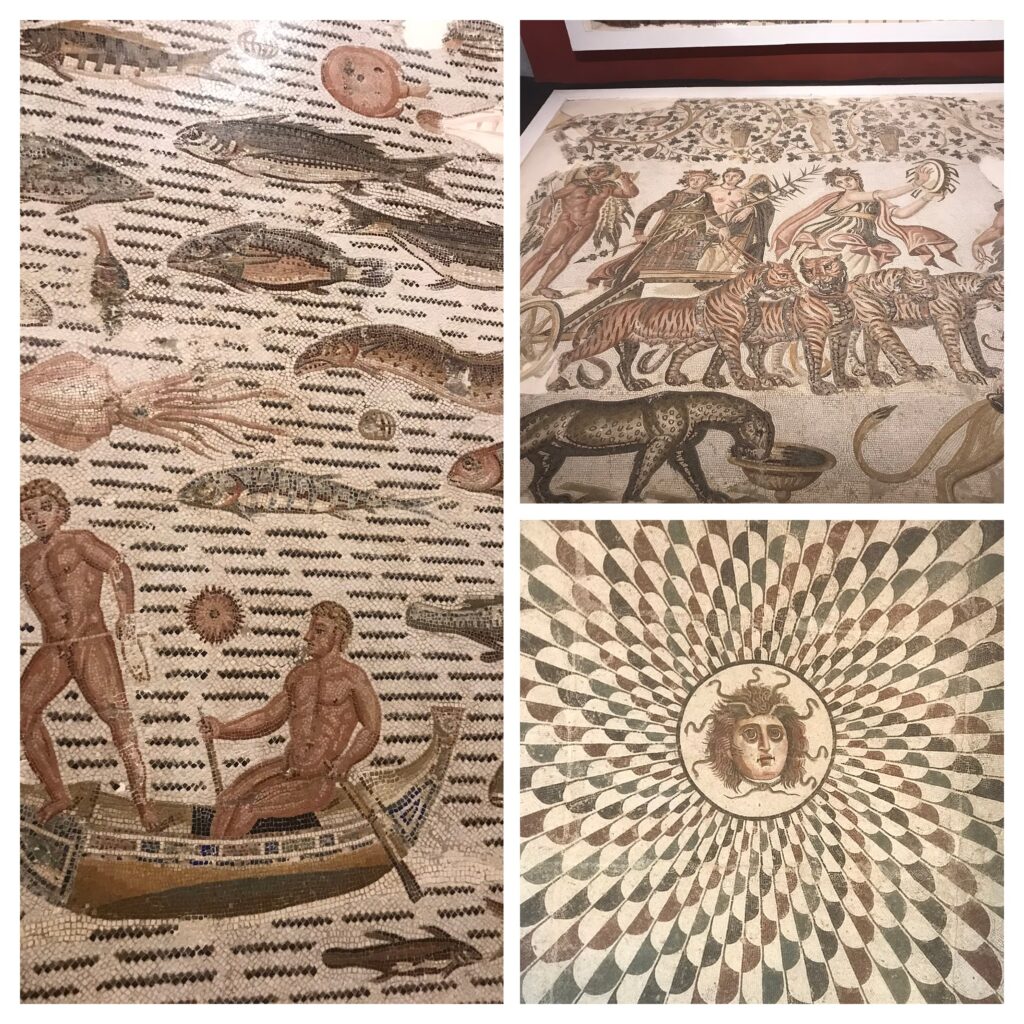
Kairouan
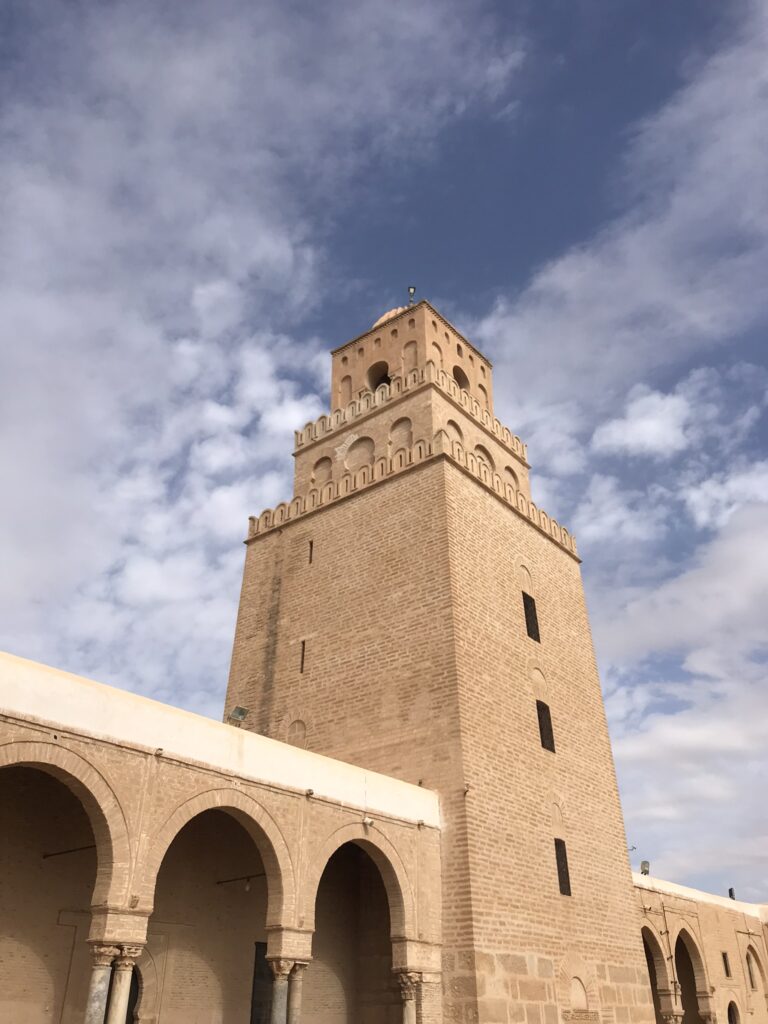
Kairouan, a UNESCO World Heritage site, is one of the holy cities and spiritual capitals of Islam. The Great Mosque is the oldest mosque in the whole of Tunisia and North Africa; it was said to be built around 670 CE at the same time as the city was founded. Kairouan is widely considered the fourth most holy city in Islam. For Muslims, 7 trips here are said to equal one hajj to Mecca. We opted to visit on a day trip, jumping in a louage from Sousse, walking around for a couple of hours and then returning by early afternoon. This worked out well for us as we didn’t spend very long touring the sites in Kairouan, you can easily fit all the below sites into an afternoon or morning. Kairouan is a much less sanitised city than the likes of Tunis and Sousse – expect to see animal carcasses and decapitated cows heads hanging in the streets!
Activities
Great Mosque – in order to enter you need to pay a small entrance fee and adhere to the dress code. Arms must be covered to the wrist and legs to the ankle; this is expected in all mosques across the world. There are usually some spare headscarves by the entrance which you can use to cover your hair if you’re female. For all non-Muslims you can only walk around the courtyard and peek into the prayer room through a doorway. Avoiding prayer times is a must if you visit! The mosque was closed to the public from 2pm.
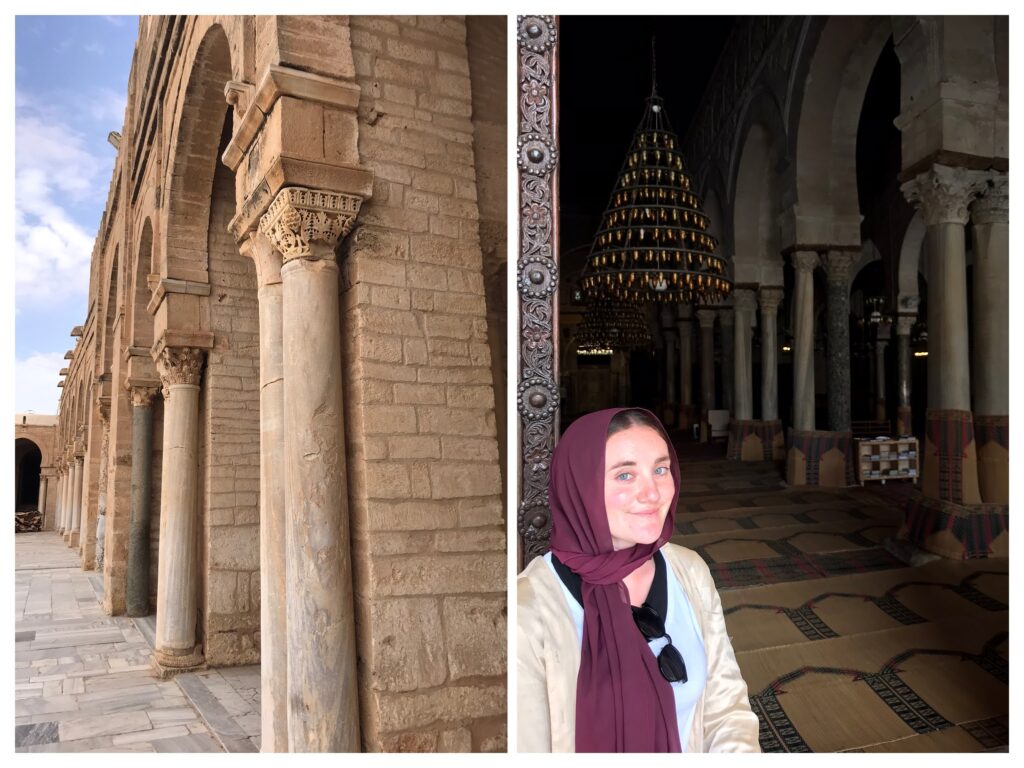
The Great Mosque in Kairouan
Walk around the medina – you can’t beat walking around the medina to have a nosy at the houses and locals getting on with daily life.
Mosque of the Three Doors – non-Muslims can’t enter this Mosque sadly but it is pretty cool to look at from the outside, especially the exquisite kufic writing, as the name suggests it has three doors.
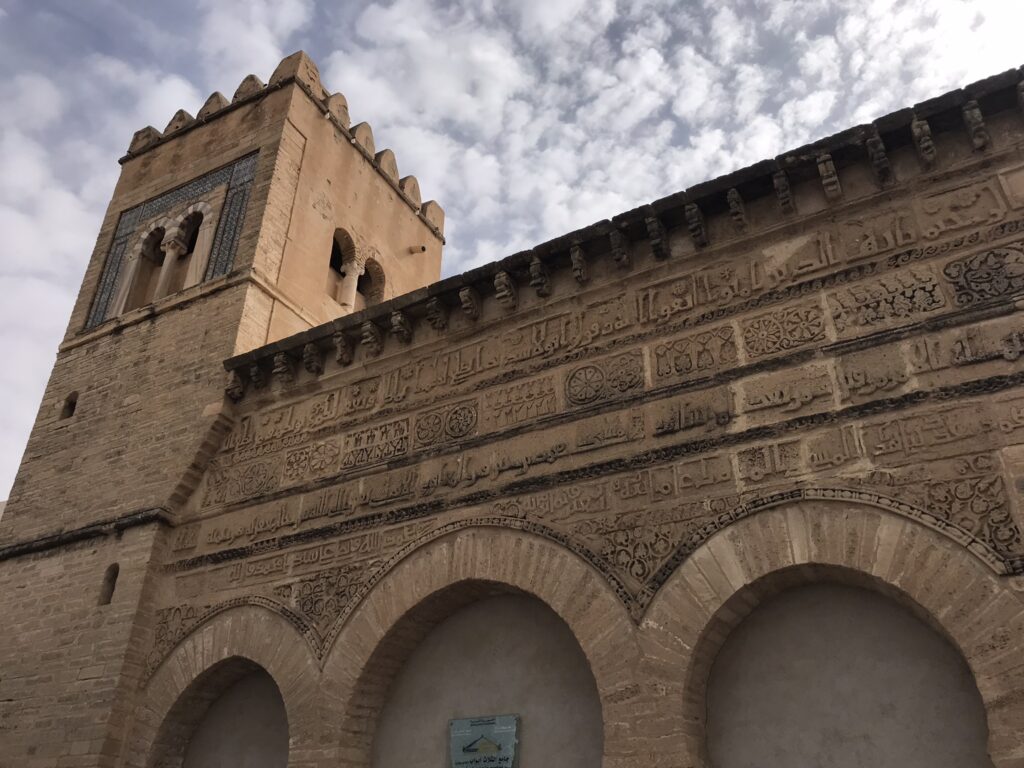
Basins of Aghlabides – not the most exciting attraction but worth a look if you’re in the area. If you head to the tourist information center nearby, you can get a good view of the whole complex from the rooftop. The huge stone basins are surrounded in what I can only describe as bald patches of dirt. The nearby area is not very touristy at all so keep your wits about you if you walk there from the Grand Mosque.
El Jem
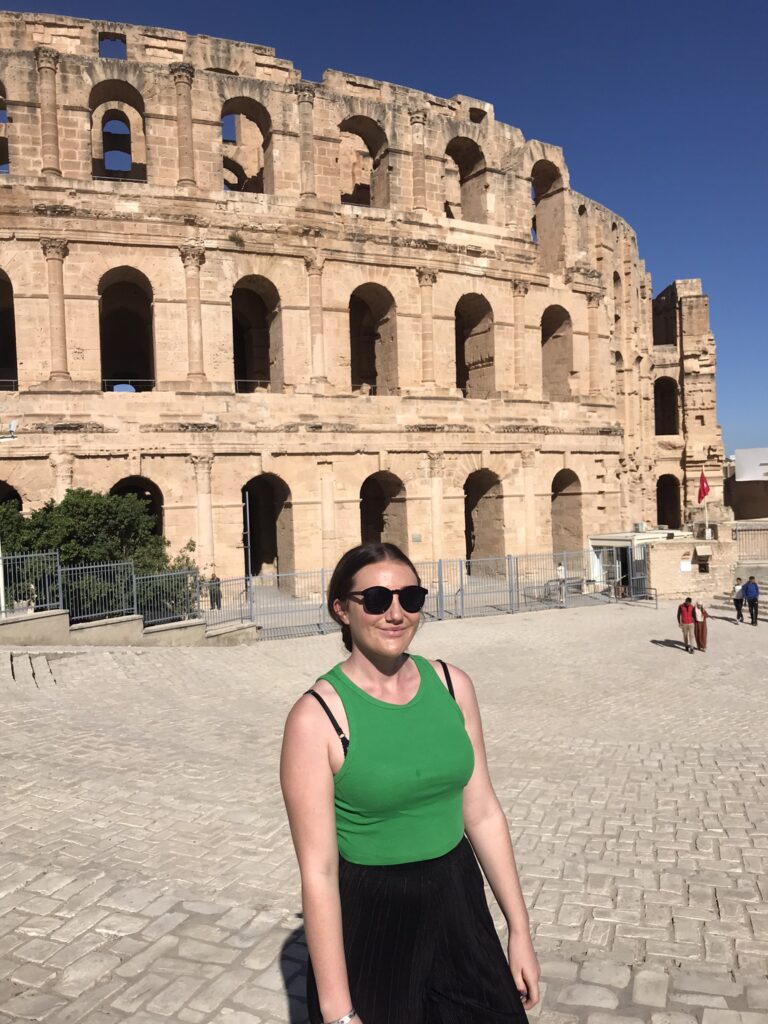
El Jem is literally and figuratively a gem of the Roman world. Looks-wise, El Jem amphitheater is similar to the Colosseum in Rome. You can see the amphitheater from miles away. But unlike the Colosseum, you can explore El Jem without the tourist hordes and even take photos without a single annoying tourist ruining the shot. On top of that, the entrance ticket is less than £3! The amphitheater at El Jem is the second largest of its kind in the world. I recommend taking between 1-2 hours to visit the amphitheater, you can walk freely through the site and explore the underground holding area (which was used to contain wild beasts and hoist their cages through the floor onto the main arena itself), the main arena ground where the action took place, climb the stairs to admire the view from both sides of the seating areas, you can also walk the entire circumference of the amphitheater and admire the magnificent arches and grand construction from the outside.
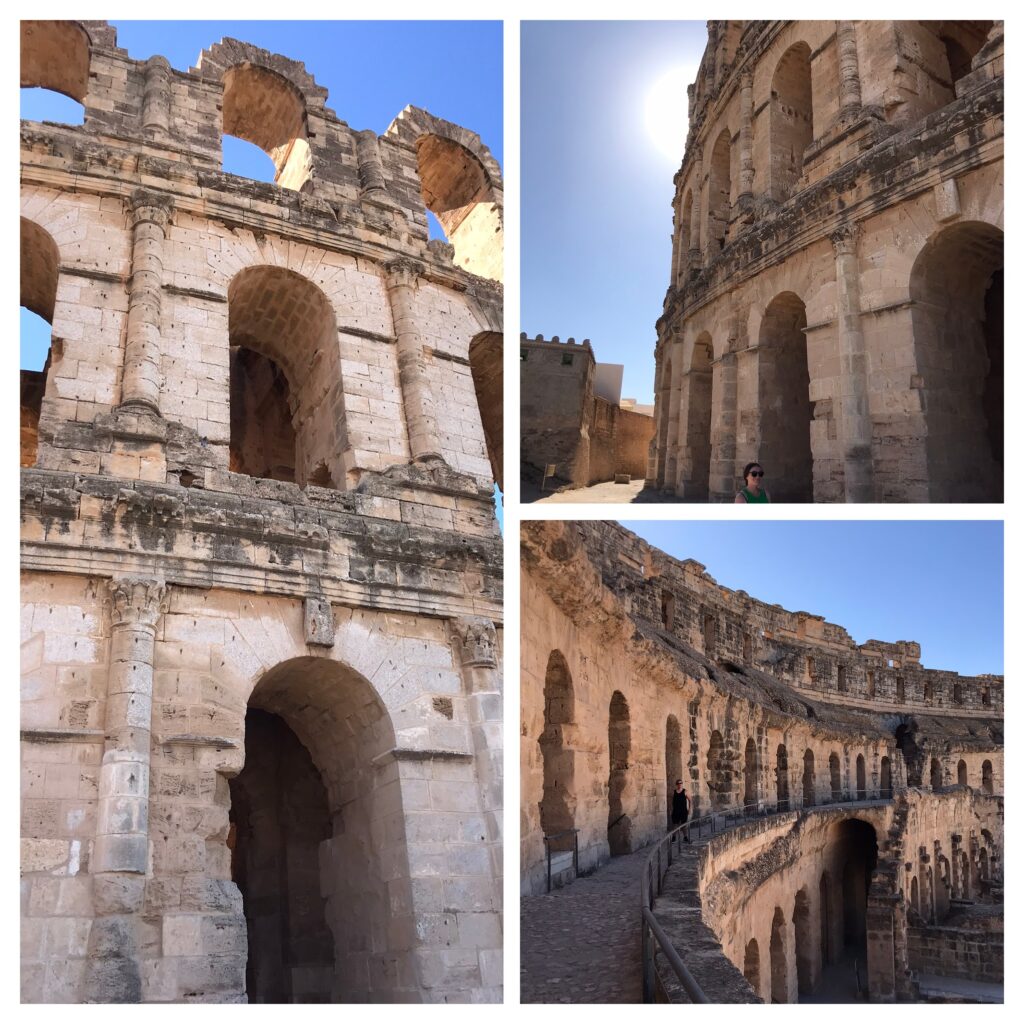
In our experience, outside of the amphitheater if you walked even one block in any direction then El Jem became just a regular Tunisian town. The semi-circle of shops flanking the entrance to the amphitheater is decked out with souvenir shops and restaurants specifically aimed at tourists but once you leave the amphitheater you won’t find any tourists, only locals going about their business. As mentioned above, I made the mistake of wearing a tank-top to visit El Jem which resulted in a strange market-seller trying to caress my bare arm while I was walking about 2 blocks away from the amphitheater on the way back to the station.
We used Sfax as a base to visit El Jem for the day, however it’s possible to travel from Sousse or Monastir too. El Jem is halfway between the beach resorts of Monastir/Sousse and the city of Sfax and you can easily reach it by louage from any of these places. Don’t pin your hopes on getting the train, the trains are very unreliable and unsurprisingly the train back to Sfax was cancelled on the day we visited so we took the louage back instead. This was just after the strange market-seller caressed my arm so we wanted to high-tail it out of there ASAP. Keep your return travel options open by getting to El Jem as early as possible and aiming to leave by early afternoon (i.e. 2pm at the absolute latest). We heard that some travellers miss the last louage and get stuck in El Jem if the train is cancelled as well.
Monastir
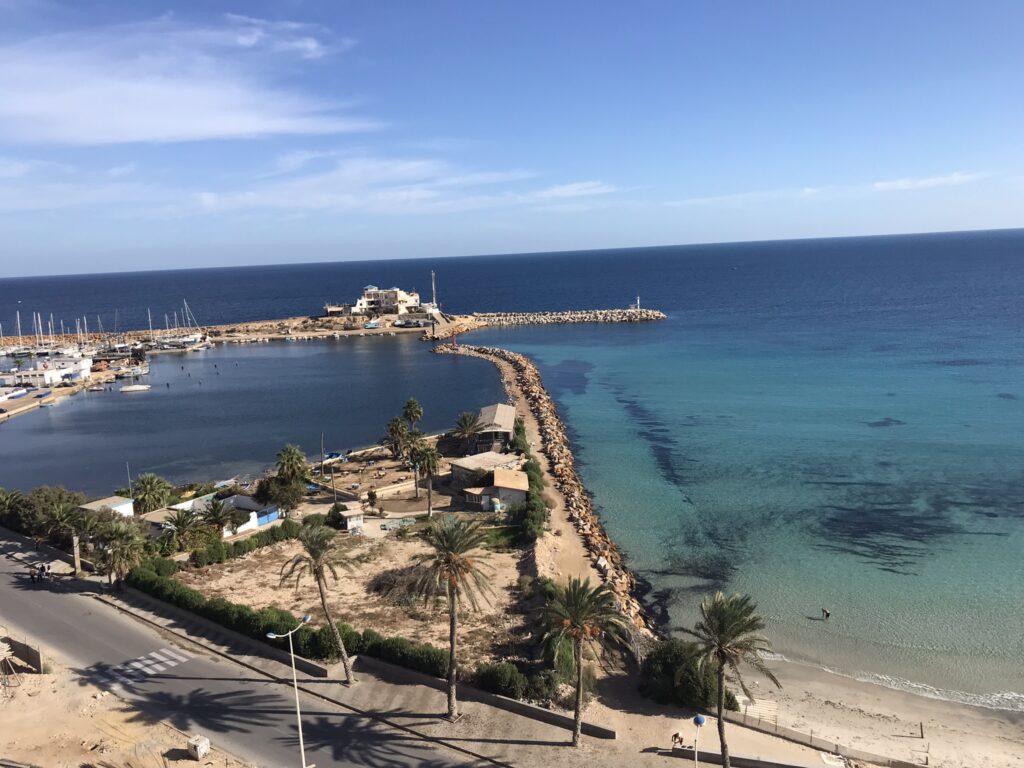
Once a traditional fishing port, this city now boasts an modern international marina area for the rich superyacht class, with package holiday resorts creeping close to the city centre but thankfully still banished to the outskirts. From glimpses out of the window on the way to Monastir, these resorts looked subdued and empty out of season. Monastir is within spitting distance of its sister, Sousse, only 20km up the coast.
Accommodation
Dar Lilia – we only stayed at Dar Lilia for one night however we thoroughly enjoyed our stay. The private apartment was spacious and very good value for money. It felt like a more authentic experience than staying in a hotel. It is very much a local residence with a family downstairs, along with all the noises of the medina outside. It’s only a 5-10 minute walk to the ribat and some nice restaurants.
Foodie Places
Buns n cheese – an unexpected find in Monastir, this place served fast food, mainly burgers and loaded fries, but it was clean, modern (they even had devices that buzzed when your order was ready!) and the server spoke some English which was really appreciated. I loved the loaded jacket potato as I’m a huge fan of jacket potatoes. We ate twice here in 24 hours! It also happens to be just around the corner from the medina and the louage station.
Activities
Mausoleum of Habib Bourguiba – Habib Bourguiba is a revered political and nationalistic figure in Tunisia, he was the last Prime Minister under French colonial rule and first President of Tunisia after it cast off its colonial chains in 1957. He led the nation to independence from France and through this transitional period so is considered a national hero. His resting place in his hometown of Monastir is an opulent, white marble mausoleum with twin minarets and a golden dome. Inside the mausoleum you can see photographs of a young Habib Bourguiba and his family as well as photos of him alongside various world leaders during his 30 year presidency. There is also a collection of his private belongings such as a pen gifted from Ronald Reagan, glasses, formal attire and his desk. The mausoleum is free to enter however is closely guarded, you should treat this place with respect as it’s a place of pilgrimage for many Tunisians to pay their respects to the man that led their country to freedom.
Ribat – the ribat (Islamic fortress) in Monastir is one of the largest in Tunisia and is a vast complex which also contains a small museum of Islamic art inside. Trying to find the way out of the ribat is quite a challenge with the numerous small staircases and rooms. You can climb the tower to reach the pinnacle of the ribat, this offers 360 views over the nearby Grand Mosque of Monastir and Al Qurayyah beach. Be aware that it’s quite windy at the top and the stairs are narrow, winding and not ideal for anyone with walking problems.
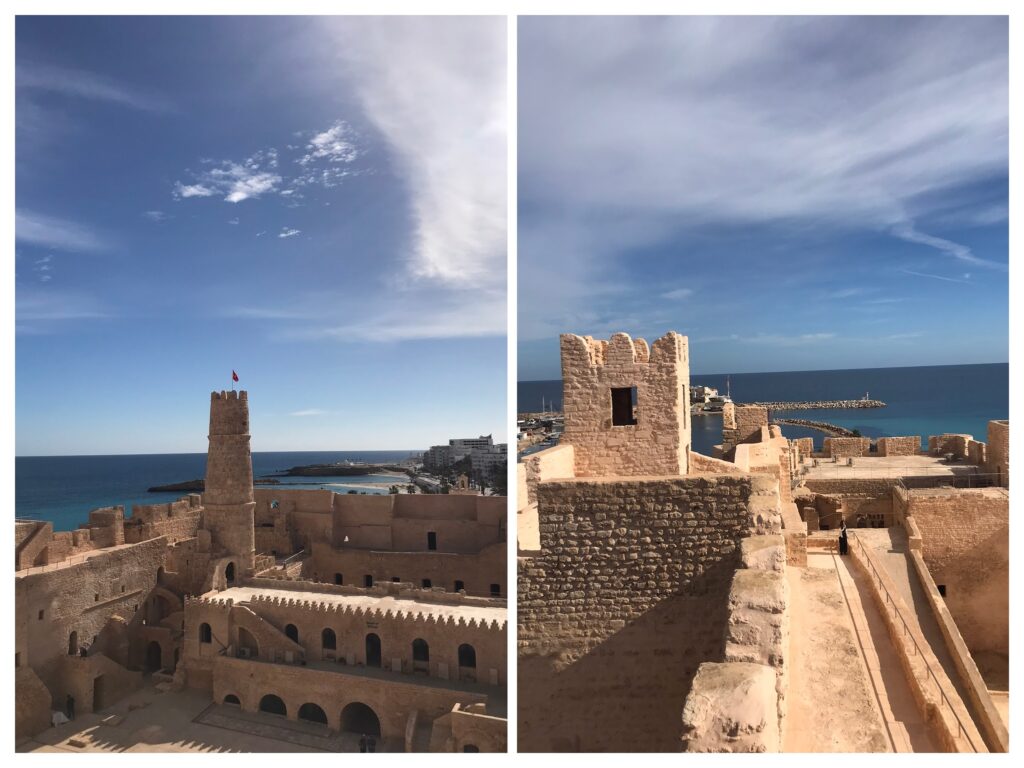
Marina – a nice place to take a stroll and watch the sun set, this whole area is teeming with restaurants which cater to the international boating class.
Sfax

Despite being a large city, Sfax is about as non-touristy as you can get. We were approached by two French tourists whilst enjoying a beer on the rooftop of the Radisson and asked ‘what’s there to do in Sfax?’ We could only answer honestly by suggesting day trips to El Jem or Monastir which are both nearby. One thing I can recommend if you want a real medina experience and not a tourist trap is to head to Sfax medina and experience the chaos, if you dare! You won’t find any lost tourists here, only locals shopping, chatting and watching the world go by. You definitely won’t find any quaint cutesy white and blue houses! Sfax is a gritty place which has seen an influx of sub-Saharan African migrants. We used Sfax as a base to get to El Jem.
Accommodation
Radisson Sfax – A real 5* hotel unlike other some other African hotels we’ve stayed in that aren’t really 5*. We were greeted with an arrival drink and made to feel right at home. I especially loved the spa bath, lotions provided and the rooftop bar/swimming pool. Hand on heart I can say this is the best hotel room I’ve stayed in after visiting over 50 countries.
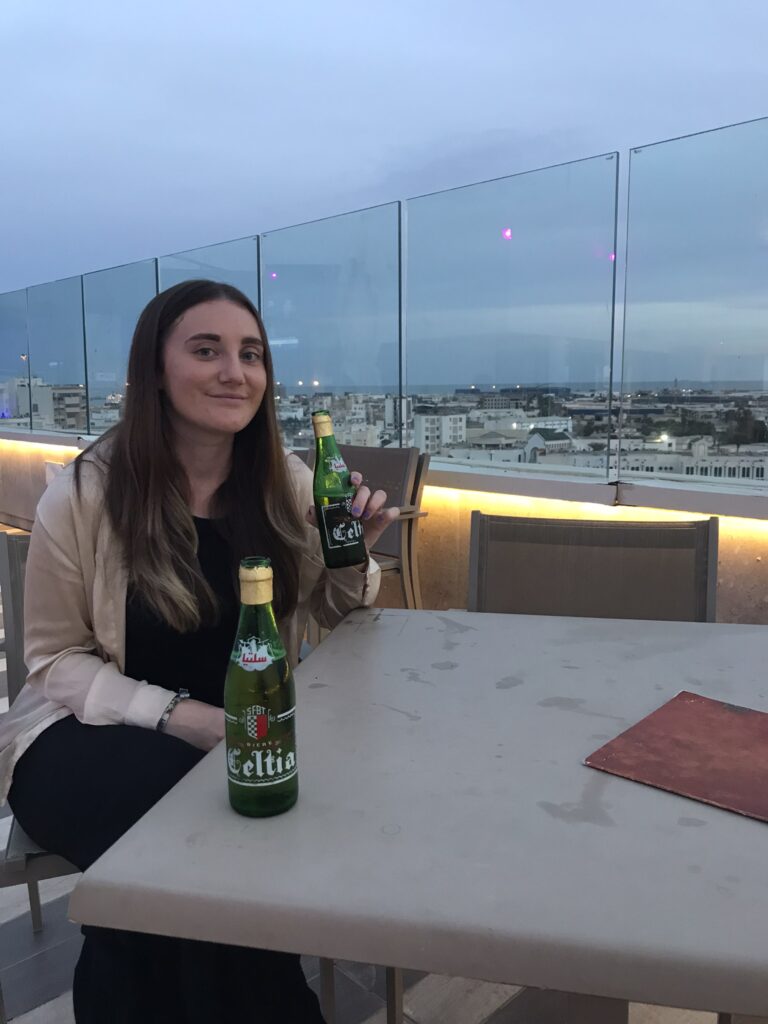
Foodie Places
Cafe Seven Days – This is the perfect place to have breakfast if you’re staying at the Radisson. We had a breakfast combo including juice, coffee, omelette, ojja, pain au chocolat, chocolate pancakes and water for 15 denar. There are cheaper combos available too. Hands down the best breakfast I’ve eaten in Tunisia! The cafe is open early and close to the louage station. The owner/waiter spoke surprisingly good English so we were very happy.
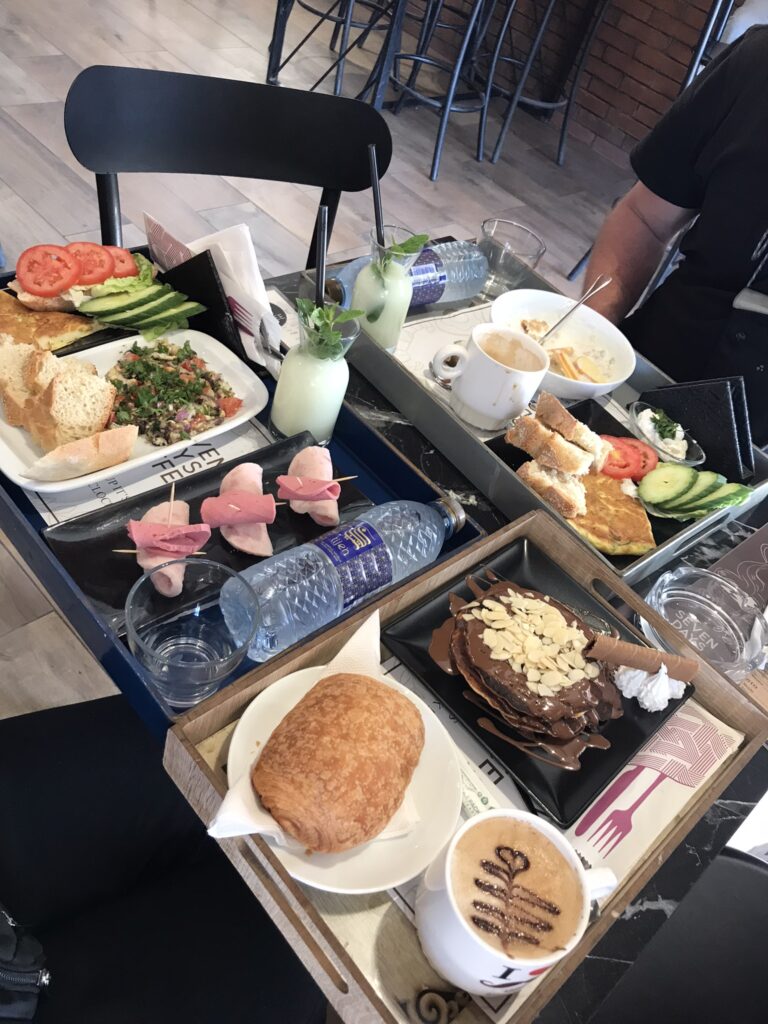
Best breakfast at Cafe Seven Days
Caffeine – a refined French-style cafe to enjoy a coffee and cake, the prices are slightly higher than average in Tunisia but you pay for the genteel setting. They do serve sandwiches and salads which is handy if you’re hungry for something other than cake.
Resto Bistro Club Maximos – a typical fast food restaurant, you can order sandwiches, pizza, burgers and french tacos.
Farm Slice Sfax Aljadida – a modern establishment with a ridiculous amount of different pizza options on the menu.
Tataouine
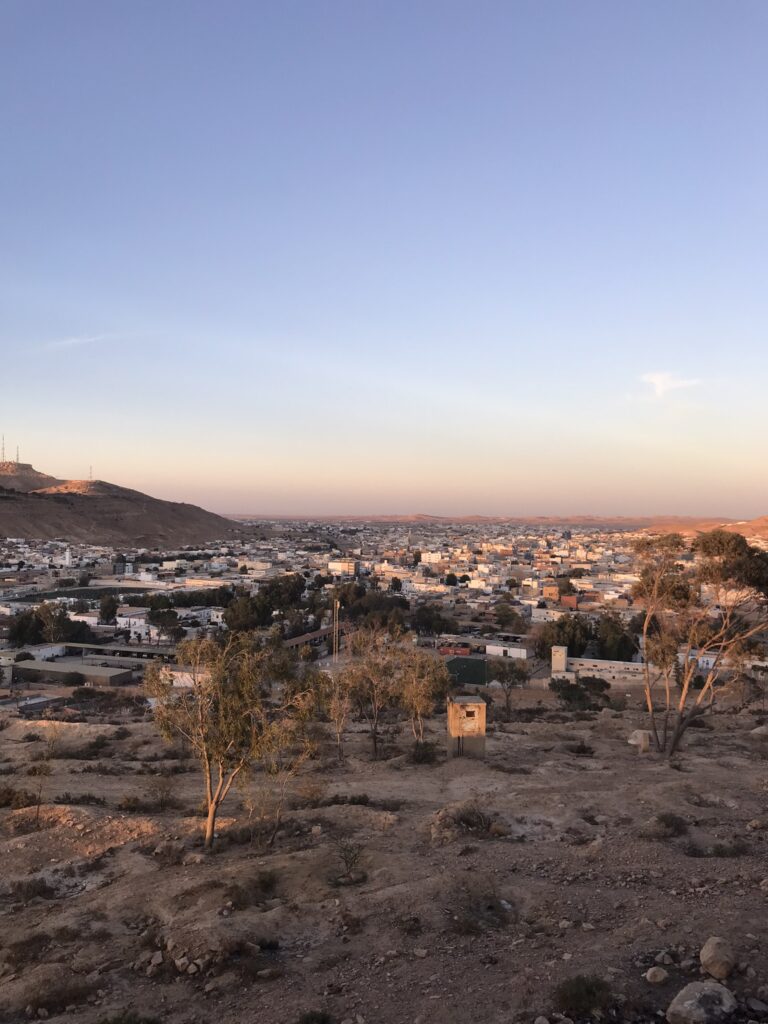
We found in particular in Tataouine that locals were in equal measure inquisitive and eager/excited to help wherever they could. Children often stared at us as we walked past and the eyes of coffee-drinking men also followed us as we passed by. On one occasion we were walking back from Castello restaurant in the dark when a car idled next to us and the driver (a young boy-racer type guy) said hello and asked us if we needed any help. This level of friendliness isn’t what we usually encounter when traveling. We could only assume that they don’t usually see many tourists in Tataouine.
The troglodyte cave-dwellings and nearby Ksars (fortified Berber settlements) of Ouled Soltane, Chenini and Douiret make Tataouine an ideal base for tourists to the region. For all the Star Wars geeks out there, Tataouine is the inspiration for Tatooine, otherwise known as Luke Skywalker’s home planet.
Accommodation
Dar Essadeg -This is the point where I rave about Sadok, the owner of Dar Essadeg. Sadok (our hero) not only picked us up from the louage station, he also gave us a tour of his apartment, proudly declaring this apartment was his family home and that his daughter had been born here. He helped out with transport and food recommendations, he also showed us how to turn on and use the various appliances, he even gave me a demo of how to wear a traditional winter cape (originally made with goatskin) and explained that in times gone by locals used it almost like a tent to keep warm.
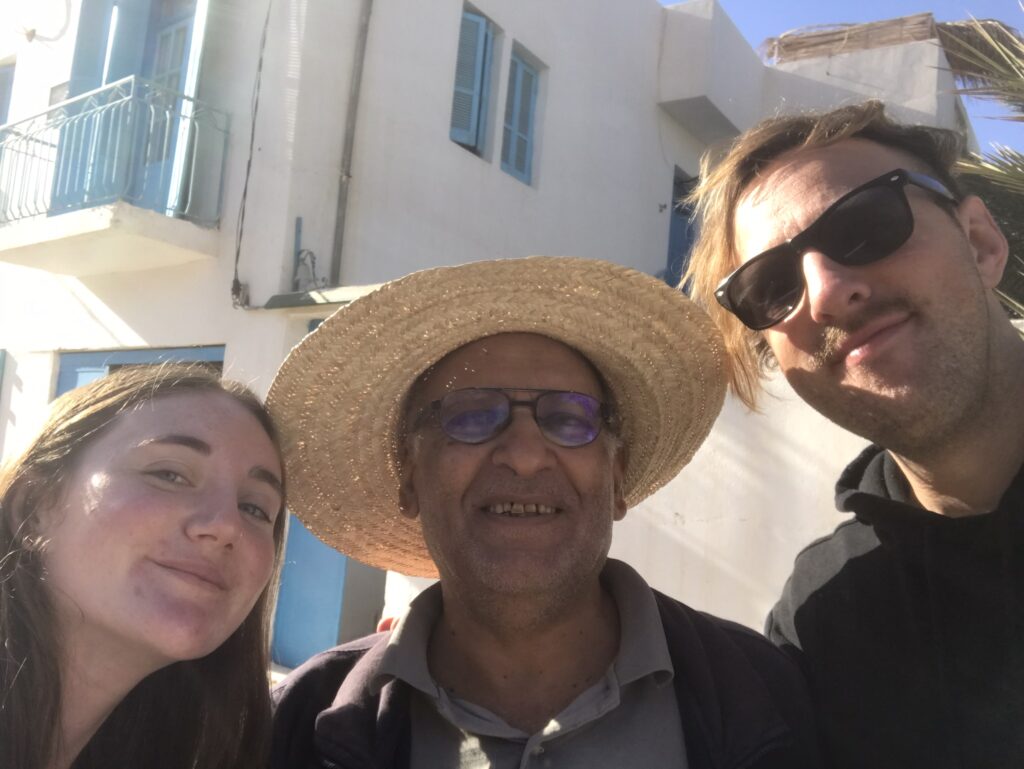
The main man, Sadok
Foodie Places
Resto Castello – this place was recommended to us by Sadok. You’ll struggle to find this restaurant on google maps, Castello is located here (32.928993, 10.446162) along the main road. At first I was a little uneasy to try this restaurant as we couldn’t find any information or reviews about the place at all other than the recommendation from Sadok, but we decided to give it a chance. The place does not seem to be the most inviting from the outside and the menu is entirely in Arabic, however don’t be put off as the owner will happily explain what is on the menu in English. We opted for rotisserie chicken and pasta, both dishes were delicious and of fantastic quality. In the end the bill only came to around £5 for both meals, which blew us away. Not only was the food tasty and cheap, but we realised during the meal that the major reason for this recommendation is that Castello provides work and purpose for the staff, all of whom are deaf or have hearing impairments. It’s a great project to support and I hope it continues to thrive!
Al Bacha – a bakery that also serves crepes and pizza, ideal for picking up a quick snack. This bakery is a great place to purchase special Tataouine pastry treats.
Activities
Ksar Ouled Soltane – you need to catch a local louage from here (32.927712, 10.447503) to get to both Ksar Ouled Soltane and Chenini/Douiret. We were told that the louages run until 5pm to Ksar Ouled Soltane and we caught one around 3pm with no problem. We met two local women in the louage and they showed us around Ksar Ouled Soltane. Our little tour mostly consisted of wandering about the Ksar and drinking mint tea in a cafe/cave. It’s worth noting that there is one souvenir shop and an artists workshop/gallery where you can have a look around and/or buy souvenirs.
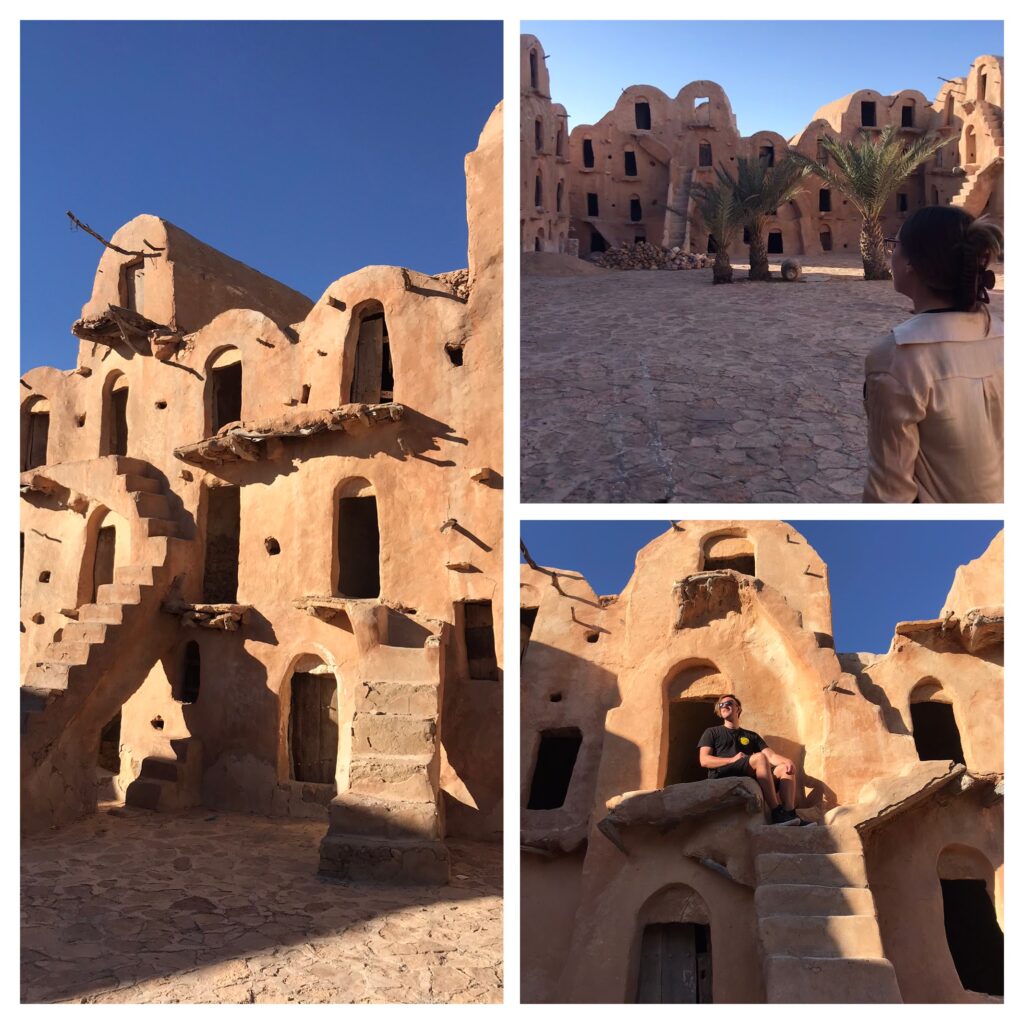
Ksar Ouled Soltane – a highlight of the trip!
Gsar al-Dagaghra – a short uphill walk from the city center to Gsar al-Dagaghra, an excellent spot to watch the sunset and absorb the views over Tataouine and the valley beyond. You can also take a peek inside the hilltop Ksar here, when we visited the place was deserted and after sunset it was starting to get dark so we left sharpish as it was a bit creepy!
This section is now available on GPSmyCity!
Chenini & Douiret
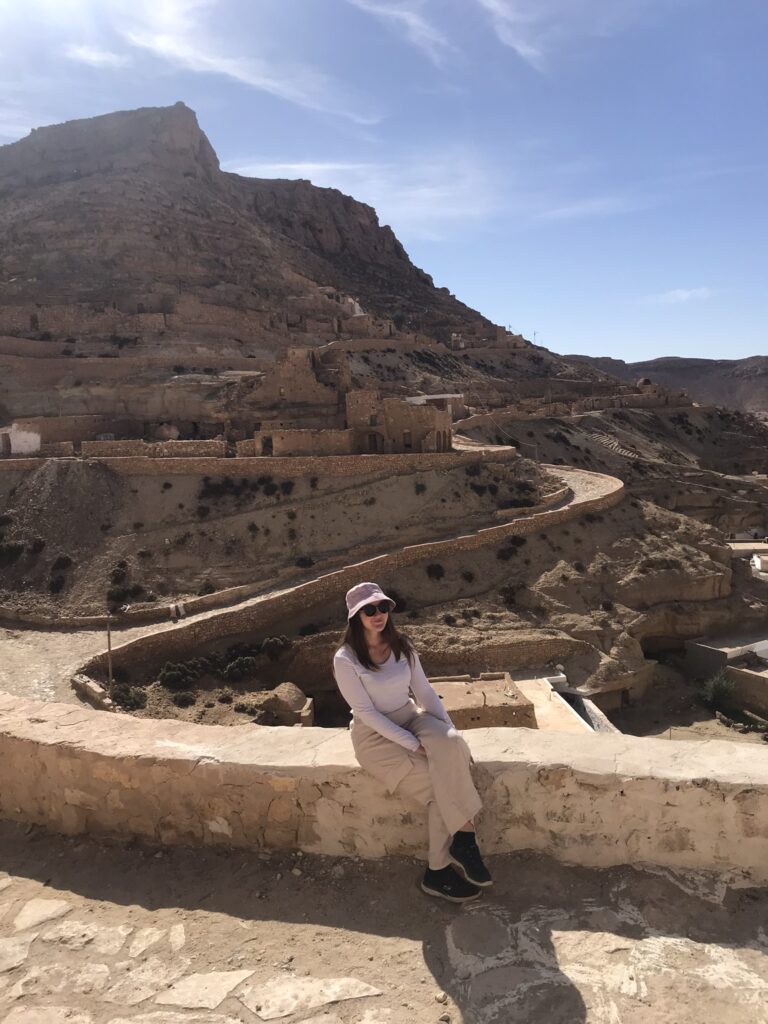
Chenini and Douiret are picturesque traditional berber villages in the mountains near Tataouine. Both Chenini and Douiret can be visited by public transport from the local louage station in Tataouine, however they are both quite remote with only limited facilities. Both Chenini and Douiret have a ‘new’ town nearby where most of the residents now live, as well as the traditional mountain village containing the abandoned Ksars and troglodyte houses. We chose to stay in Chenini and trek through the hills to visit Douiret, which took about 3 hours. This was maybe not the best idea as we had a wild experience getting back to Chenini. We had hoped to get some assistance calling a louage or taxi from one of the few troglodyte hotels in Douiret but when we arrived there was nobody around, we then walked to ‘new’ Douiret but were scuppered by seemingly having missed the last louage back to Tataouine and so ended up sitting on the curb going over our very limited options. We were approached by the owner of the nearest home, an elderly gentleman, we asked via google translate if he knew anyone that would take us back to Chenini for 20 TND and it actually worked! I’m not sure if the driver was a friend or relative of the elderly gentleman but we were over the moon to get out of that situation. The man even offered us tea and introduced us to his wife and family while we were waiting.

Chenini at dusk; the ceilings of the abandoned dwellings still have inscriptions visible
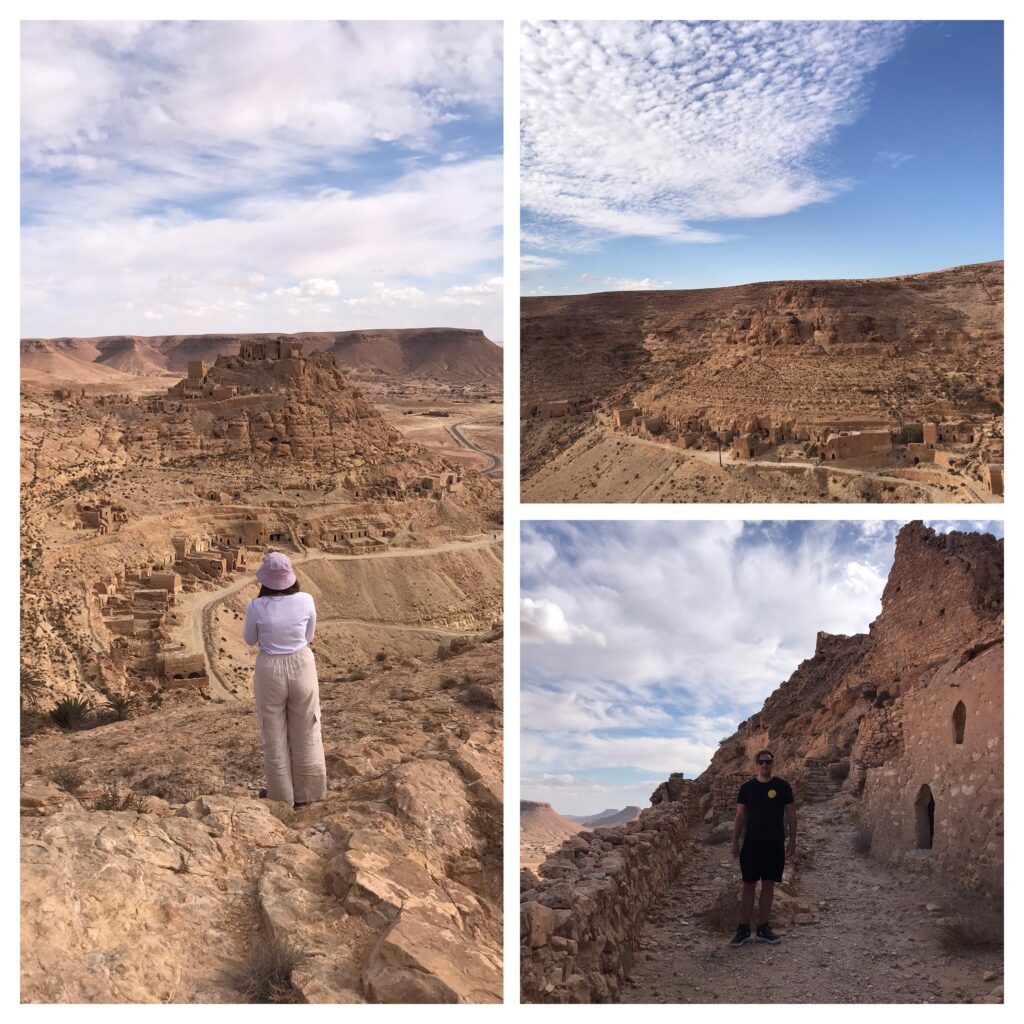
Douiret – Berber caves line the cliff edge
Tips for visiting Chenini and Douiret without a car
- There isn’t a louage or taxi service from Chenini directly to Douiret. You have two options for getting from one to the other, you can either transit by louage through Tataouine i.e. go from Chenini-Tataouine-Douiret or trek from Chenini to Douiret. I can’t tell you how often the louage leaves for Douiret from Tataouine as we didn’t choose this option.
- DO NOT rely on getting a louage from Douiret back to Tataouine after 2pm like we did. There aren’t any, we found this out the hard way!
- Don’t get stuck in Douiret, we knocked on the door of a troglodyte hotel in Douiret but no one was there so don’t count on help from them. If you’re worried about making it back to Chenini like us, it might be best to pre-book a room at one of the troglodyte hotels just so you know you’ve got somewhere to stay.
- There are no real cafes or restaurants in Douiret – bring your own snacks and water.
- There are a couple of dining options in Chenini; Mabrouk Restaurant, Kenza (a cave hotel that also serves food) and a cafe at the top of the hill, this cafe offers great panoramic views over the abandoned settlement of old Chenini, neighbouring white mosque and valley below.
- You won’t be able to hitch-hike from Douiret to Chenini as there is literally no traffic between the two of them.
- You can trek through the desert landscape between Chenini and Douiret, returning by the same trail if you set off early enough. Simply head for the Mosque of the Seven Sleepers and catch the trail from there. A friendly guide at the Mosque gave instructions on how to get to Douiret but we totally lost the trail and ended up walking as the crow flies, up and down endless rocky hills towards Douiret. We definitely picked the most challenging route but we did eventually join back up with the trail near Douiret. Maybe we were just unlucky and took the wrong turn somewhere.
- When trekking to Douiret, the most important advice I can give is that you need to leave Chenini early in the morning in order to reach Douiret (this should take between 2-3 hours), have a look around (approx. 1 hour) and then retrace your steps back to Chenini, taking another 2-3 hours depending on how lost you get. We royally messed up as we didn’t reach Douiret until 2pm and by the time we’d looked around it was too late to walk back to Chenini before sunset.
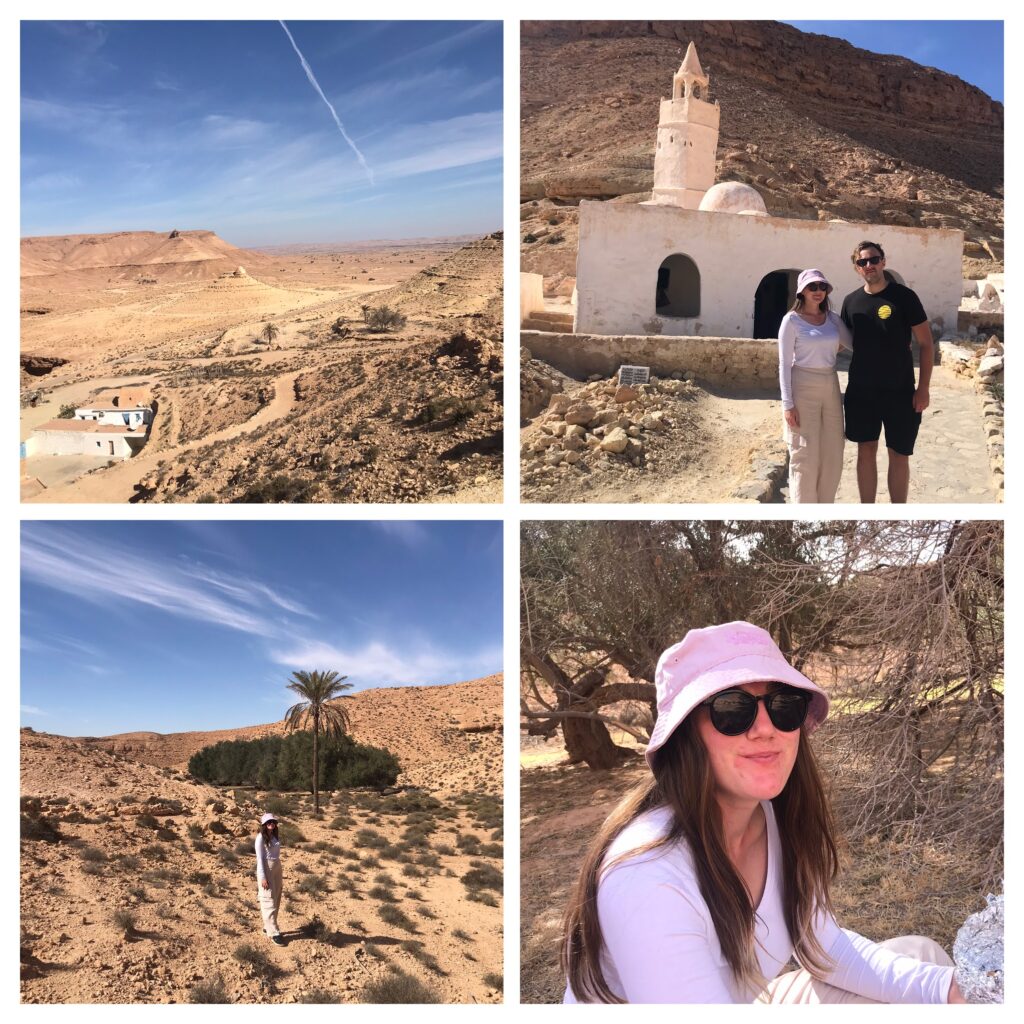
The long and arduous trek to Douiret
Accommodation
Kenza – We really enjoyed our experience staying in a gite (cave-dwelling). The room had all the modern necessities such as power outlets, extra blankets, a fan, a heater and private bathroom. It’s an experience in itself just staying in the room and paired with the views over Chenini, it’s a worthwhile experience. We watched the sunset and sunrise; I cannot explain how beautiful it was. The town itself is mostly deserted but is super peaceful except for occasional cockerel cock-a-doodle-dooing and donkey braying. The staff at Kenza were very helpful, even arranging a picnic for us to take with us on the trek to Douiret. We had a fantastic dinner in the cave restaurant, the food was delicious traditional fare i.e. soup, brik and stewed chicken with chickpeas.
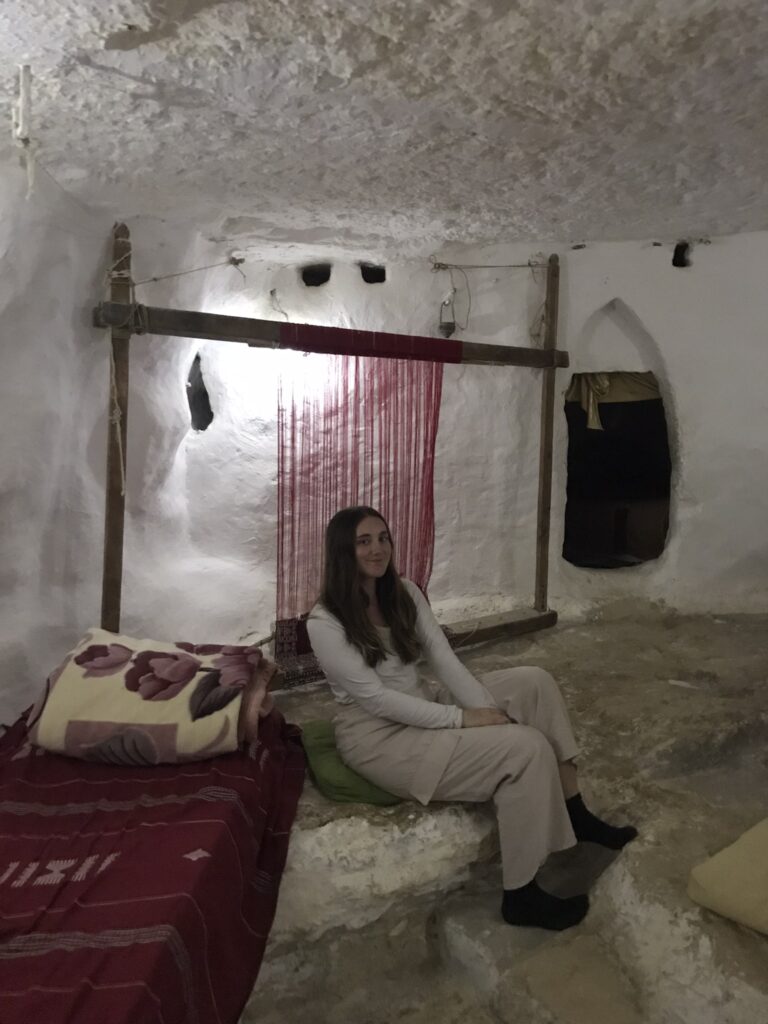
Djerba
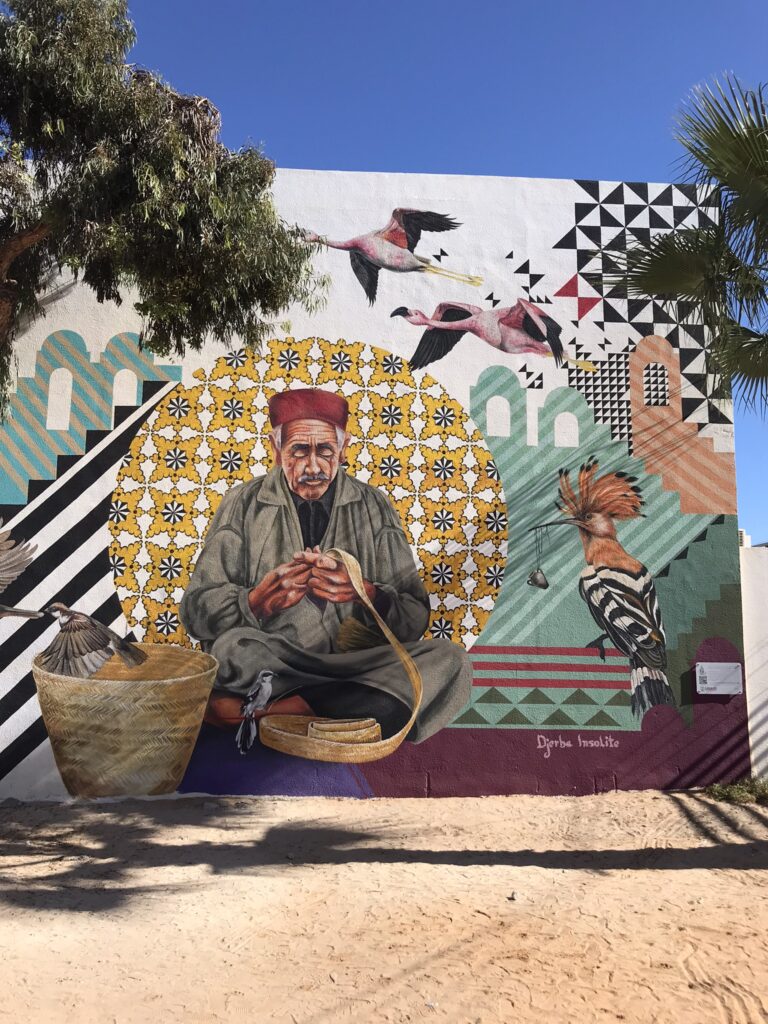
After the mad dash through Sfax, Tataouine and Chenini, we were in need of some R&R and Djerba was the perfect place to indulge in these. The louage journey from Tataouine to Djerba was filled with vistas of endless rows of olive trees, planted in precise straight lines with families and workers harvesting the olives or sprawled around having a break. We got truly sucked into resort-life here during our 3-day stay, only managing to see the basics in Djerba.
Djerba is actually an island, connected to the mainland by a narrow road with police check-points on either end. The weather is good here for most of the year, making it a favoured destination for the tourist hordes that descend from Europe for some winter sun.
Accommodation
Sentido Beach Hotel – we stayed here as we got a great deal on the all-inclusive package, which was cheaper than most of the basic rooms or Dars that we could find elsewhere in Djerba. However both the food and drinks were pretty average in comparison with the other resort we stayed in, Jaz Tour Khalef in Sousse, and being confined to the resort did diminish the experience on Djerba a little. We were impressed by the pool area and proximity to the beach, the hotel sat directly on the sand which was very convenient. It was a nice experience dining outside on the terrace to the sound of waves crashing. The hotel is firmly situated in the ‘tourist zone’ in Midoun alongside many other resorts that sit side-by-side along the coastline. Most of these other resorts were closed when we visited so it was practically a ghost-town of dark, ominous resorts along the beach. We didn’t meet any English tourists in this resort, it was mostly Eastern Europeans and Germans. Dan wasn’t keen on the overwhelming number of old age pensioners walking around the reception area in their speedos or flimsy bikinis, it was definitely an eye-opener! It was almost like the resort had been taken over by the over 60’s en-mass. We were the youngest guests by about 30 years! If you want a laugh, read some of the google reviews for Sentido Beach!
Activities
Djerbahood – you need to catch a taxi to get here as there aren’t any louages we’re aware of, we simply told the driver ‘Djerbahood’ and he dropped us off in the main square which was ideal for further exploration.
Djerbahood is like a living art gallery. In 2014, artists from around the world gathered as part of an ongoing project in the village of Erriadh to leave their mark on the village; they left a staggering 250 murals in the town. Everywhere you walk art is on the walls, homes and shops of the residents. Hidden in nooks and crannies or glaring in plain sight, interesting works of art surround you everywhere you turn. Djerbahood is well worth a visit if you find yourself in Djerba.
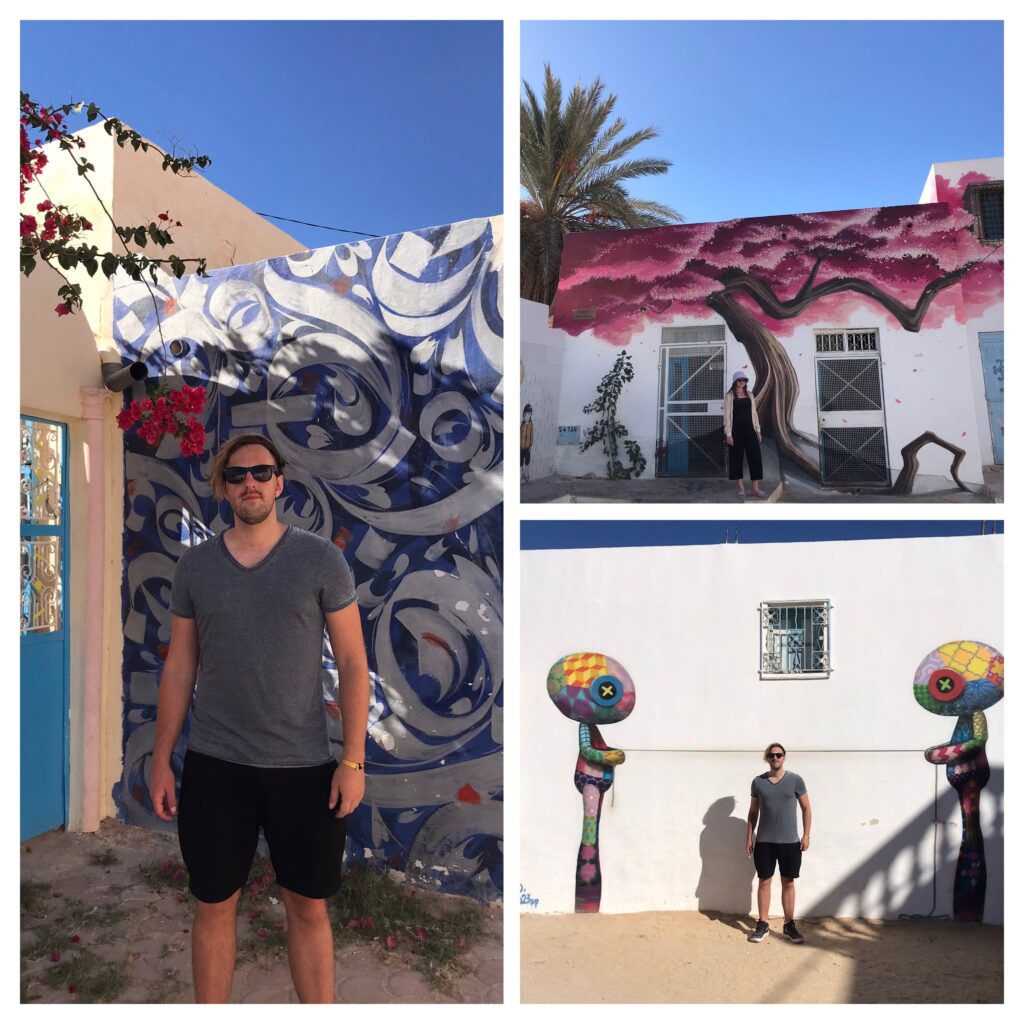
Houmt Souk Medina & Market – this area is very clearly geared up for tourists, it’s extremely sanitised and not like the other medinas in Tunisia at all. We encountered mostly souvenir shops and slightly pushy stall-holders trying to get you to come into their shop. If you want to pick up a souvenir, it’s definitely worth a visit but if you’re searching for a more genuine experience, go somewhere else.
Horse-riding along the beach at sunset – as you may or may not know it’s physically impossible for me to resist a horse-riding excursion, especially one that involves galloping along the beach on horse-back. It’s also possible to go swimming with the horses, I’m not sure how much of this involves you actually swimming or the horse swimming. We were approached by a friendly guy on the beach called Nino and we arranged the activity directly with him rather than using a Tripadvisor or a tour agency as it was much cheaper and we could see that he was genuine and treated the horses well. I’ve never galloped so fast, I swear!
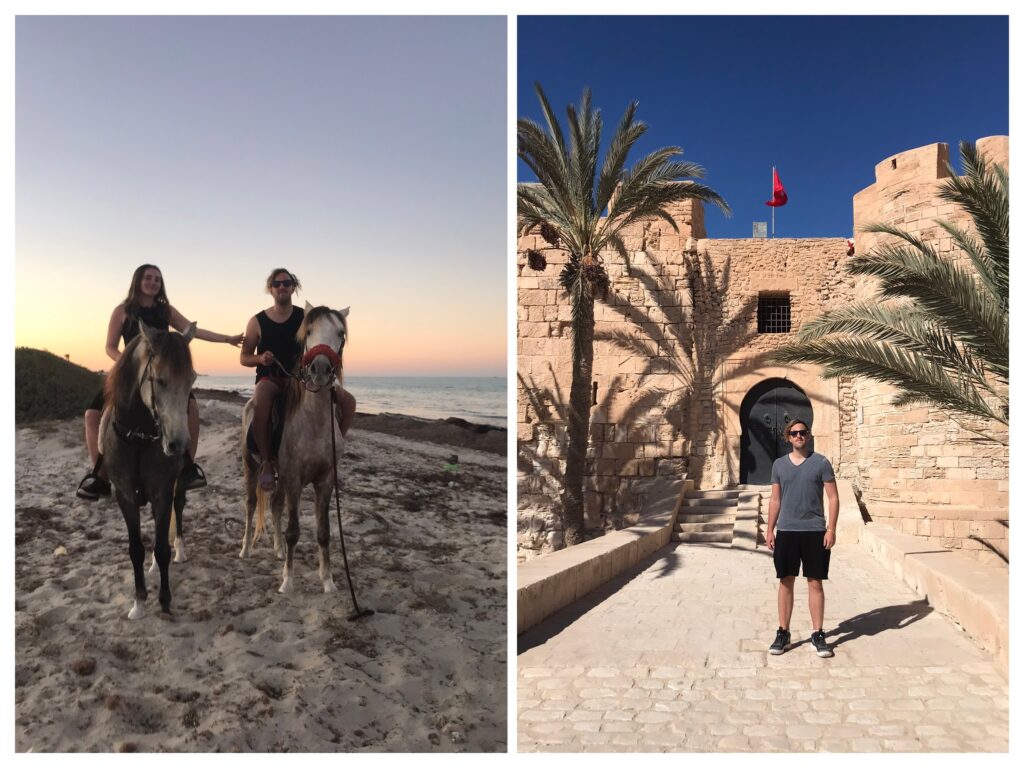
We noticed that horse and carriage owners would wait outside the resorts for business, we didn’t do this as we always prefer to walk to our destination rather than pay to be driven wherever possible. However, we did notice some tourists aboard these carriages and I can imagine that it would be a nice activity if you want to have a look around whilst avoiding getting sunburnt to a crisp.
We visited Homt Souk on a Friday and both the ribat (Gazi Mustapha) and Djerba museum were sadly closed so I can’t comment on those attractions. We did walk around the outside of the ribat, frustrated it wasn’t open, and saw flamingos in the sea directly across from the ribat which was an unexpected treat. It is possible to take a taxi to visit Flamingo Island, which is actually a peninsula a little further down the coast from Homt Souk.
One thing we appreciated on Djerba was that the taxi drivers were all very honest, always using the meter and charging the correct amount. This was a surprise as Djerba is a very touristy place, I imagine there was some effort by the local authorities to ensure that taxis were not scamming tourists. If only it was like this everywhere!
Toujane

Toujane is about as far off the tourist trail as you can get. It took tenacity and a stroke of luck to reach Toujane without a car. There isn’t a whole lot to do in Toujane itself except strolling through the village, waving to children and smiling at locals milling about, and walking into the lower valley area with the ruins of the old village. You’ll meet more goats and chickens than people here. Life hasn’t been touched much by modern technology, you’ll still see locals tending their cattle, some living in traditional cave dwellings, transporting water on the family donkey.
Slowing down and absorbing the bucolic atmosphere is the best thing to do.
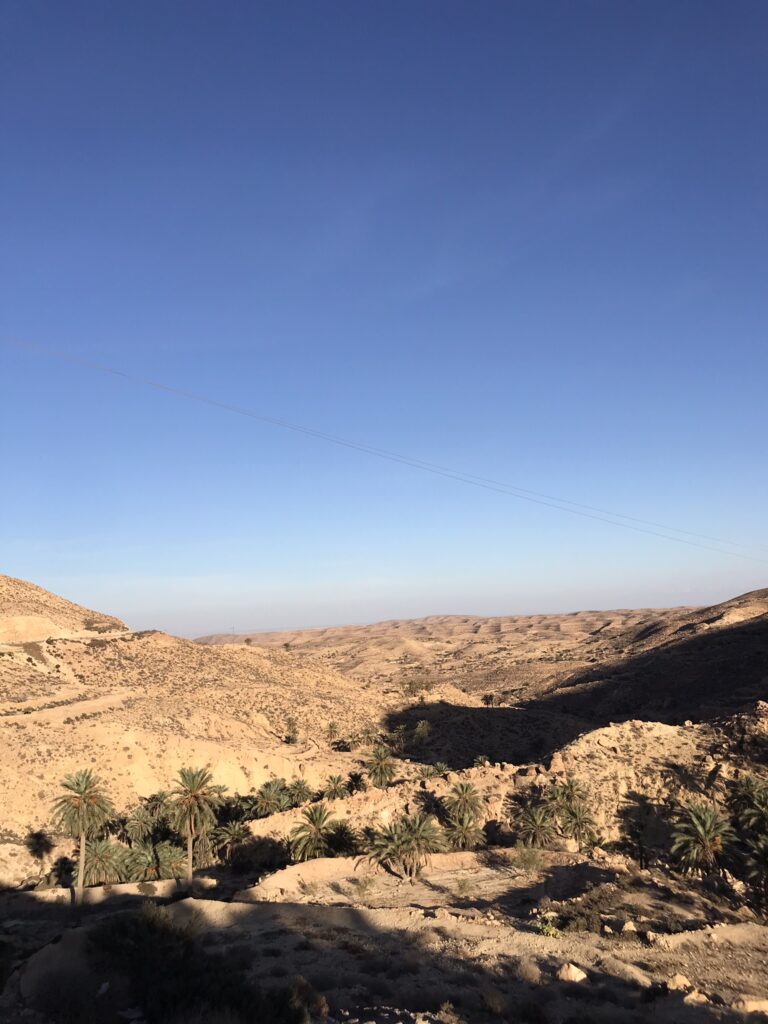
How to get there
We were coming from Djerba so took a louage from Houmt Souk to Gabes. From there it was a louage from Gabes to New (Nouvelle) Matmata (you need to transfer from the long-distance louage station to the local louage station in Gabes). There was then another louage from New Matmata to Old (Ancien) Matmata. From there on you’re on your own as there isn’t a louage service onwards to Toujane. We were very lucky in that when the driver of the louage to Old Matamata heard we were heading for Toujane he offered to give us a lift there for 60 TDN. We didn’t know if this was the going rate or we were being ripped off but with few options to reach Toujane, we accepted this offer. As it turned out we paid the same amount to a local guy in Toujane to take us back to Matmata when leaving, so we weren’t overcharged. Tunisia travel can be a leap of faith sometimes, at some points during our trip we had to trust in the kindness of strangers and this was one of those times. If you find yourself in the same situation I would recommend asking the louage driver or locals in Old Matmata if they can give you a lift or maybe, just maybe there might be a taxi.
Accommodation
Dar Fatma – A fantastic, authentic experience staying with a Berber family who own the Dar. We were welcomed with tea upon arrival and even though there was a language barrier we managed to communicate. We happened to visit when the English speaking guide/manager was away but we spoke to him on the phone and he welcomed us and checked if there was anything we needed help with. The view from the terrace at sunset was amazing, you can see right across the plains to the sea. The food prepared by the mama of the family was lovely and I highly recommend asking for dinner like we did. The rooms were modern, clean and perfect for us.

View from the terrace at Dar Fatma
Matmata
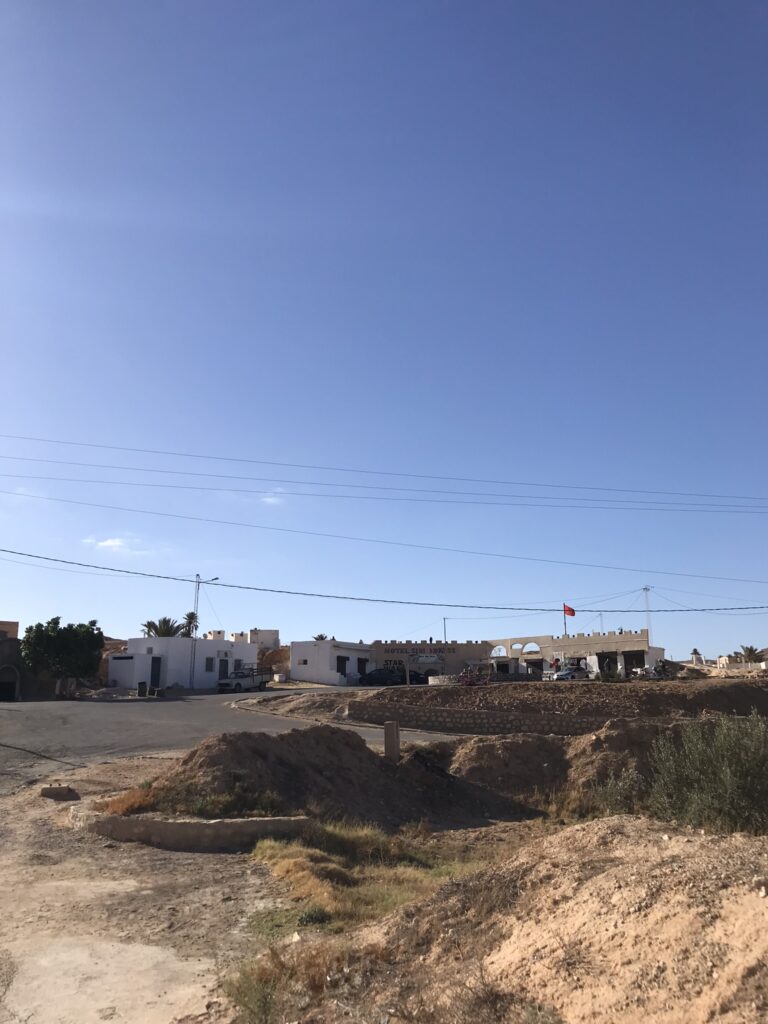
As close as we dared go to Hotel Sidi Idriss
Matmata is the mecca for Star Wars fans as it was the filming location for the home of Luke Skywalker, most Star Wars tours stop off in Old Matmata to allow tourists to gawk at Luke Skywalker’s house. This building has been turned into a hotel called Hotel Sidi Idriss. The reviews on Google aren’t very positive for this attraction so we gave it a wide berth. In Old Matmata locals on mopeds ride around town pestering tourists, touting tours; we were so put off by this we didn’t approach the house itself but opted to look from a distance as we were walking through the village to get a louage back to Gabes.
Douz
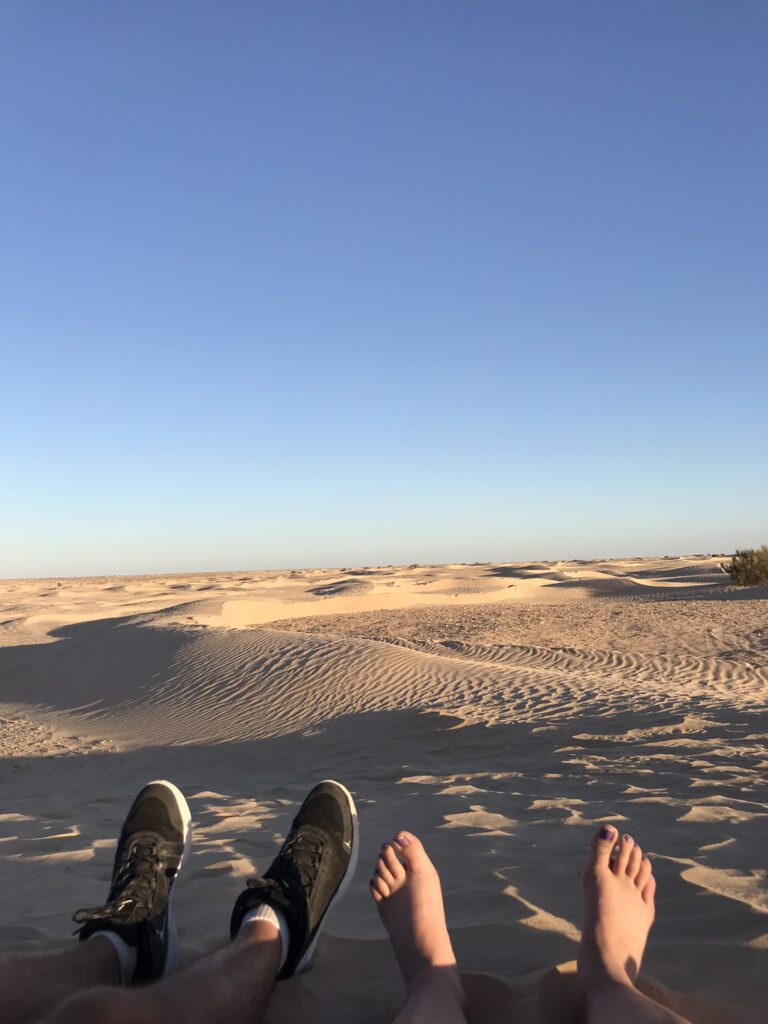
Chilling in the Sahara
A relic of a more decadent past. We got the feeling that Douz was once a popular tourist destination but now is in decline. We saw many derelict, deserted resorts on the walk from the louage station to our hotel. Perhaps these vast, desert-themed hotels are victims of the pandemic or maybe their decline was a steady train that had already left the station long ago. Hotel El Mouradi and Palm Beach are two of the last survivors of what seemed to be a once-thriving tourist hotspot in the last splutters of life. Even walking around the grand hotel El Mouradi, we got the impression that business wasn’t great from the handful of guests sitting in the lobby to use the wifi. Was this normal? I don’t know.
Douz is famed as being ‘the gateway to the Sahara Desert.’ You can even take photos with various gateways to demonstrate the name is well-deserved. Douz is separated into the ‘tourist zone’ located closest to the edge of the desert and the city where most residents live and work. We spent the night in Douz on our way to Tozeur, we took a louage to Douz from Gabes after visiting Toujane via Old and then New Matmata.
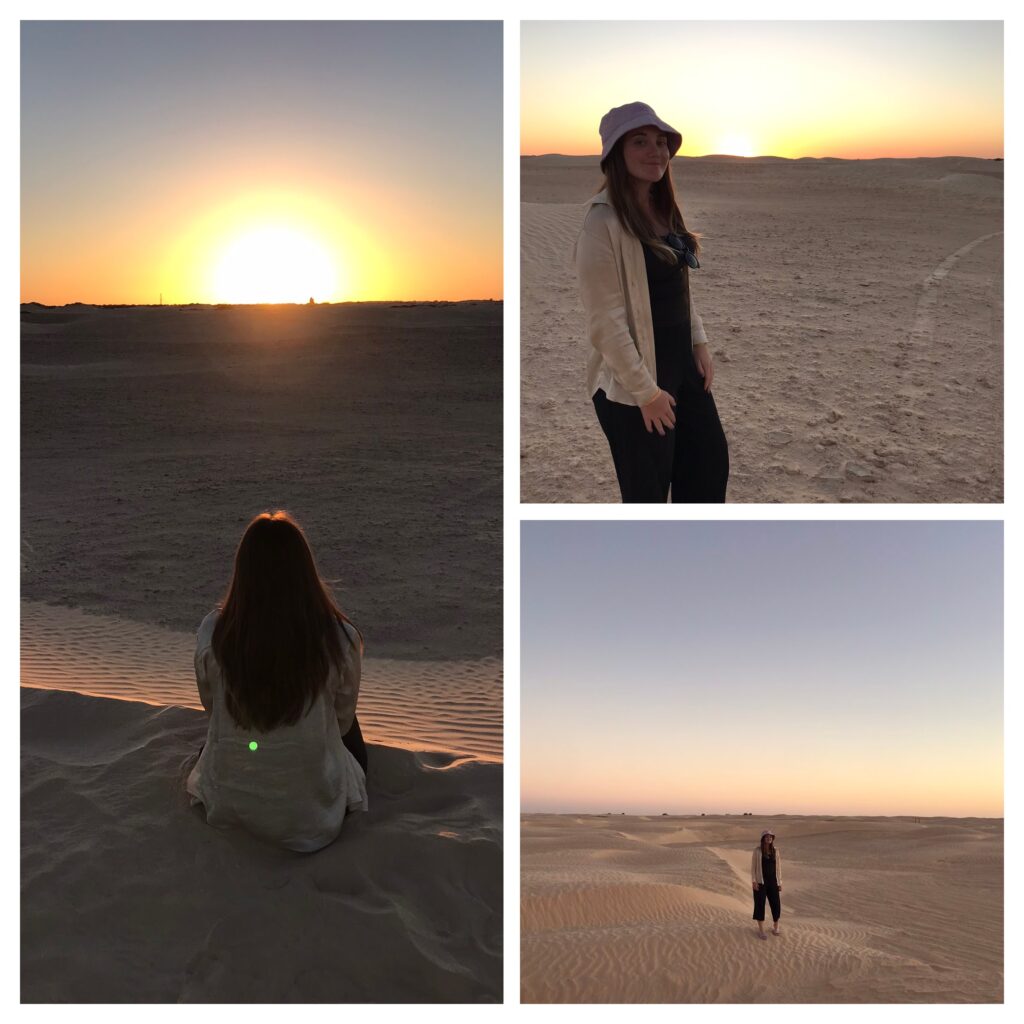
Activities
You can take part in various desert themed activities such as quad biking, camel trekking or choose to stay in a nomadic desert camp on the outskirts of the Sahara Desert. In the interests of saving money, we opted to go on our own adventure trek into the desert to watch the sunset over the sand dunes. Whilst I wouldn’t usually recommend walking into the desert without any food or water, that’s exactly what we did. We walked in the same direction for about an hour to reach the more pristine, untouched sand dunes. The sand dunes closest to the hotels are sadly covered with litter and used by tour companies for quad biking excursions so we avoided this area and headed further into the desert instead.
Accommodation
Hotel El Mouradi – The entrance hall/reception area is very grand when you first arrive. The rooms are a tad dated but if you can move past that, they have everything you need for a comfortable night’s rest. The breakfast buffet is nice, the pastries were especially great. The WiFi is only in the reception area but works well when you’re there. Overall a nice stay.
The hotel is also literally next to the Sahara Desert, as mentioned we just walked from here into the desert for a while.
Foodie Places
Cafe Nomade – we decided to have dinner at Cafe Nomade to avoid paying for the buffet at El Mouradi (a whopping £15 each), it was a simple, basic meal of Pizza Arabe or Arabic pizza, essentially calzone with a spicy tomato sauce, the owner is very friendly and the meal was surprisingly good but most importantly it was very cheap.
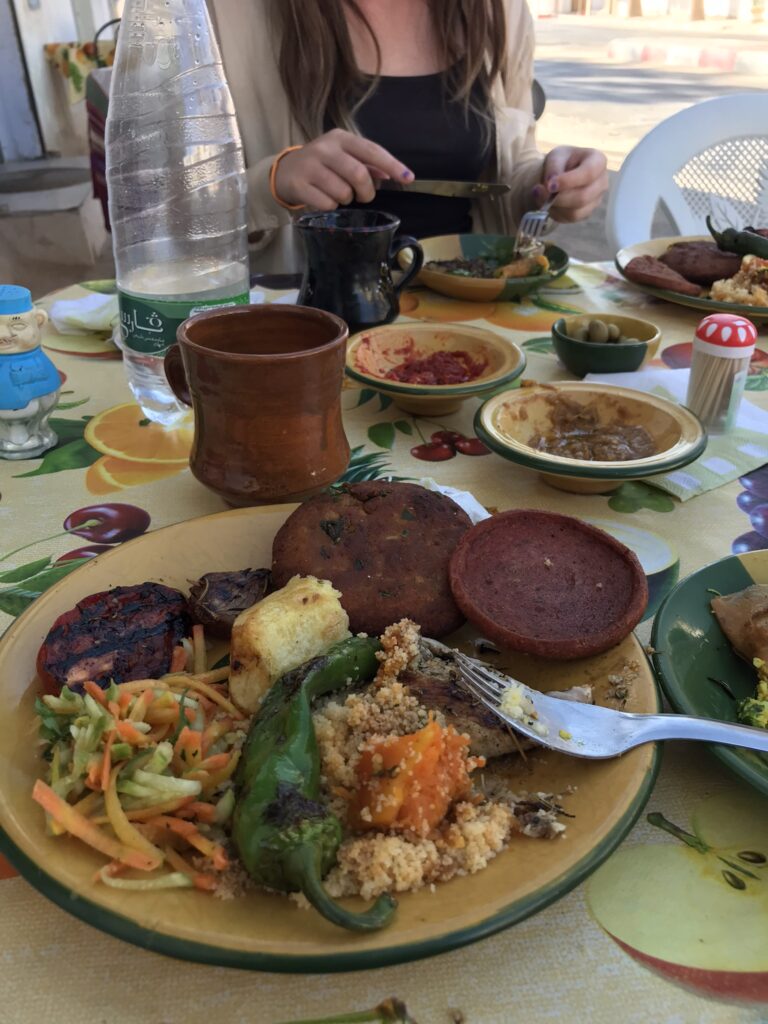
Fantastic set lunch deals at Restaurant La Porte De Sahara
Restaurant La Porte De Sahara – if sitting in plastic chairs by the side of the road is up your street, then you’ve hit the jackpot. This restaurant serves very tasty traditional Tunisian fare with a set menu, the owner was very friendly and we enjoyed every course of the three course meal!
Tozeur
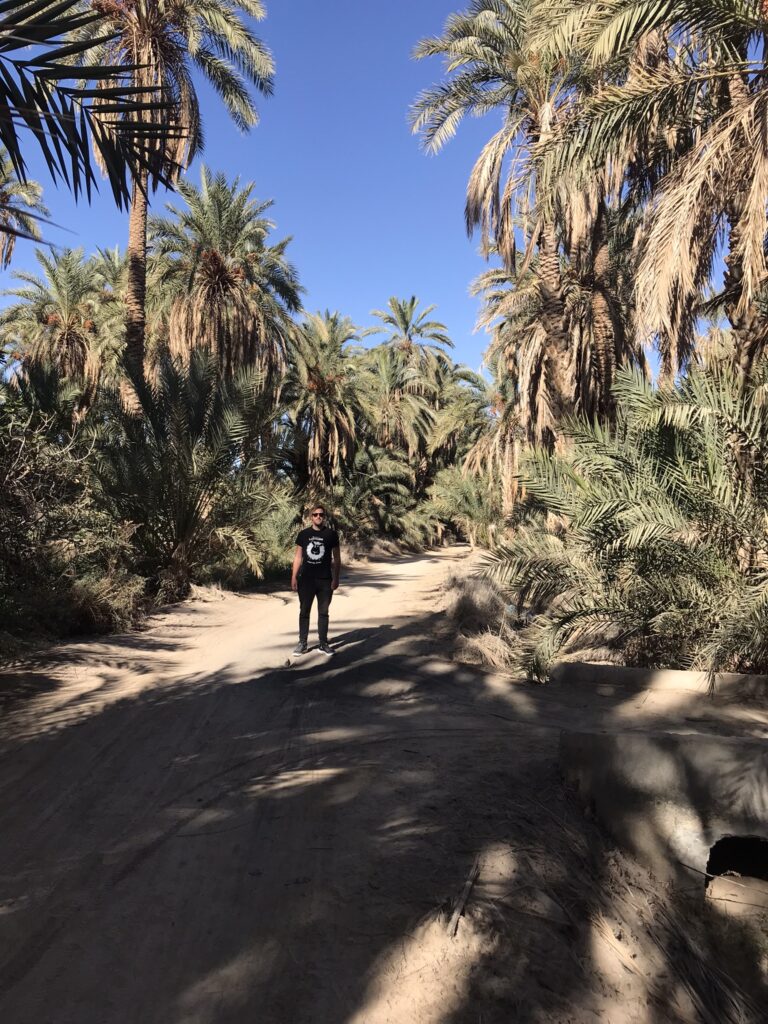
A desert oasis brimming with date palm plantations. We found Tozeur was slightly different from the rest of Tunisia. For one, the architectural style is different and there is also a strong Berber influence, which is understandable given the city’s location and proximity to the Algerian border. Despite seemingly not having too many foreign visitors, Tozeur was also strangely touristic, with men on horse-drawn chariots in the streets hustling passers-by for a ride.
When the louage system fails; the one and only time we experienced this.
We had a slight hiccup trying to reach Tozeur from Douz. Although distance-wise they’re quite close, getting from one to the other wasn’t as easy as we initially thought. We’d hoped that it was possible to get a direct louage from Douz to Tozeur, however when we arrived at 10:30am we were told this was not possible and that we’d have to travel to Qibili and catch another louage to Tozeur. We’re not sure if we just missed the last louage directly to Tozeur or if this service was no longer running. We’d worked out by asking around that we needed to go from the local louage station where we had been dropped off in Qibili to another louage station (33.716988897633435, 8.974434264281692) to get to Tozeur. So there we were, standing for over 2 hours at the side of the main road through Tozeur as louage after louage filled with passengers for other cities like Gabes and Gafsa and no sign of the louage to Tozeur. As each red-striped louage pulled into the station, we’d rush over and ask where they were going to no avail. Eventually two local women on a moped told us that we needed to request the louage by calling the driver, we had no idea we needed to do this but they called a driver on our behalf. After another 30 minute wait by the side of the road, a louage for Tozeur finally appeared and we boarded the vehicle. We hoped we’d set off soon, but no such luck. Another passenger who spoke some English told us that the route wasn’t popular and the service was very irregular and non-existent on some days. With one seat left to fill, it was decided that we’d all chip in and pay for the extra seat so we could set off. Thanks again to the kindness of strangers we were back on the road! The drive from Qibili to Tozeur passed through the Chott el Djerid, a large salt flat, so it was an interesting and scenic journey.
Accommodation
Résidence Le Ruisseau – a comfortable hotel opposite the louage station, it’s surprisingly peaceful at night which is strange as it’s right next to a very busy road and thoroughfare. There’s a large Carrefour supermarket across the road too which is convenient. The receptionist spoke very good English which took us by surprise as well! We booked our half-day tour through the hotel and we didn’t have any problems, if anything the price was better than those provided by other tour companies.
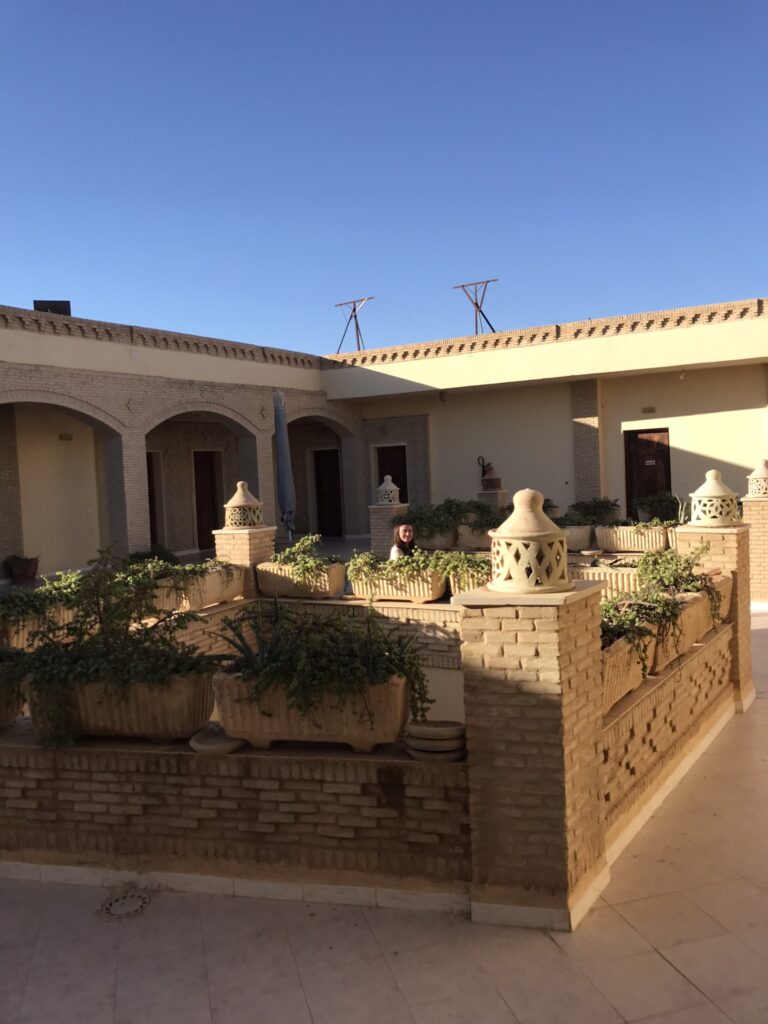
On the roof at La Ruisseau
Foodie Places
Restaurant Soleil – This was more of a touristy place to eat, I know this because the couscous wasn’t spicy and I could barely taste the heat of the harissa. It’s more of a sit-down restaurant and an okay place to grab some dinner if you’re in town.
Scoop Café-Resto – this became our go-to place to eat, with pasta, french tacos, burgers, panini, breakfast deals, ojja and pizza on the menu. It’s what I would term a hipster cafe with a painted bicycle and glossy signs on the terrace. The portions are big, the quality excellent and the price even better!
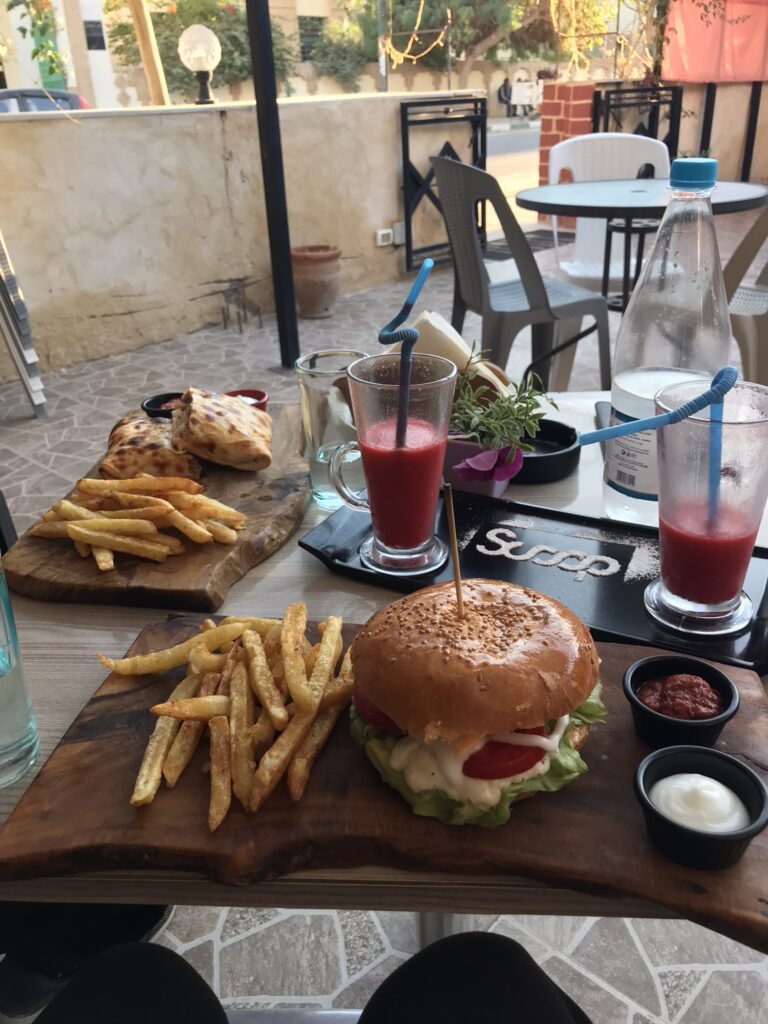
Getting the scoop at Scoop!
Cafe Berber – My number one recommendation for a place to grab a coffee or tea in the medina. The rooftop is exquisitely decorated with local arts and crafts, traditional berber throws cover the chairs creating a warm, cozy atmosphere. You have to try the date milkshake (it’s called a jus on the menu); it’s to die for!
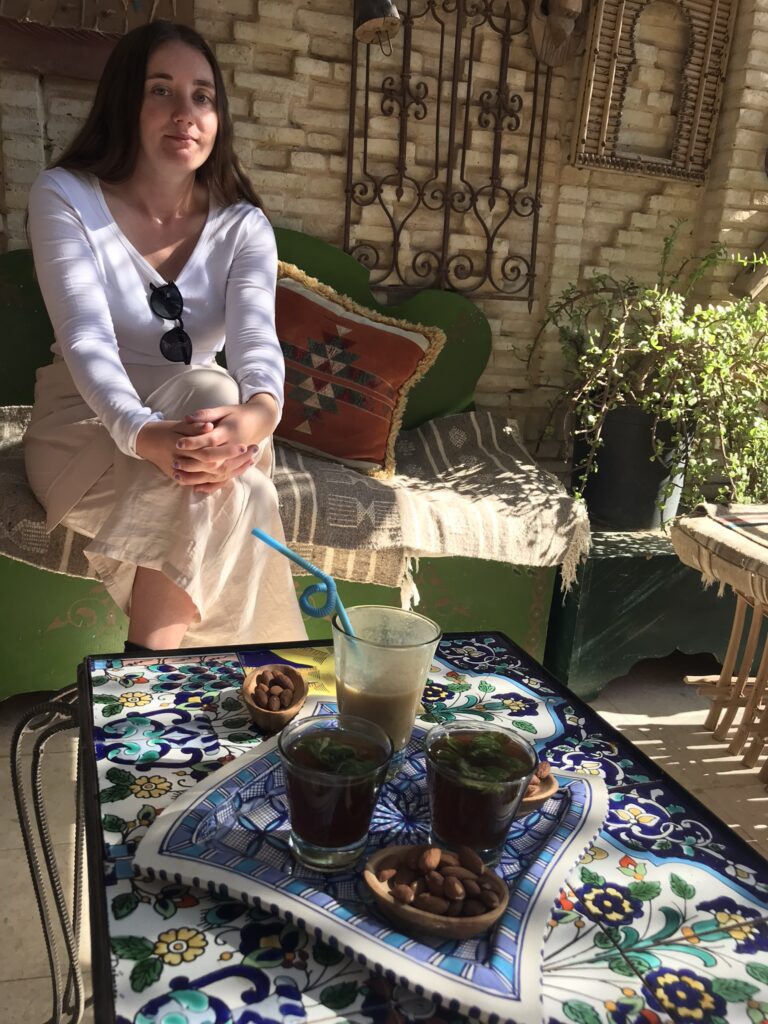
Cafe Berber is the perfect place to stop for tea or even date milkshake
Activities
Half day tour to Chebika waterfall, Mides canyon and Tamaqzah waterfall:
In an ideal world visiting these sites with your own vehicle would be the best option. However, if you’re like us and don’t have access to a car, the only way to visit these places is by joining a group or private tour. Some parts of the road are patchy and uneven, especially on the way to Tamaqzah waterfall; I would recommend against driving a low-riding car there or parking slightly further away and walking the rest of the way to the waterfall. There are a couple of things that need to be mentioned about the tour we went on, firstly the driver who we initially thought was the tour guide didn’t speak very much English and could only tell us the place name of where we were, this wasn’t great as we’d hoped to find out more about the history and culture of the area. Secondly the driver wasn’t a tour guide at all, he didn’t go with us to the waterfalls or canyon, he waited by the car instead. This led to an awkward and slightly uncomfortable situation whereby we were dropped near Chebika waterfall and a local immediately told us he would be our guide, it took a few seconds to realise this was just a local man offering to be our guide for a fee. We swiftly declined and tried to walk past the man in question only to be badgered about how cheap his services were. This was just our experience with the company we booked with, it might be different with other companies. You definitely don’t need a guide to get from the car park to the waterfall itself as it’s a well trodden circular trail, first to the waterfall and beyond to the pool (keep an eye out for the frogs and tadpoles in the pool) and then upwards to the crest of the hill and through the deserted village. However, in hindsight it’s definitely a positive thing to do. By paying for a local guide, it provides jobs for the locals, supports the local economy of Chebika and they may provide some local insight and information we missed. As we hadn’t expected this extra cost we didn’t do this especially after forking out £45 each for the non-tour guide driver. You can also expect many stalls along the route selling the usual tourist tat and some slightly-odd souvenirs such as amethyst and fossilized wood. It was clear to us that the locals heavily relied on tourism as their bread and butter. I won’t forget the stall-holders shouting at us ‘1 denar’ as we left. I’m not sure what they were selling for so little money but it was obvious that they were slightly desperate to sell something, anything really.
Mides canyon is very easy to reach from the car park, no guide necessary, and the viewpoint provides breaktaking views of the incredible canyon. It’s again very easy to navigate from the car park to Tamaqzah waterfall. We weren’t approached by guides at either Mides canyon or Tamaqzah waterfall to our relief.
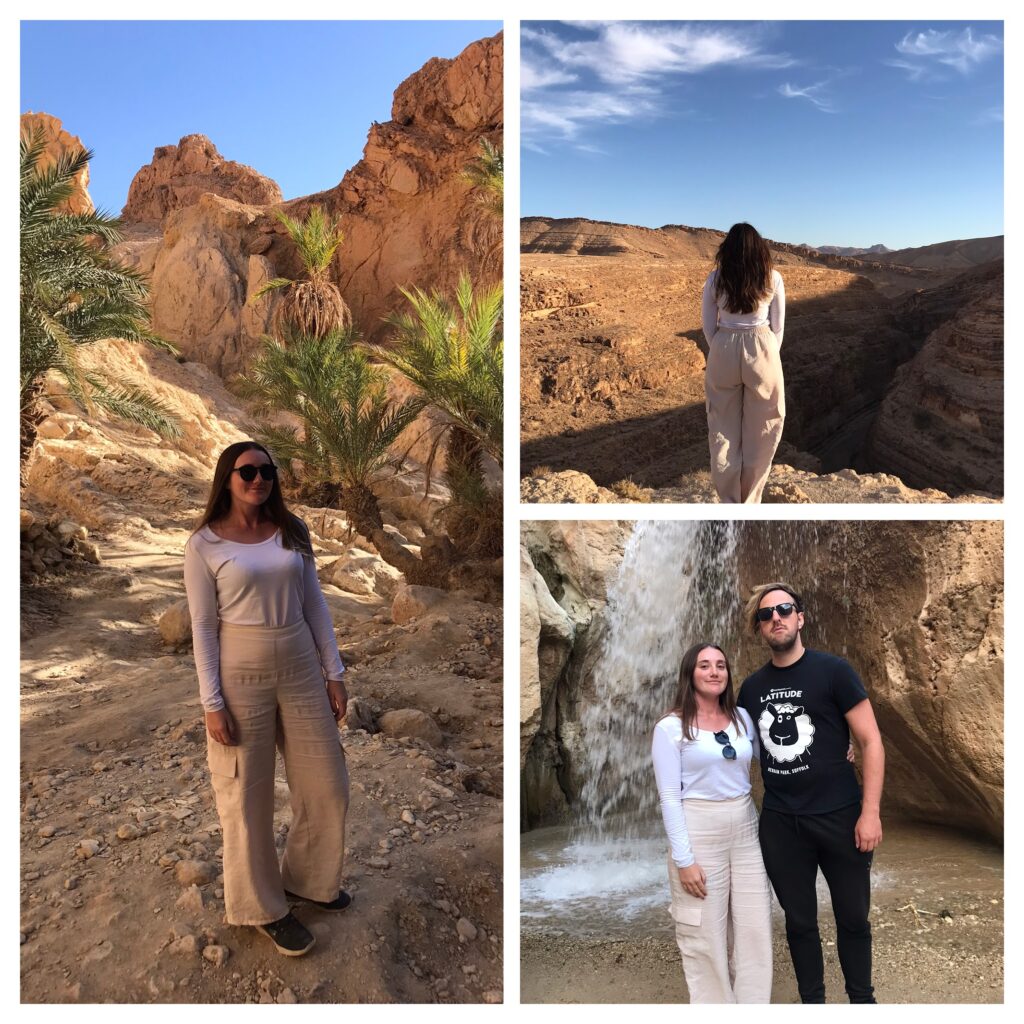
The drive to and from Tozeur to this area was spectacular in itself, passing through the flat land into the mountains.
Medina – this medina was different to any other we’d seen, the sandy colour of the bricks and flouncy brickwork on the buildings attested to a different architectural style than can be found in most other medinas.
Date Palm Plantation – leaving the medina, you can stroll along a dirt track through a large date palm plantation or ‘palmeraie’, from the hustle and bustle of the city the serenity and quiet of the plantation is a welcome relief. The sunlight peeking through the palm leaves provides ample photo ops.
For my self-guided walking tour of Tozeur, click here!
